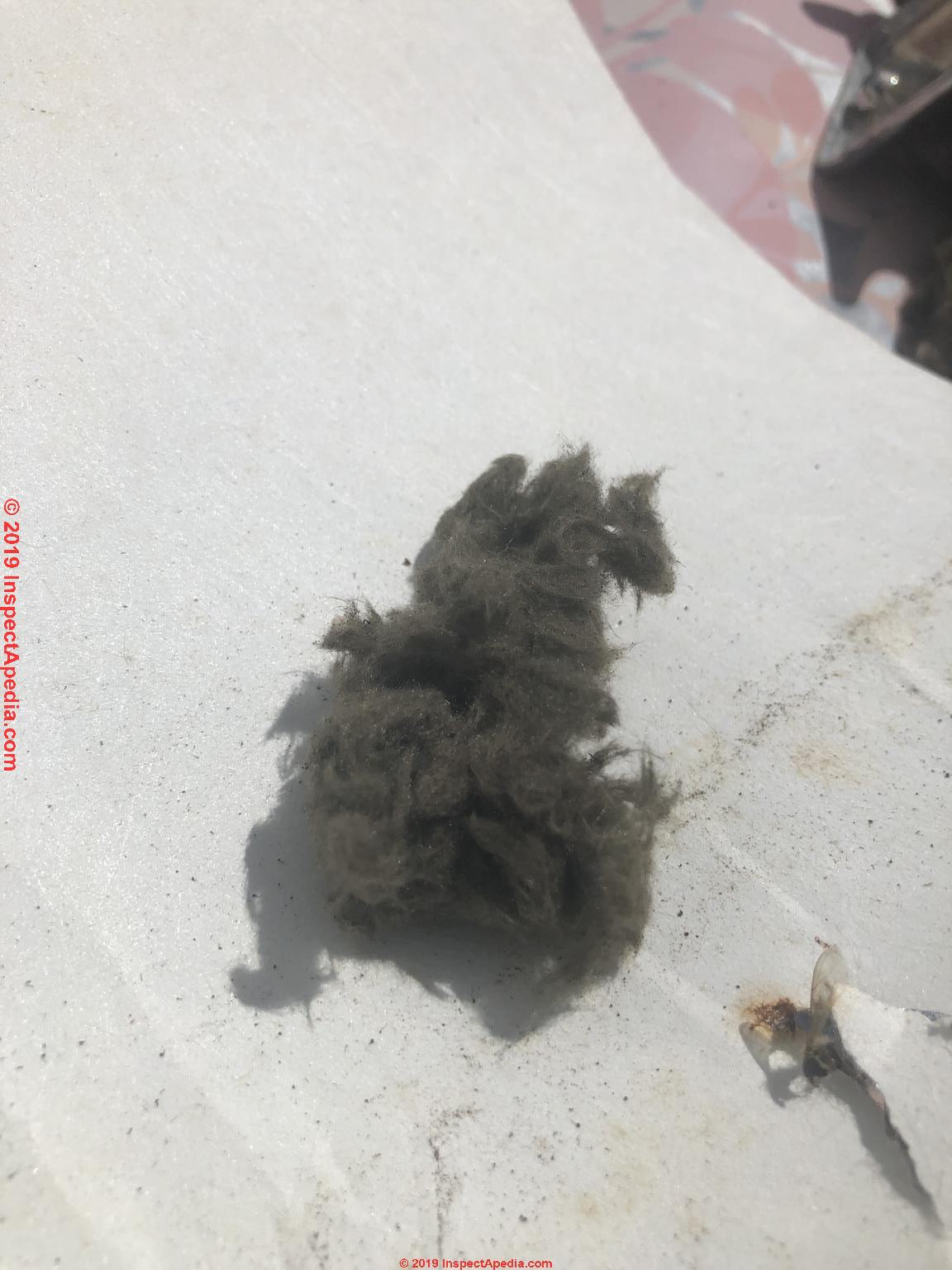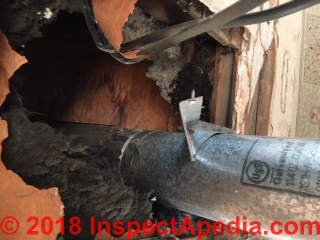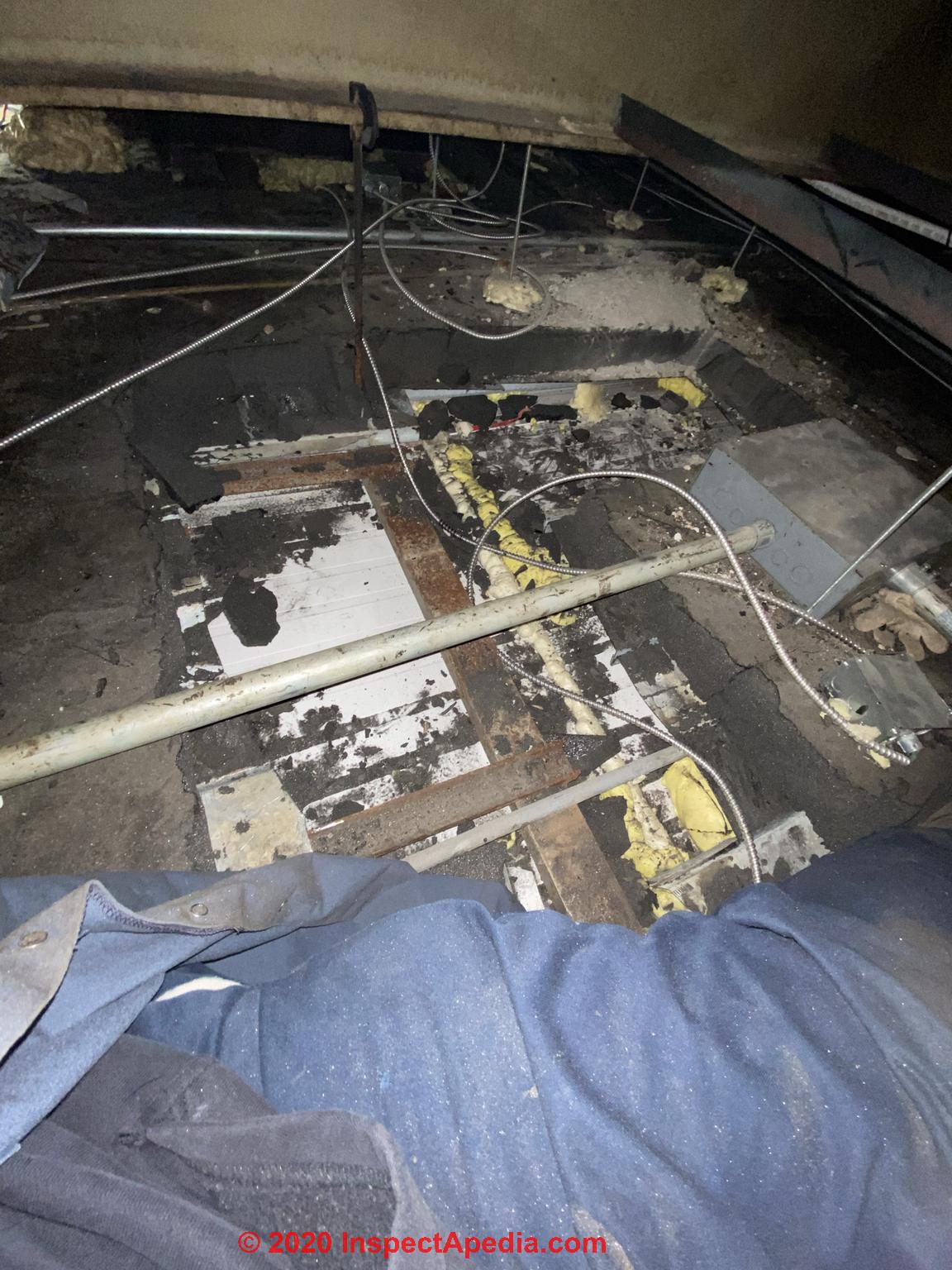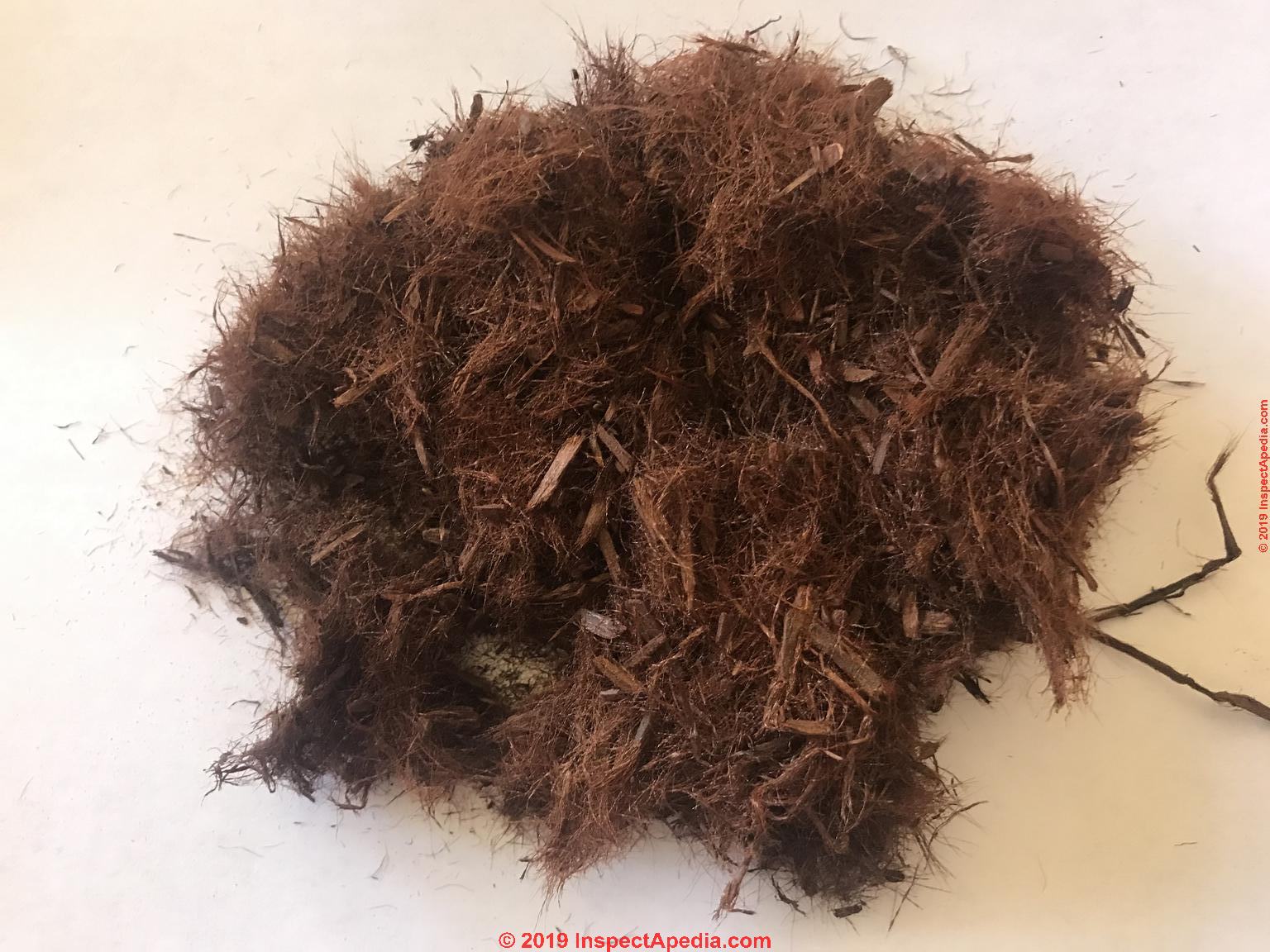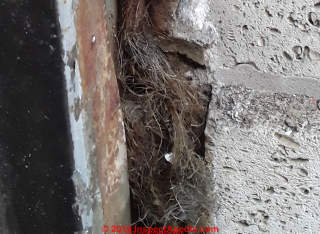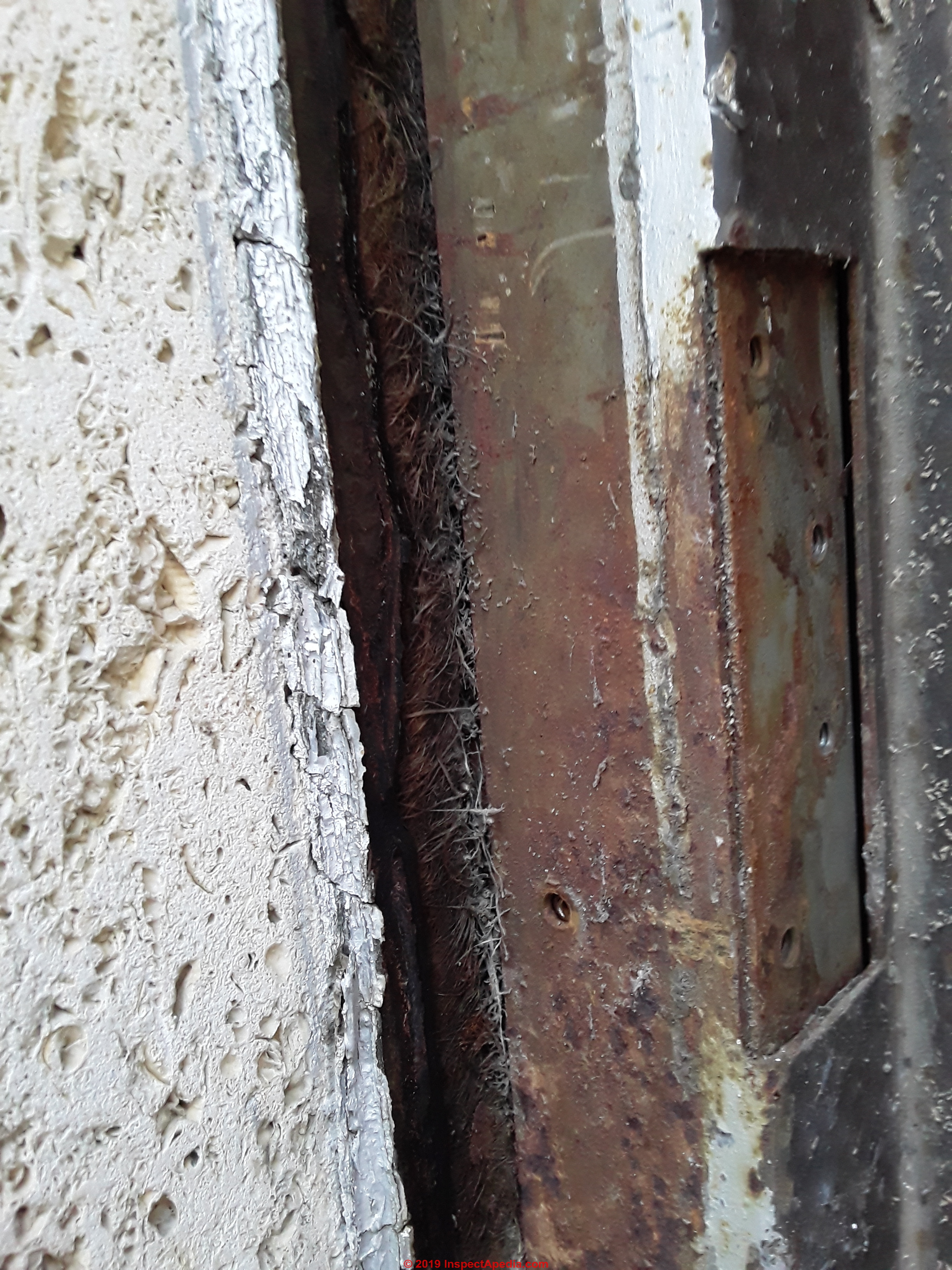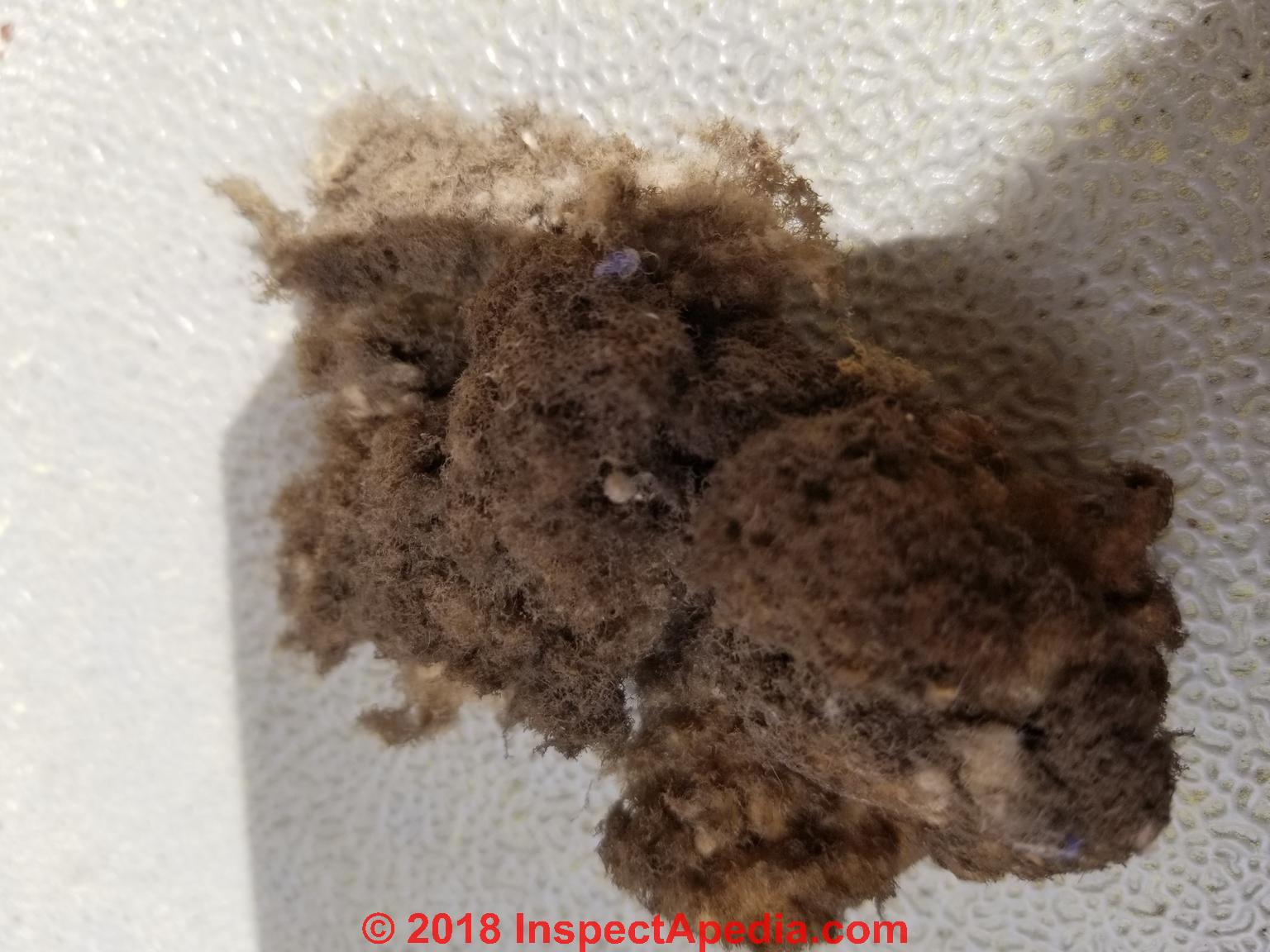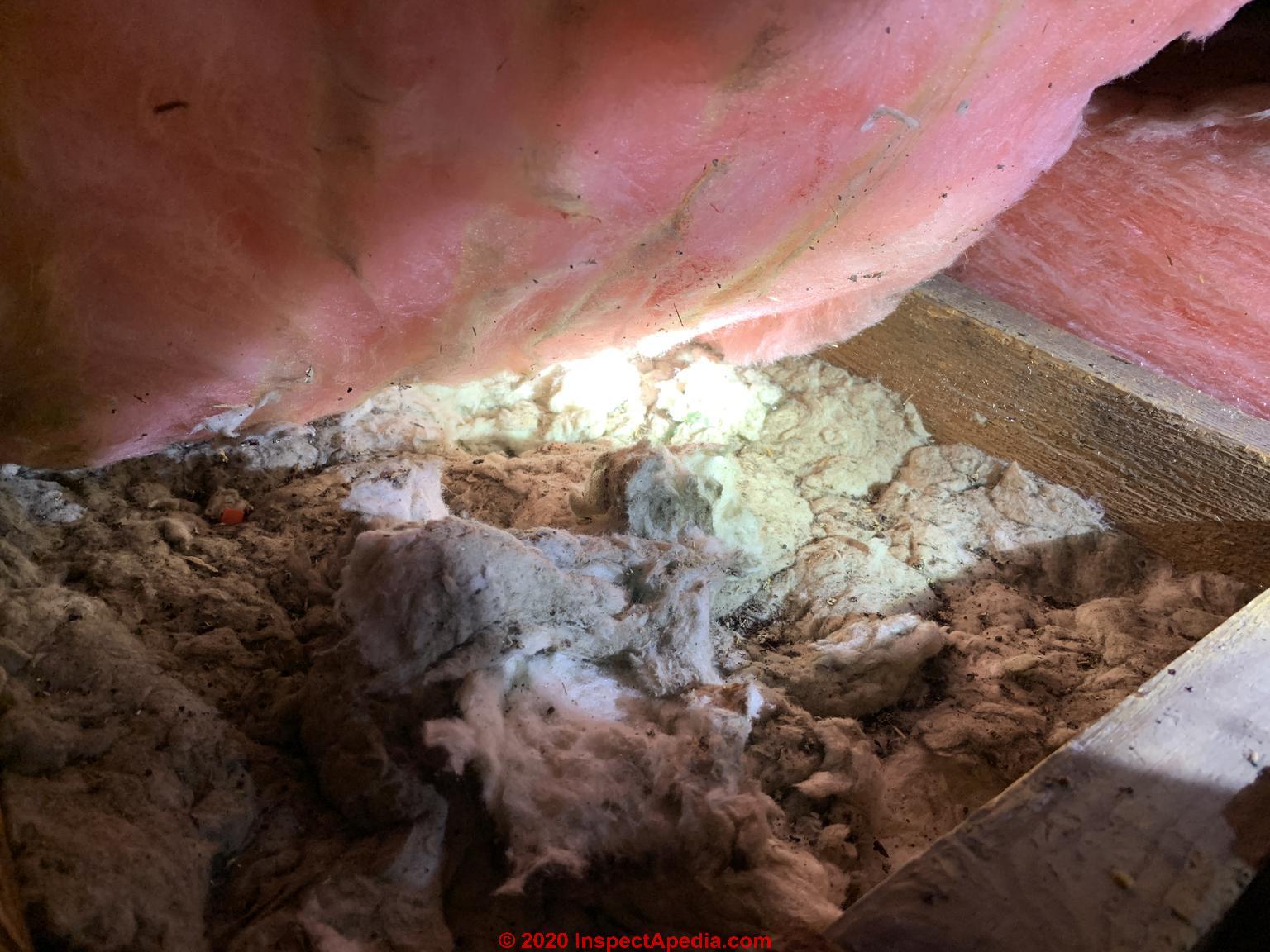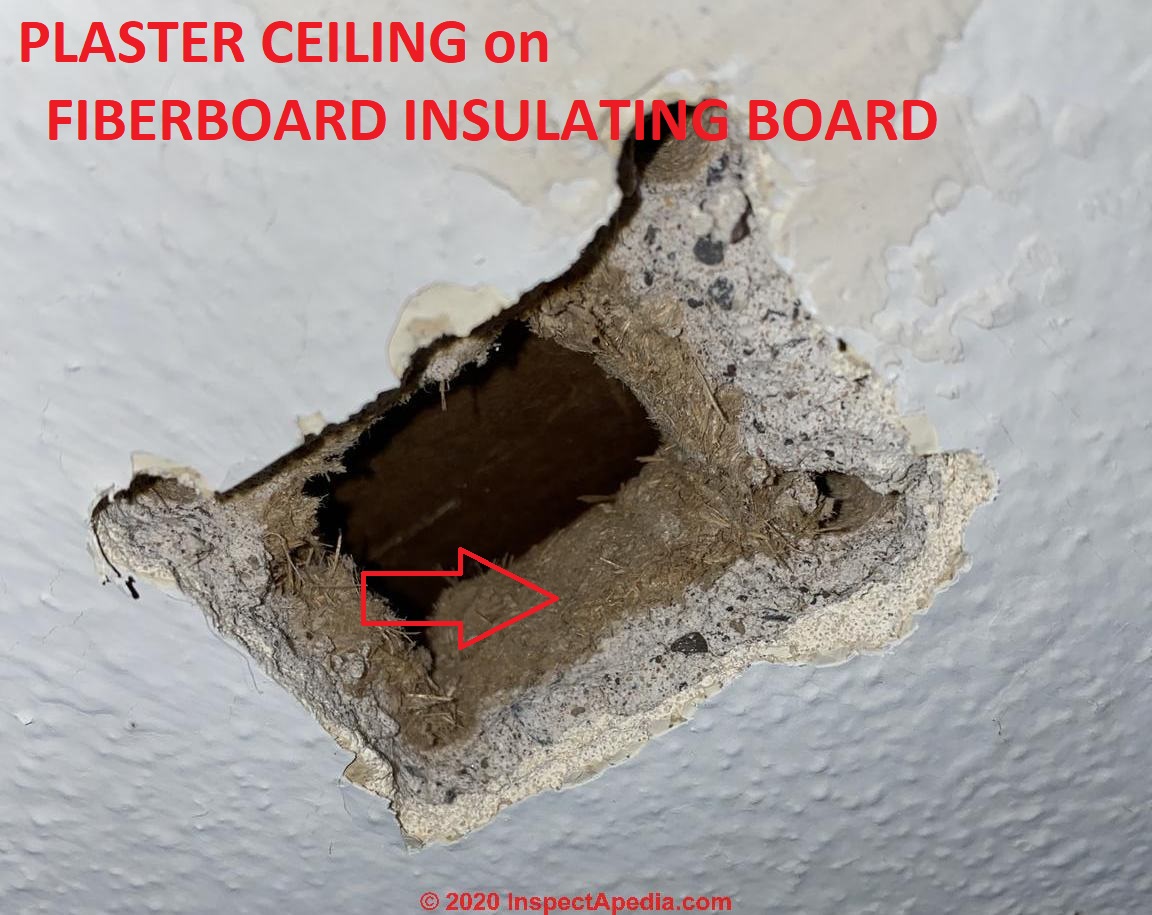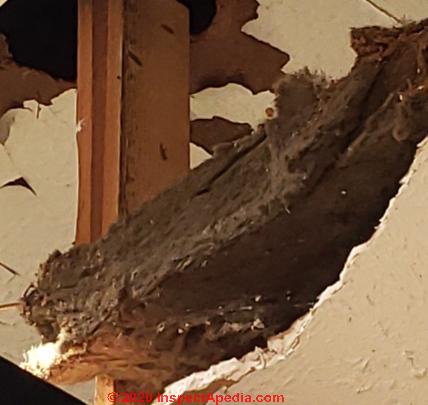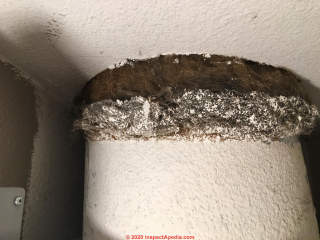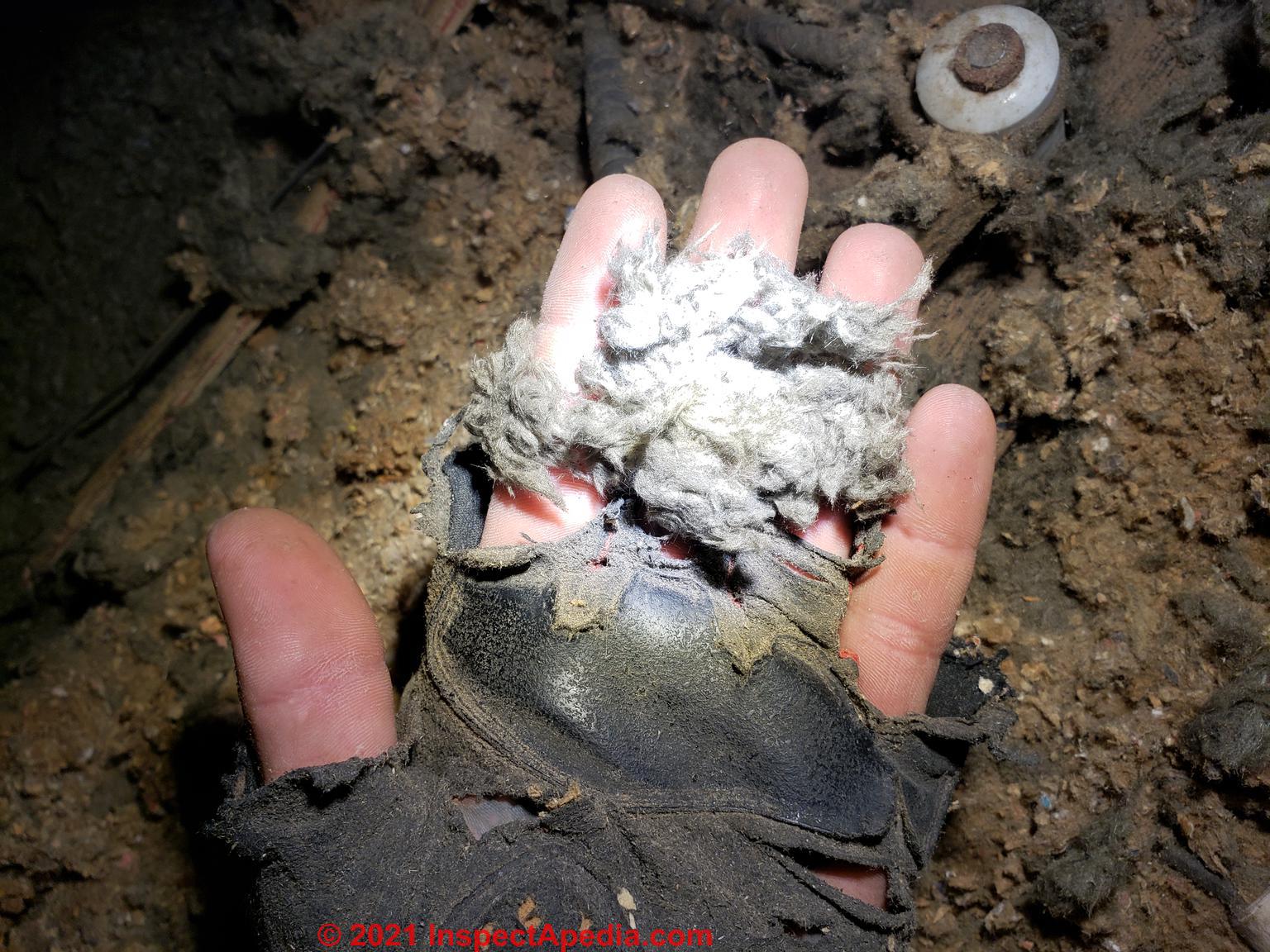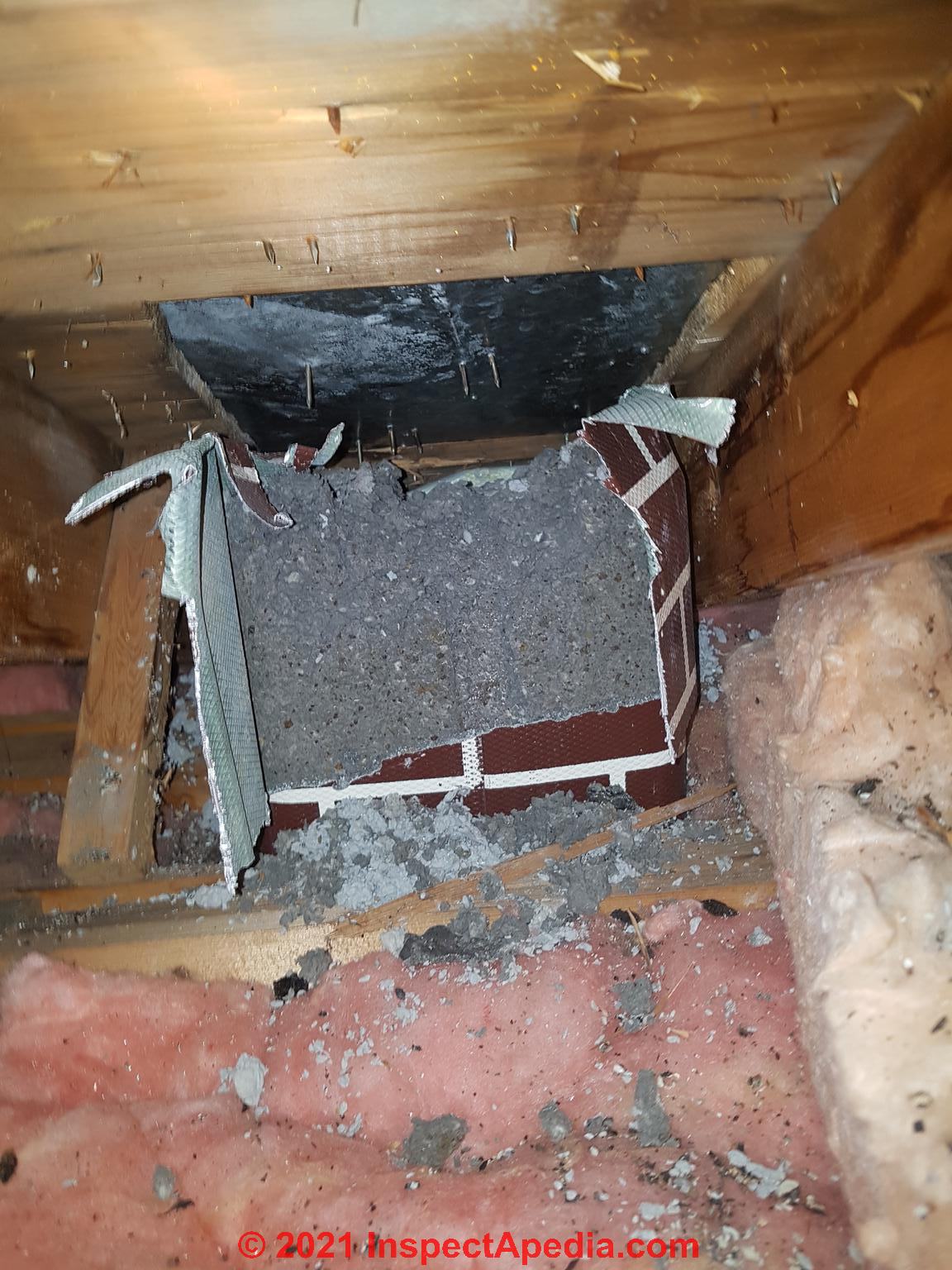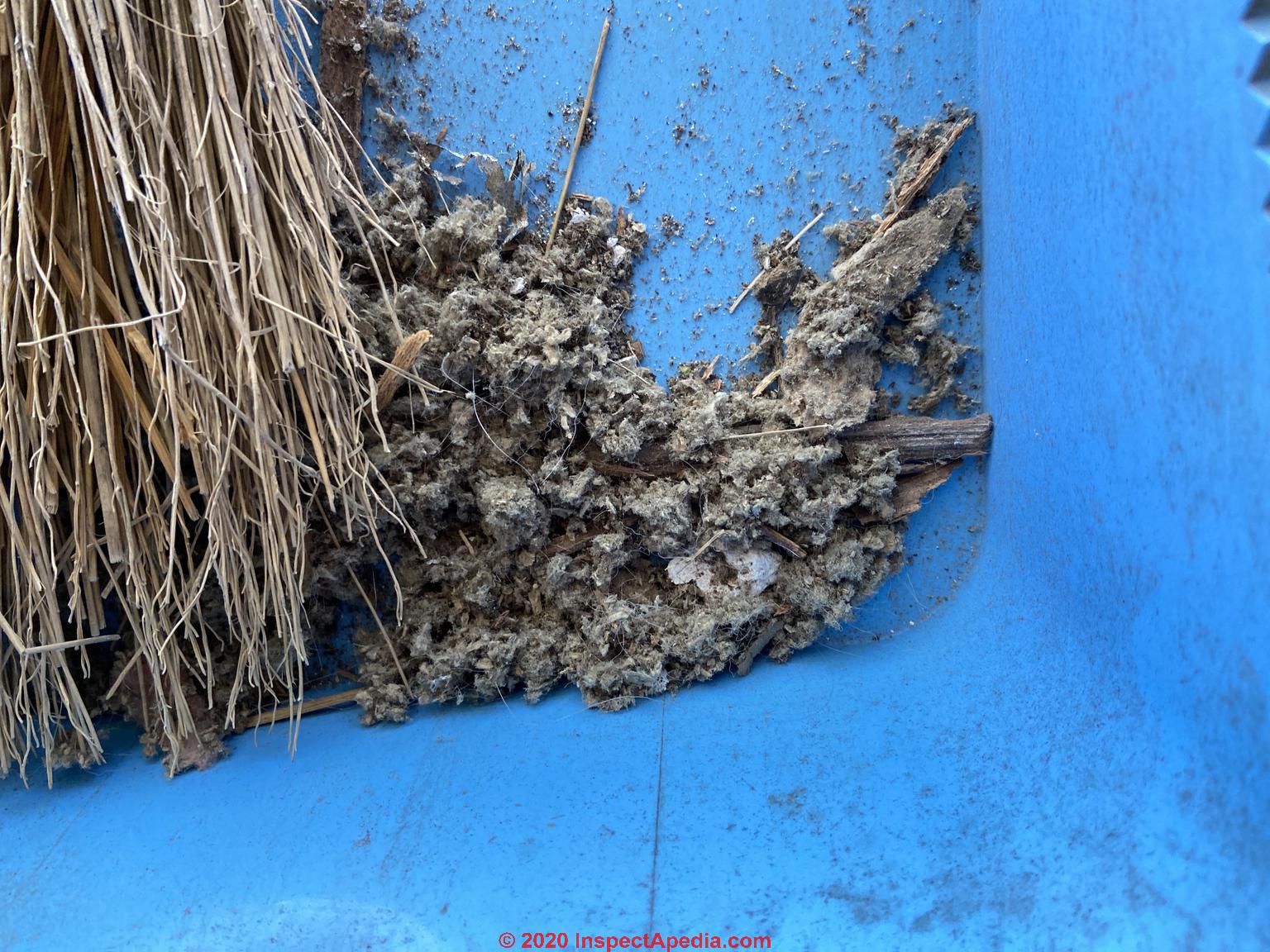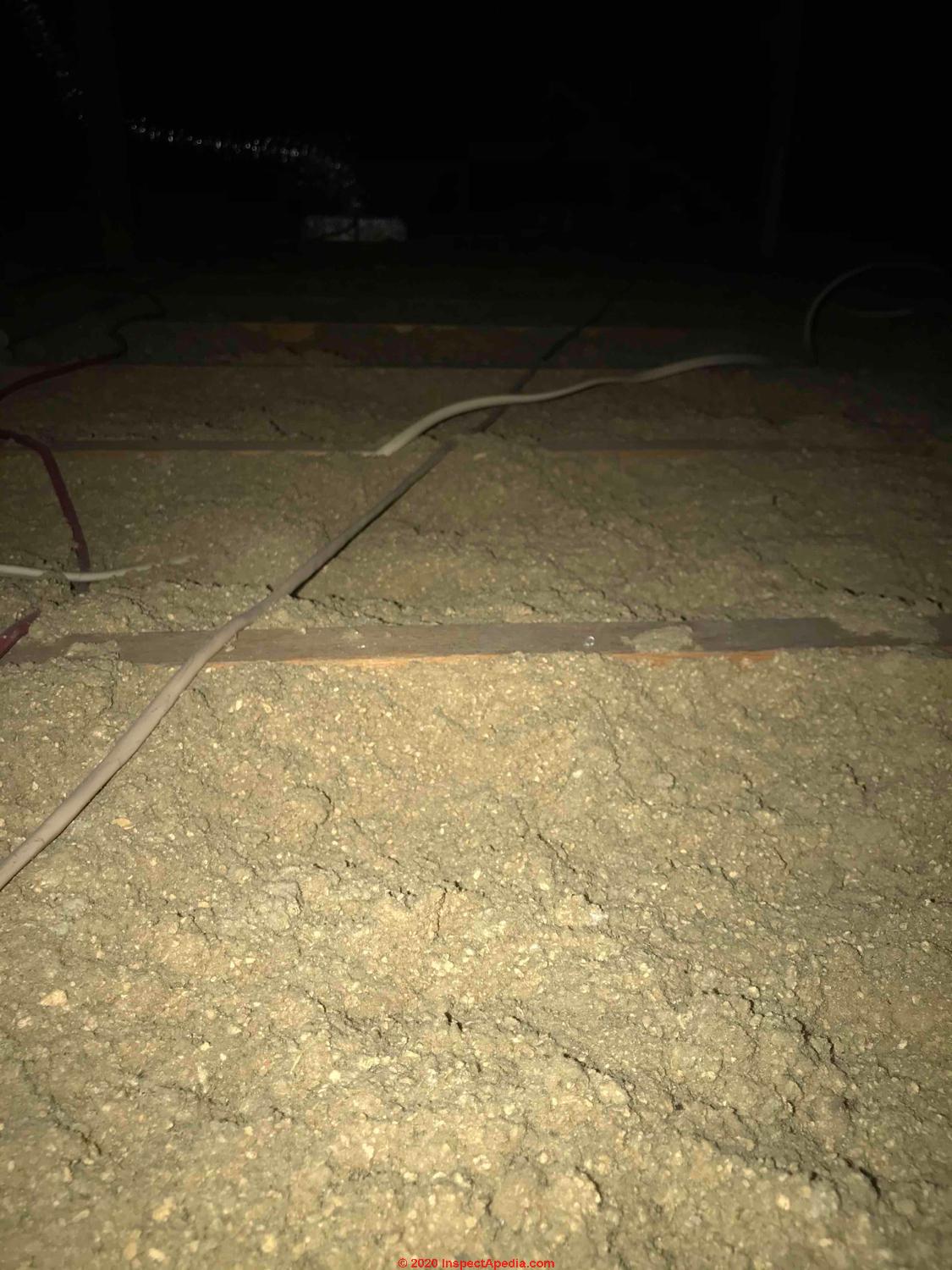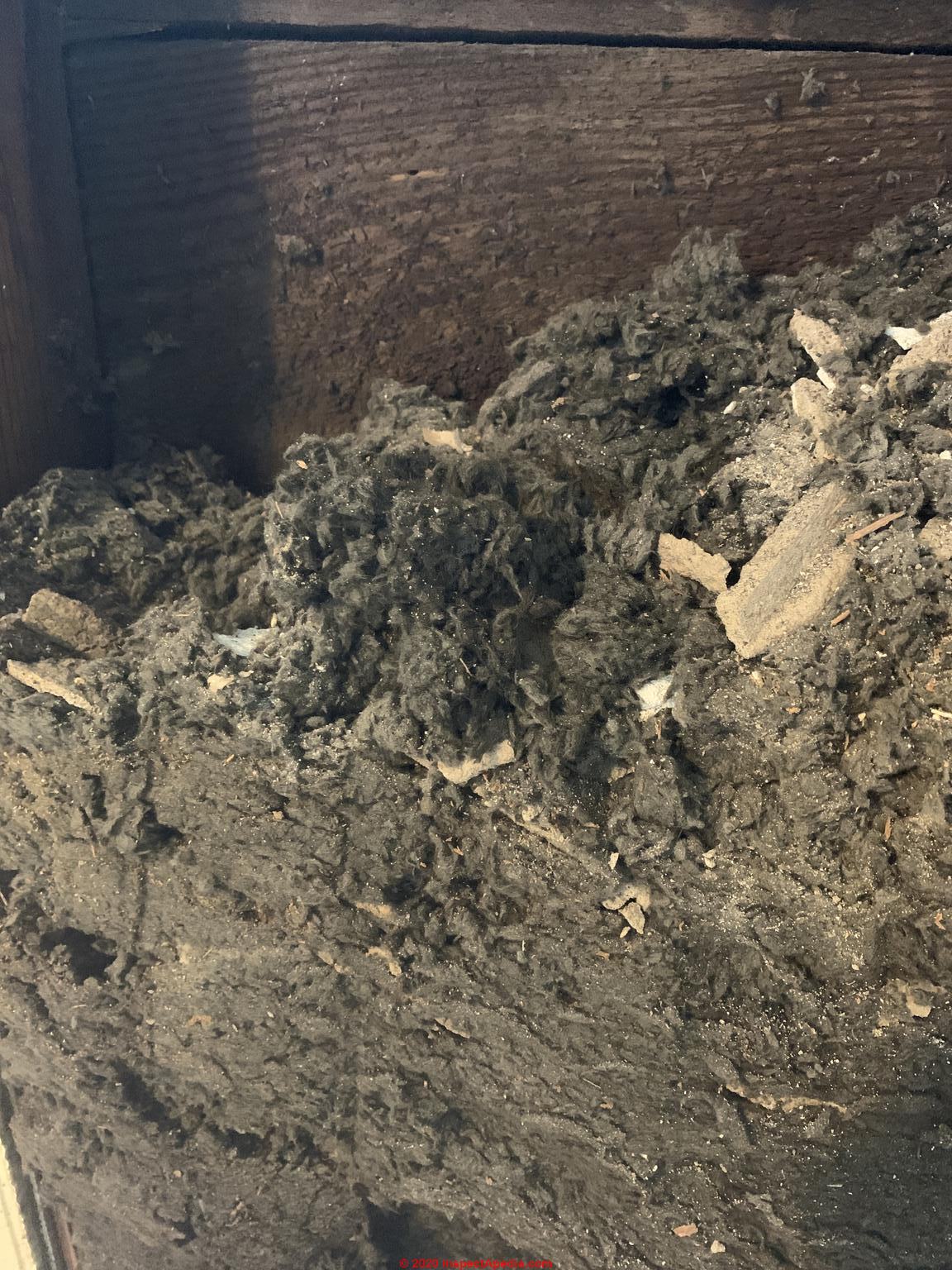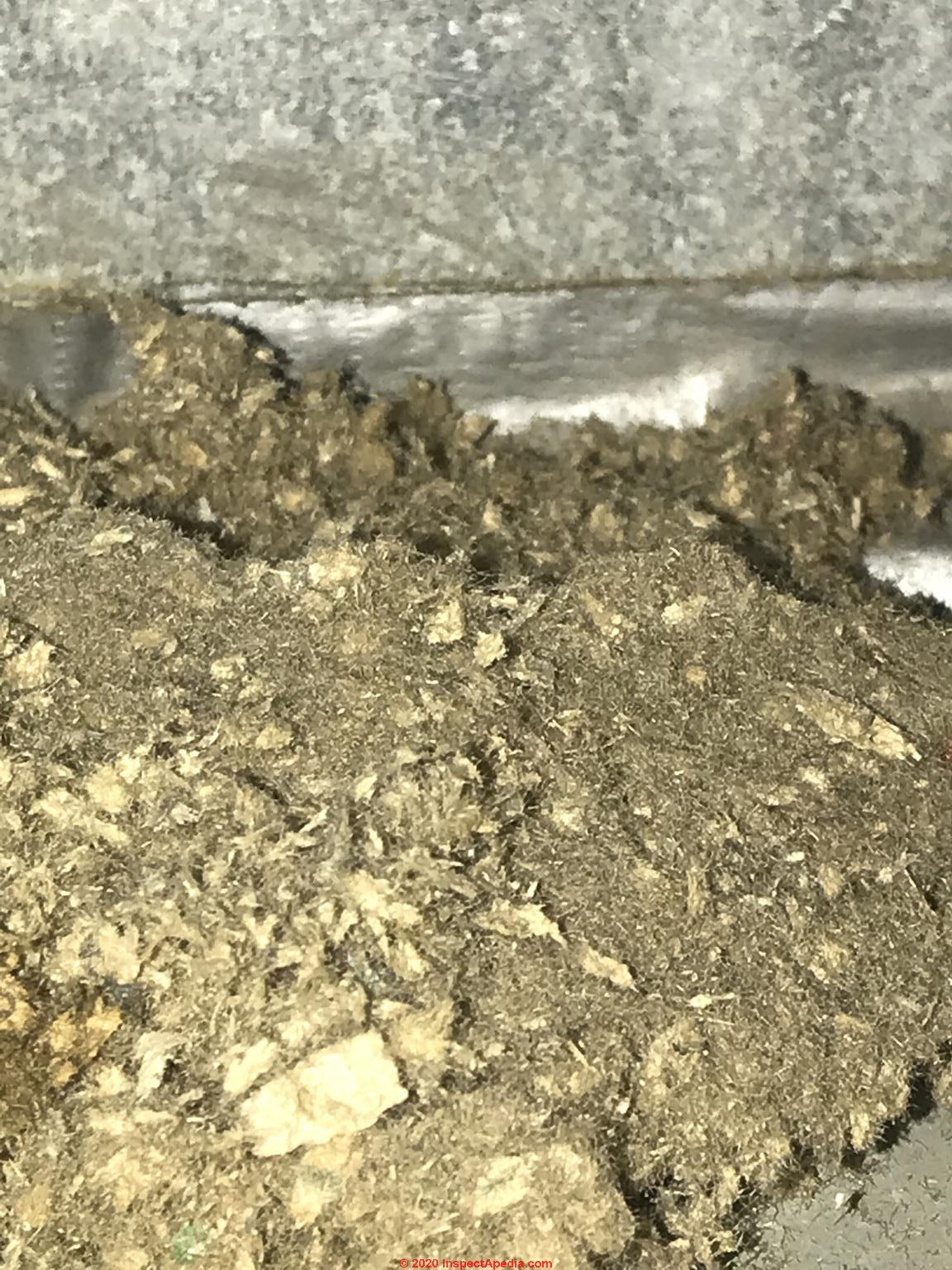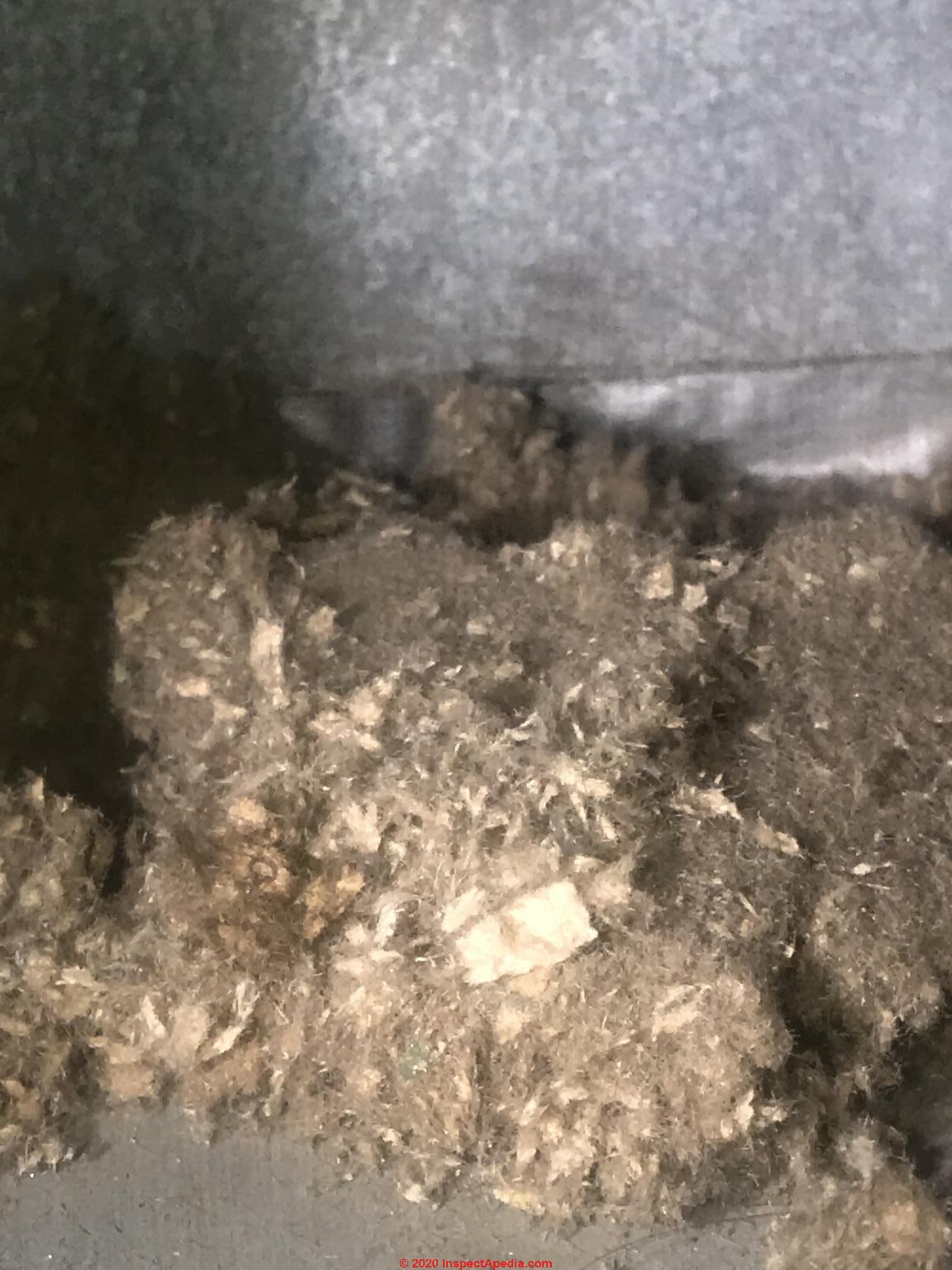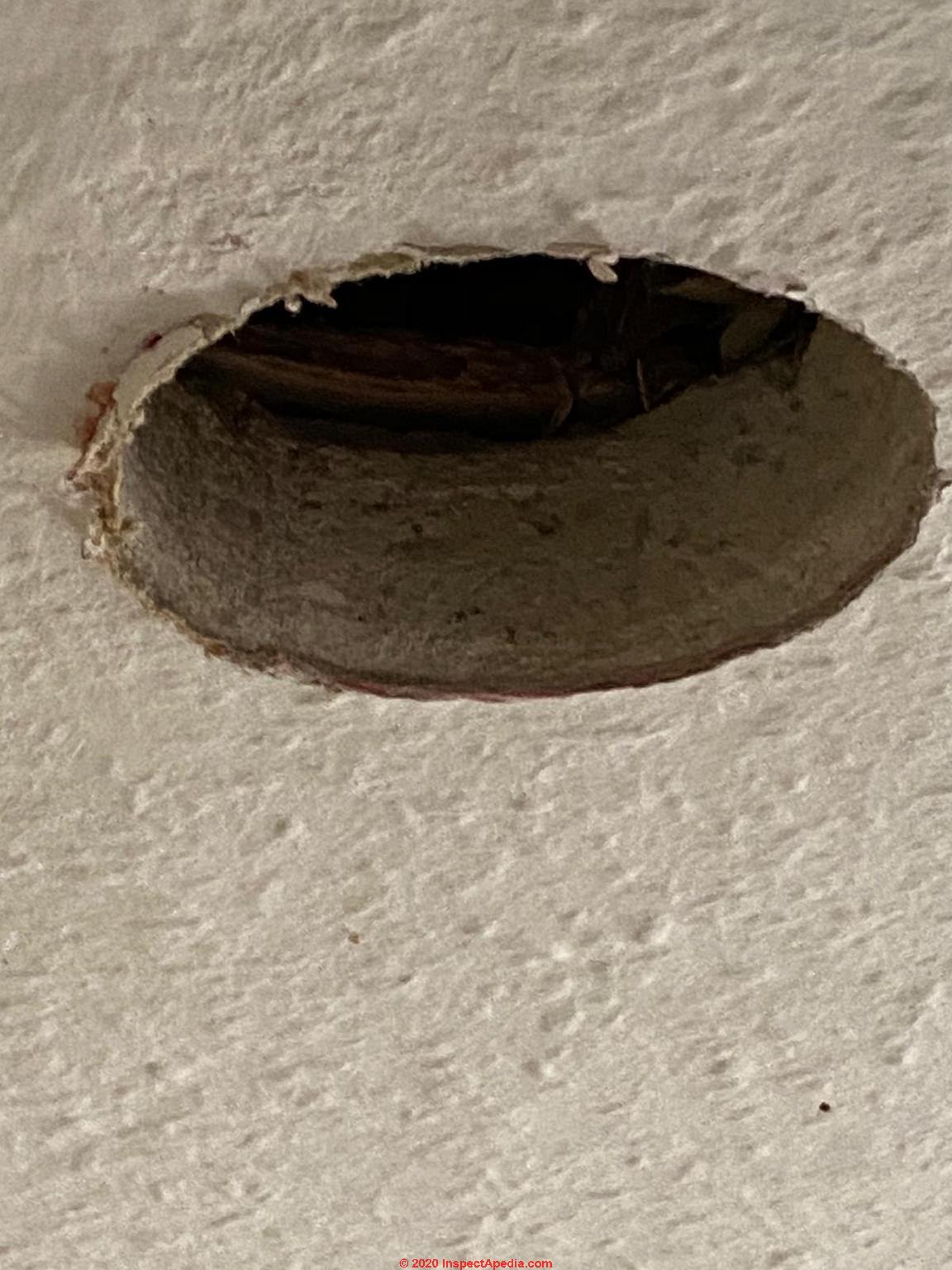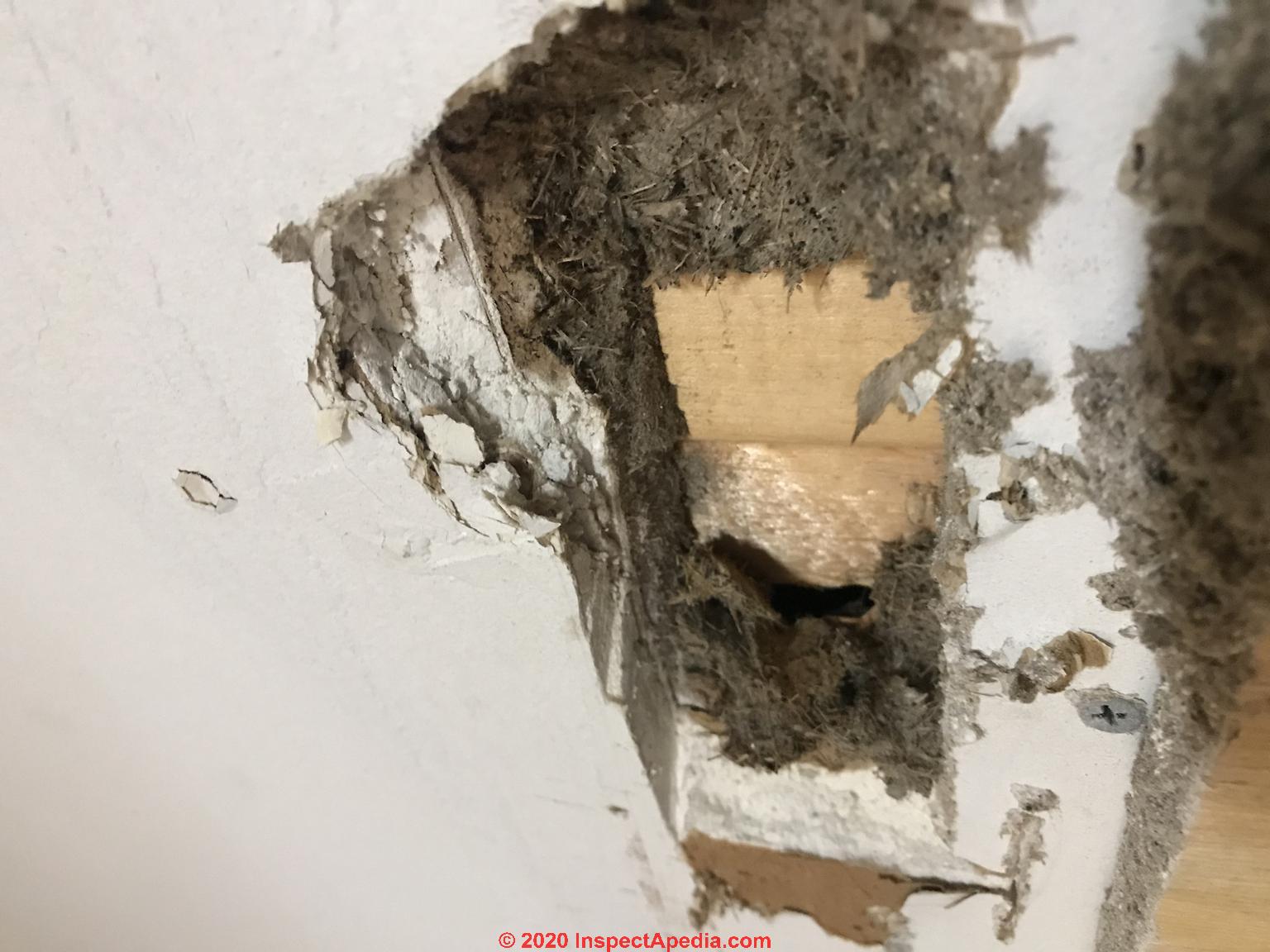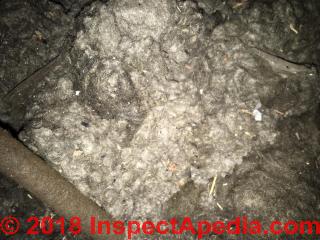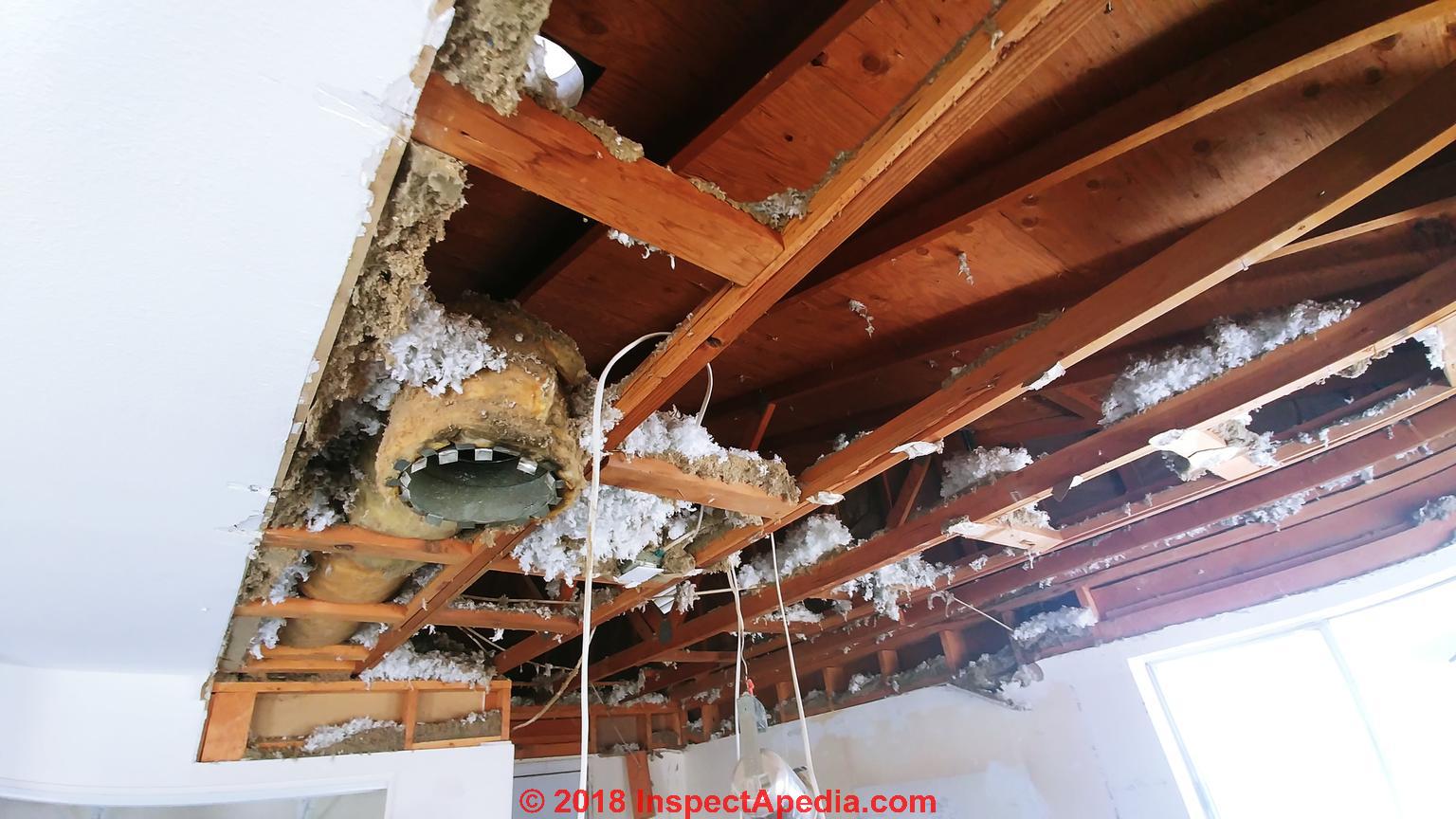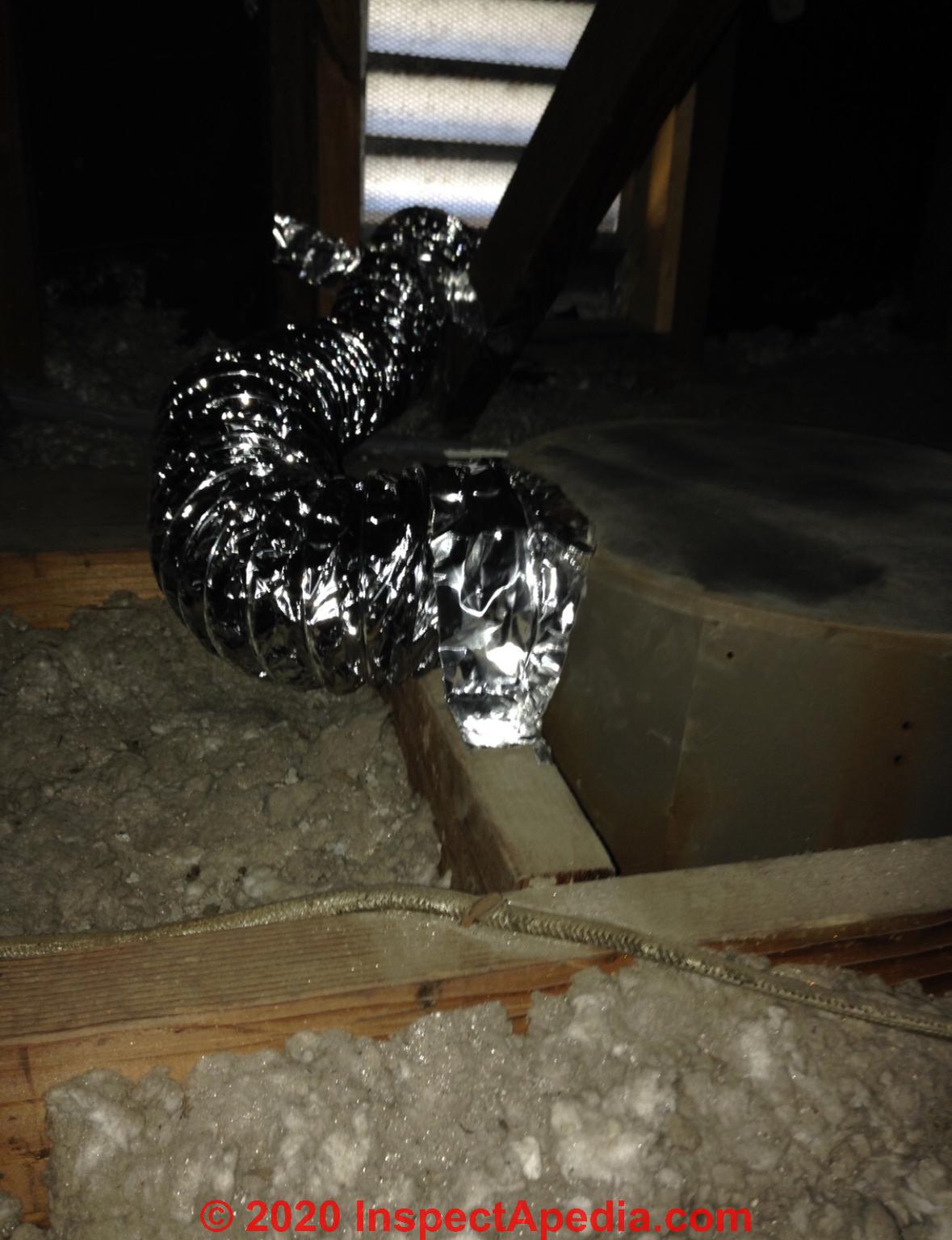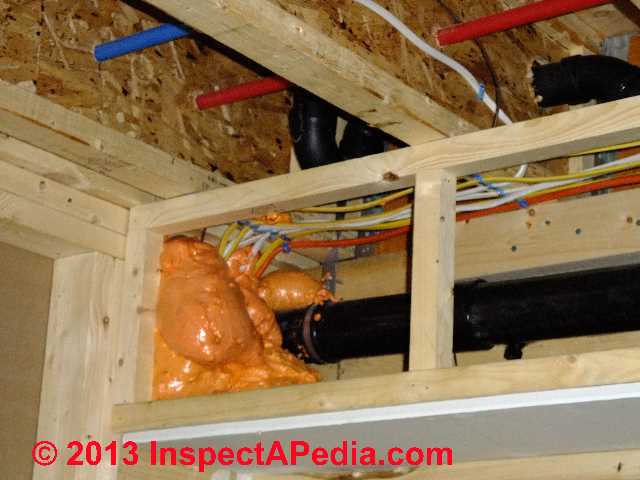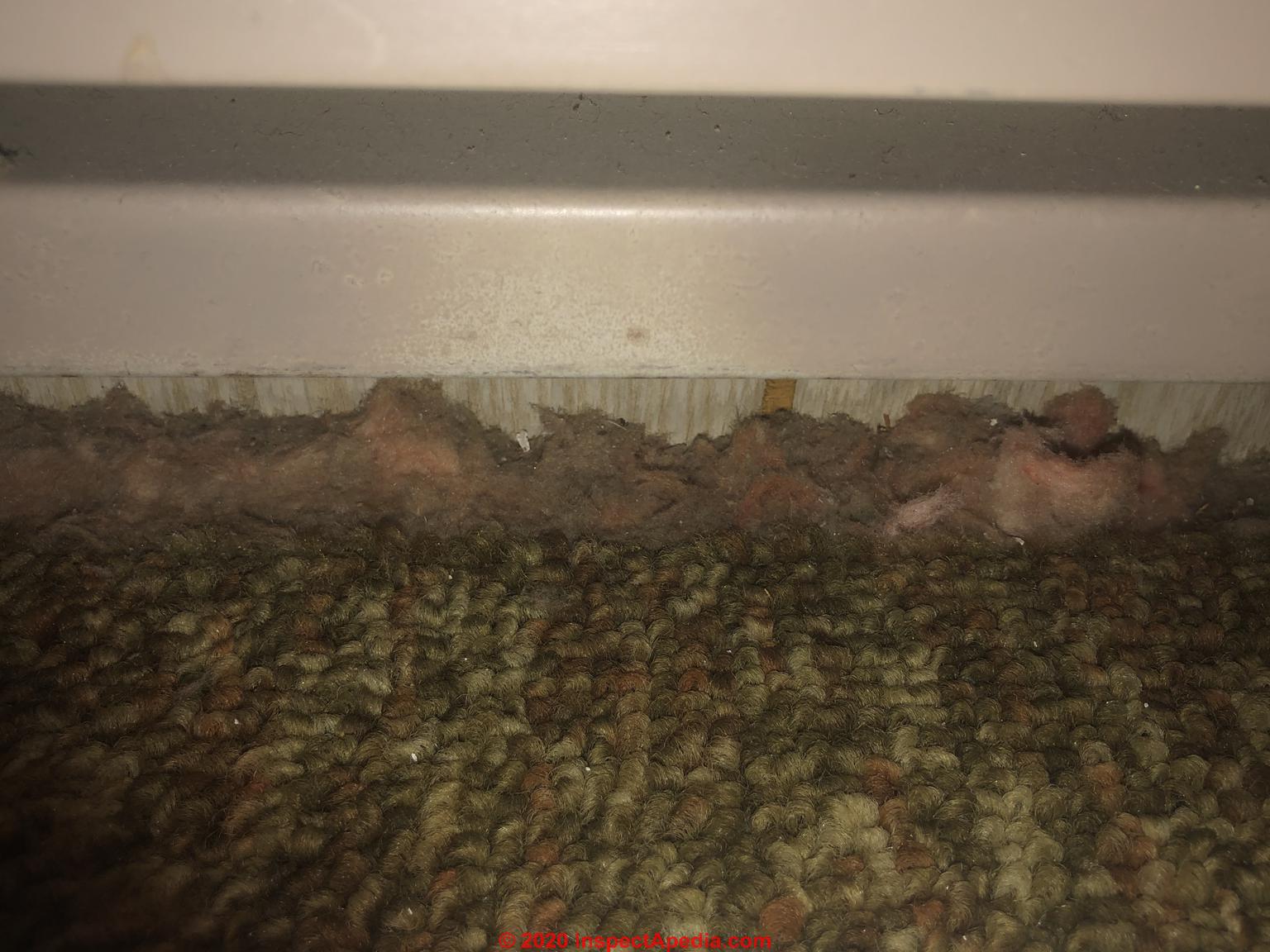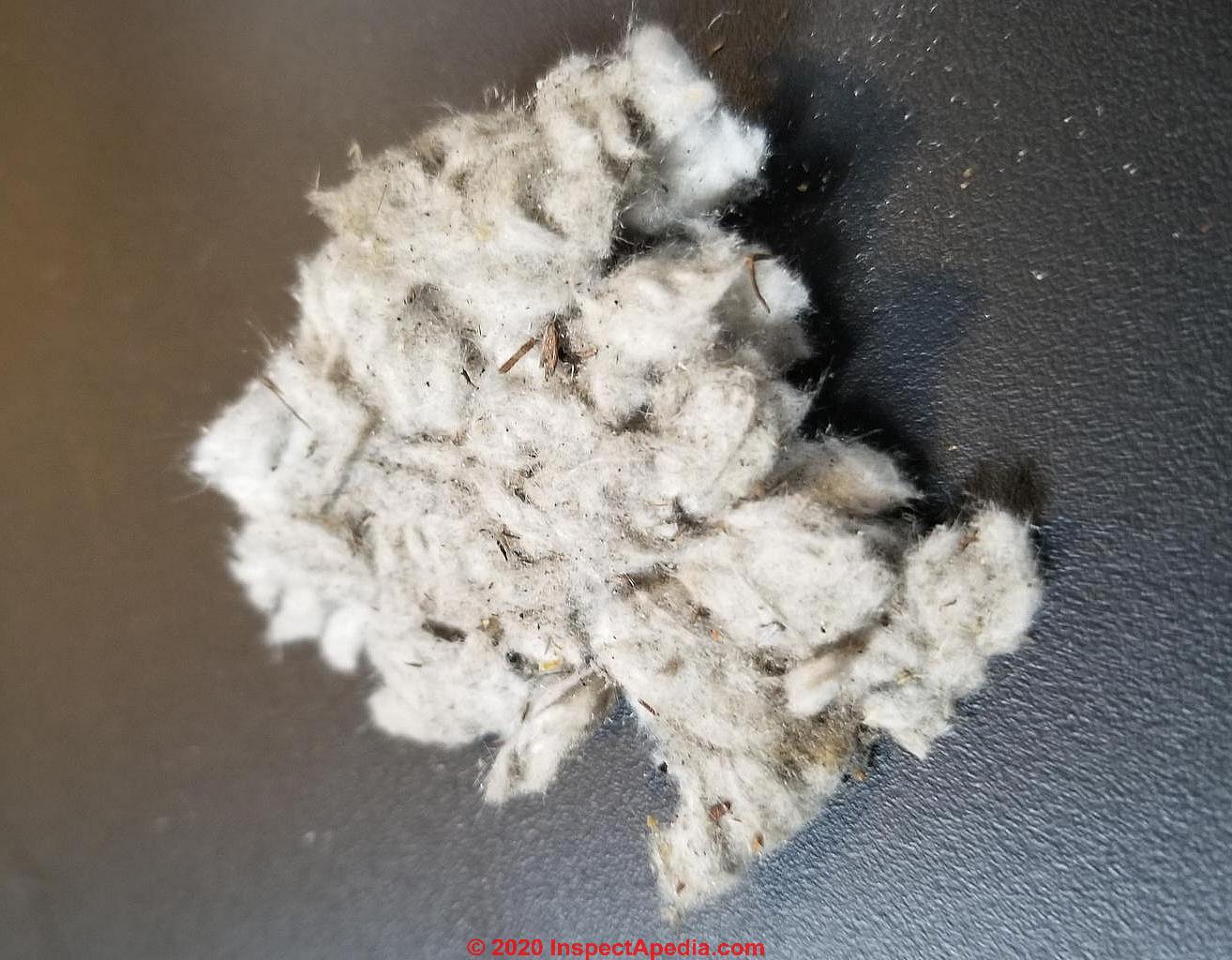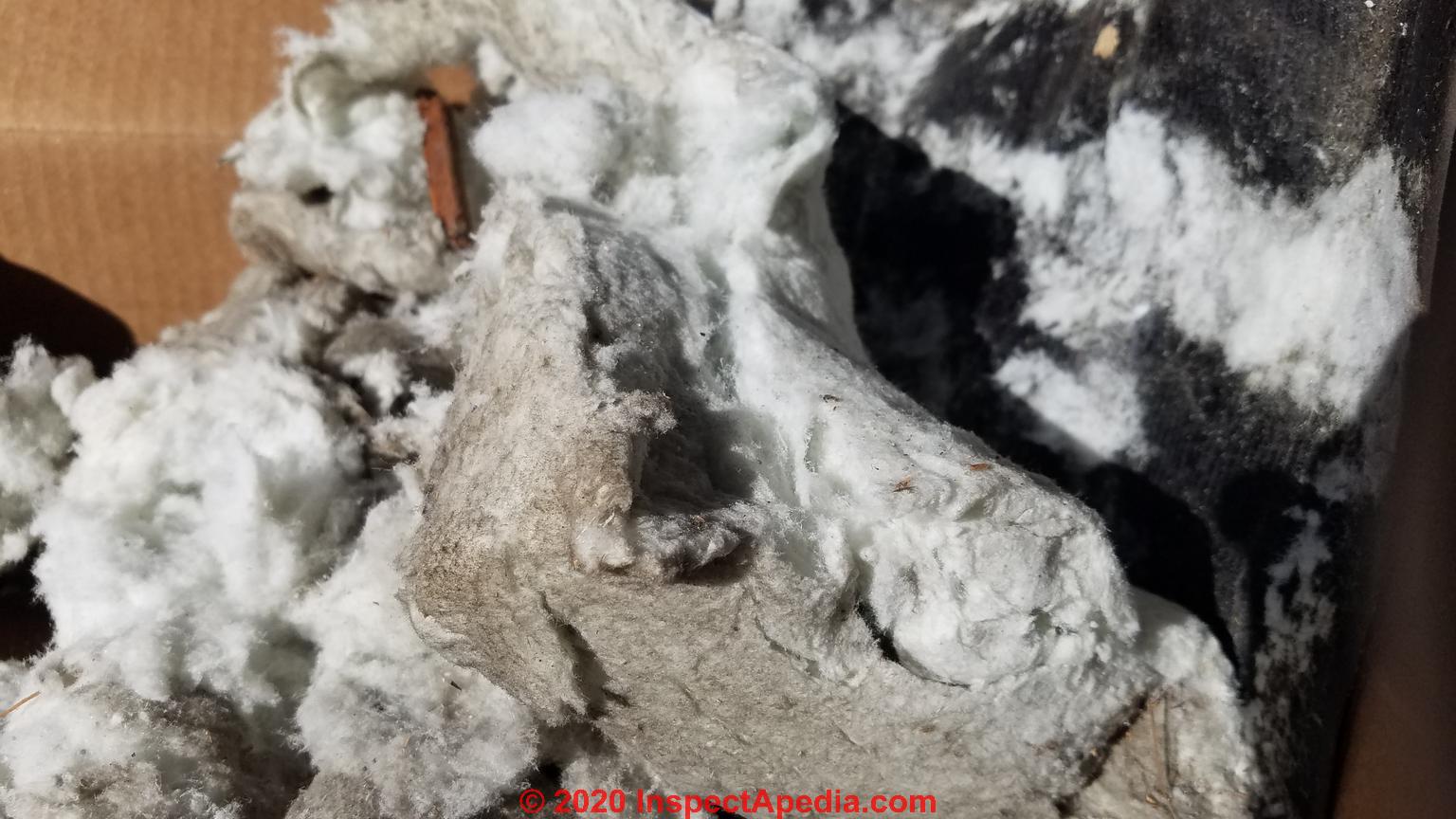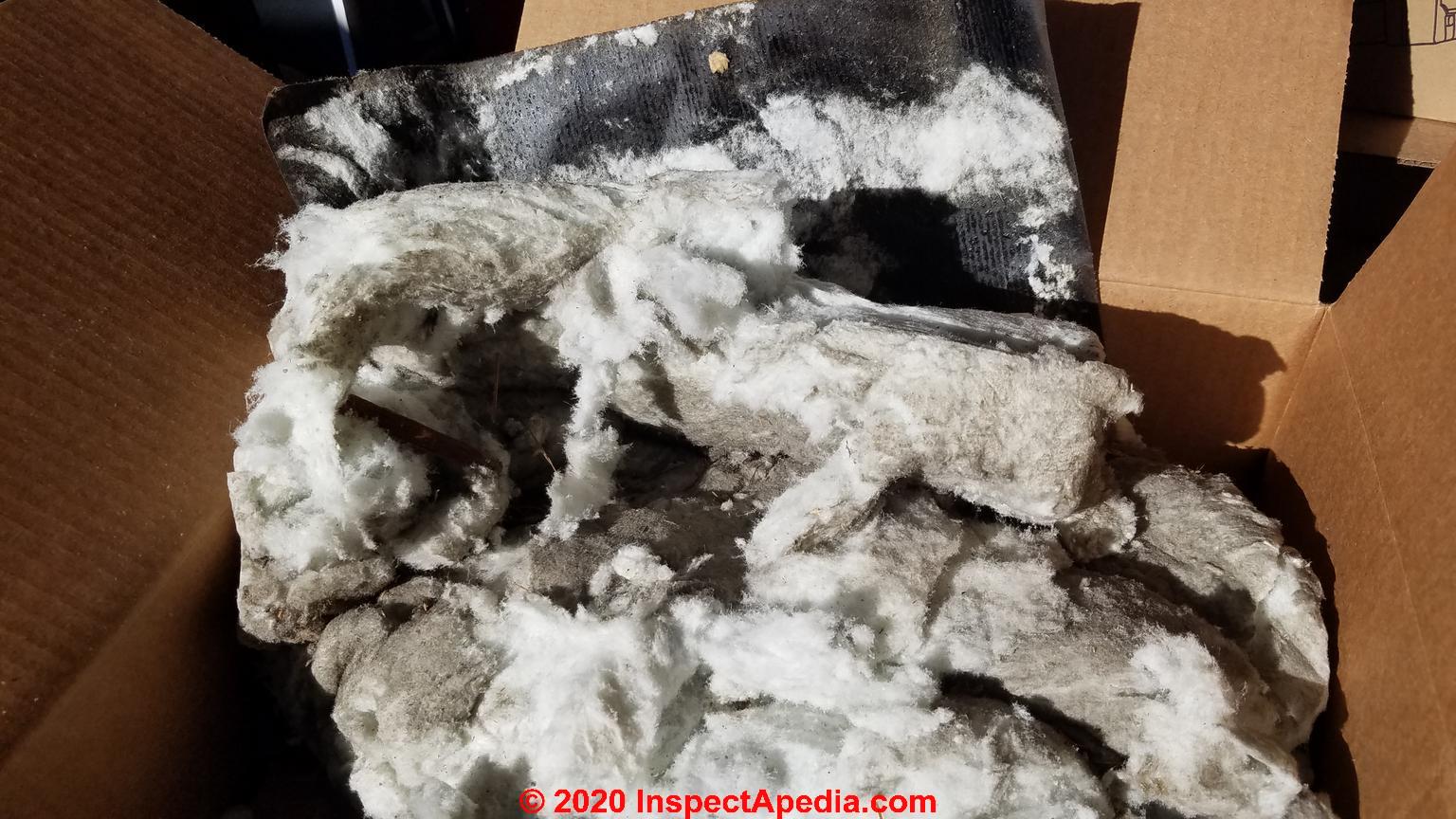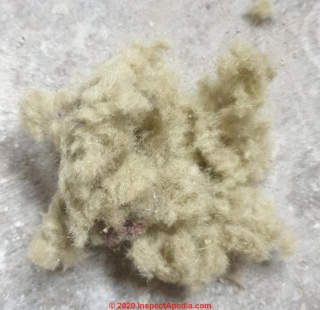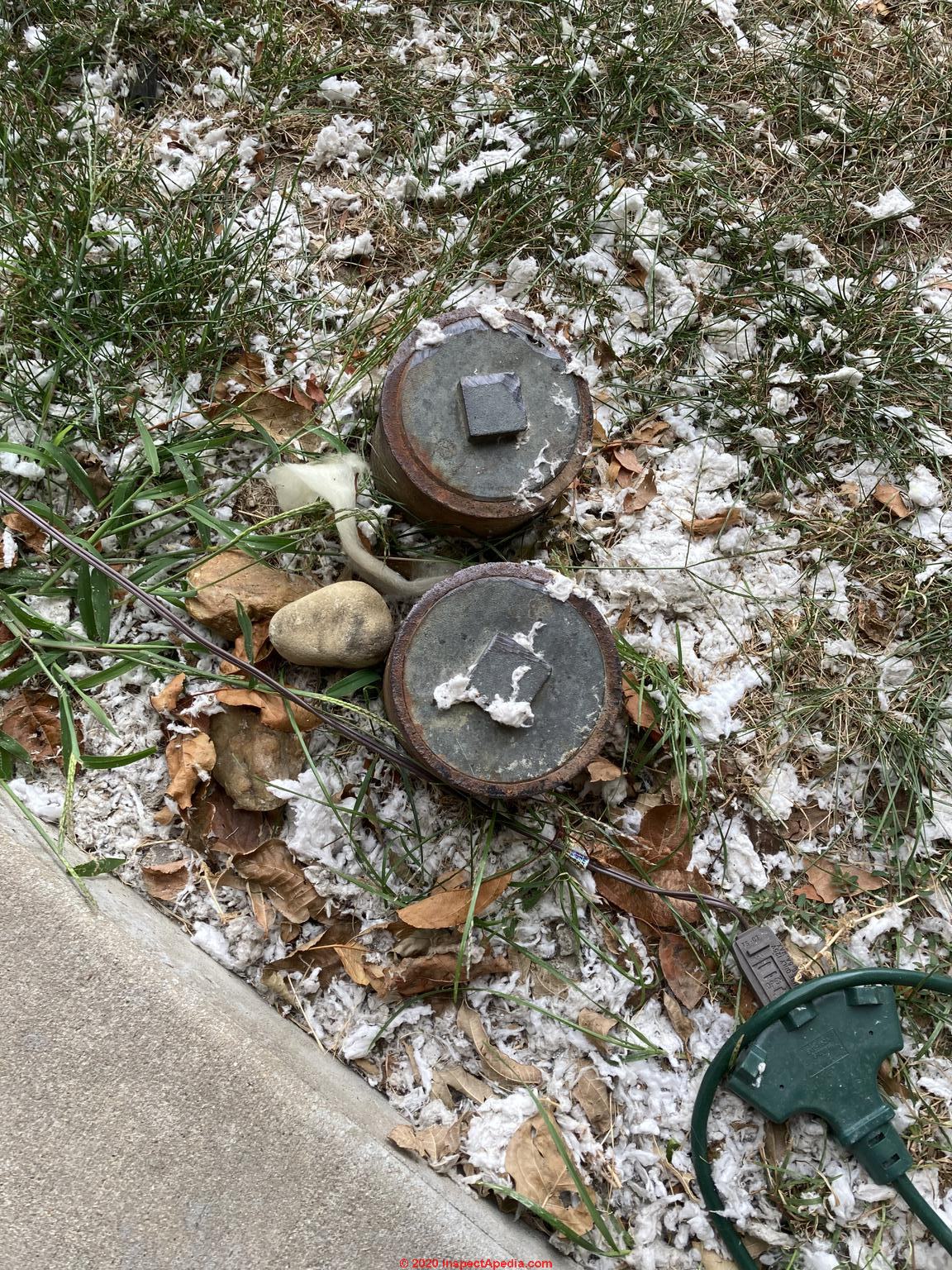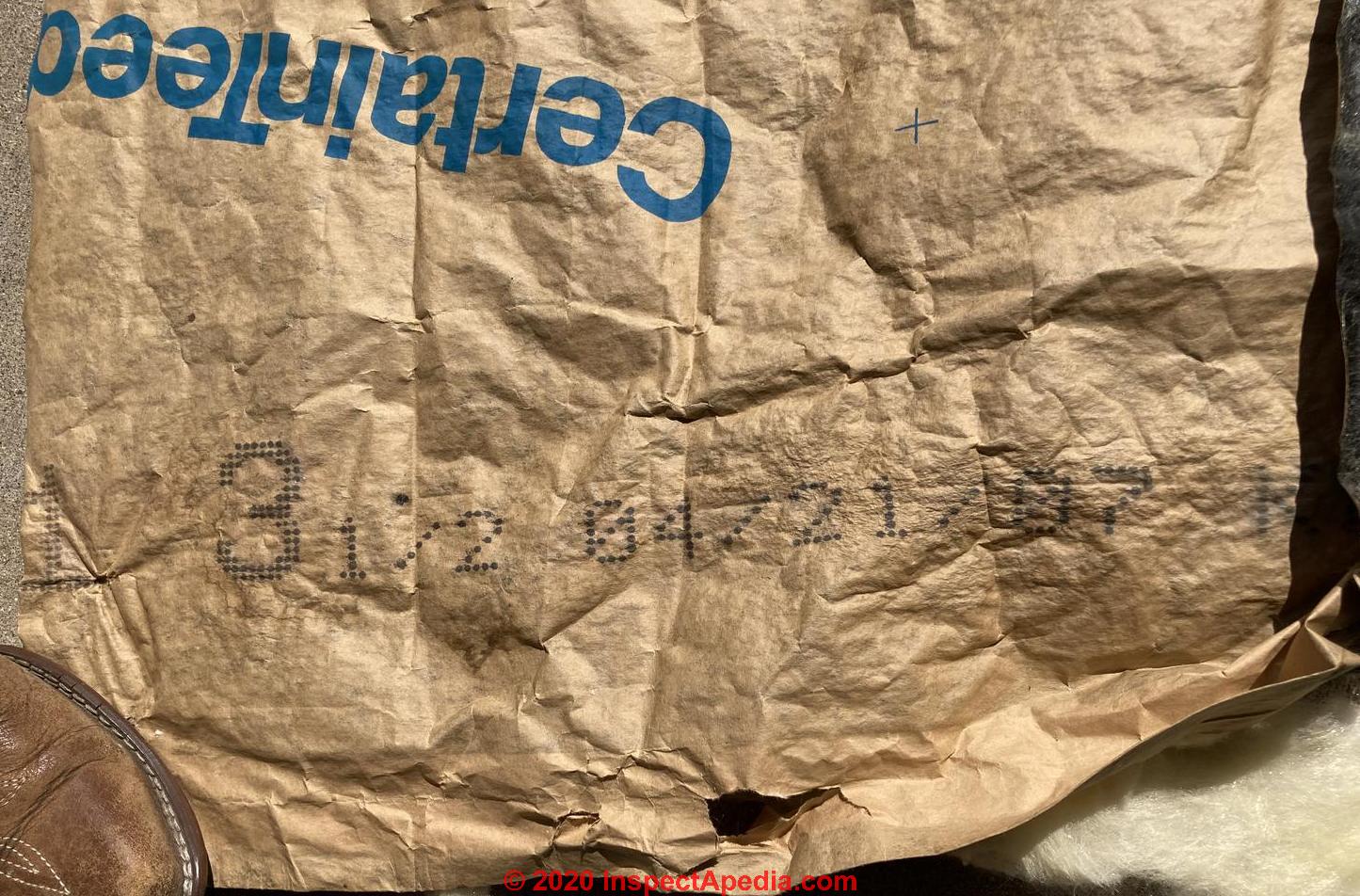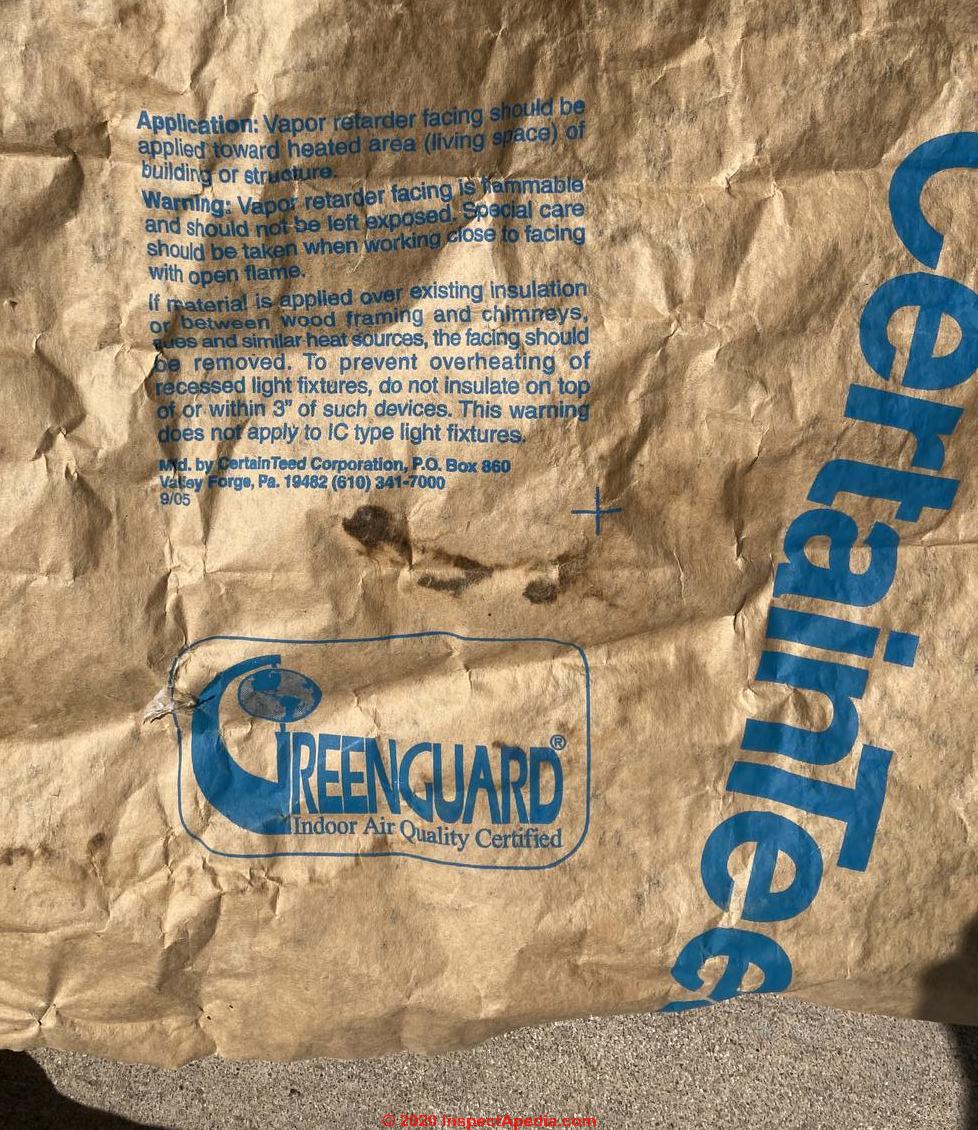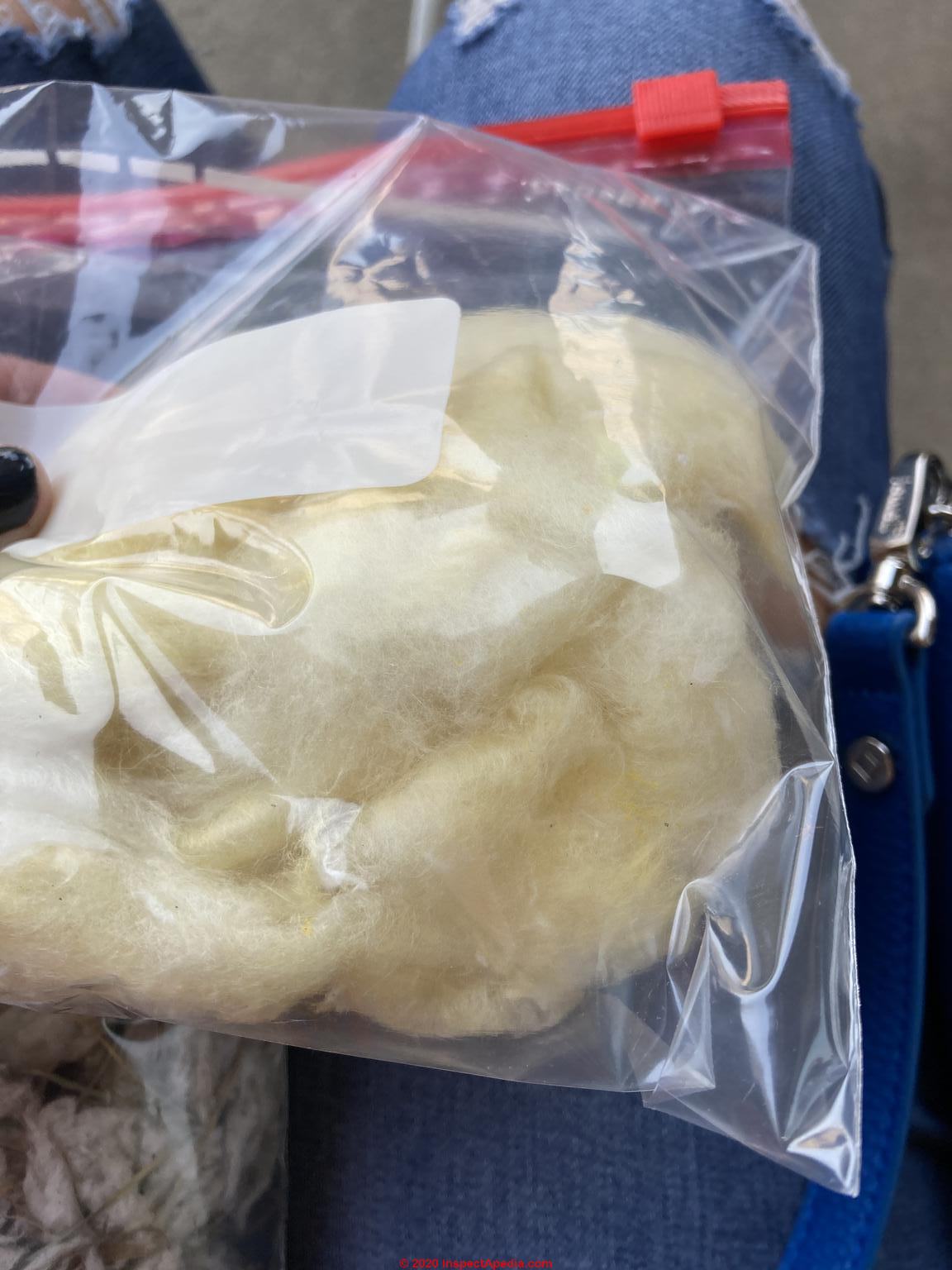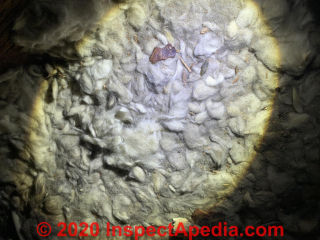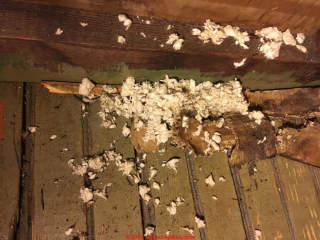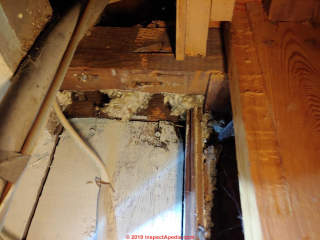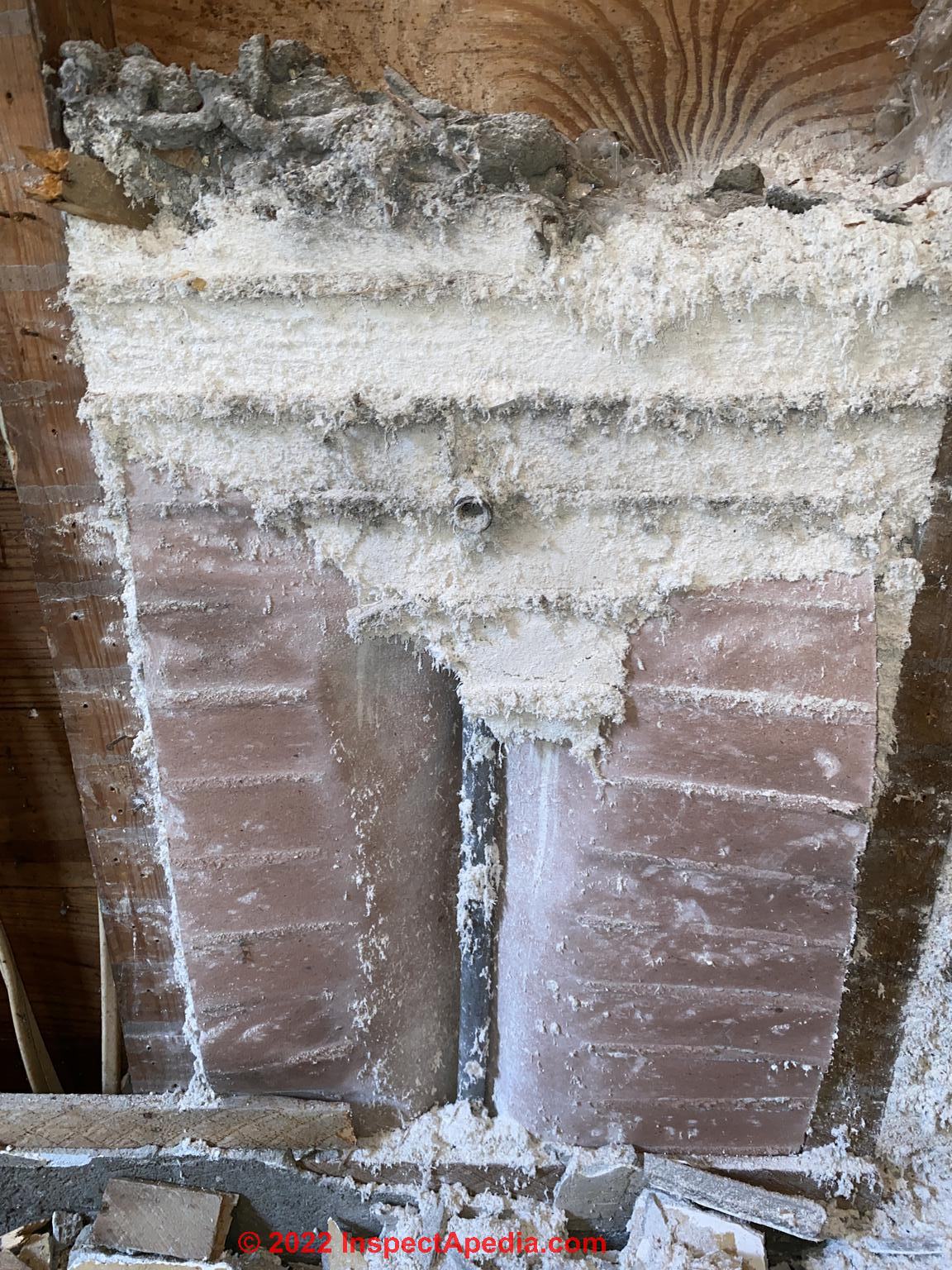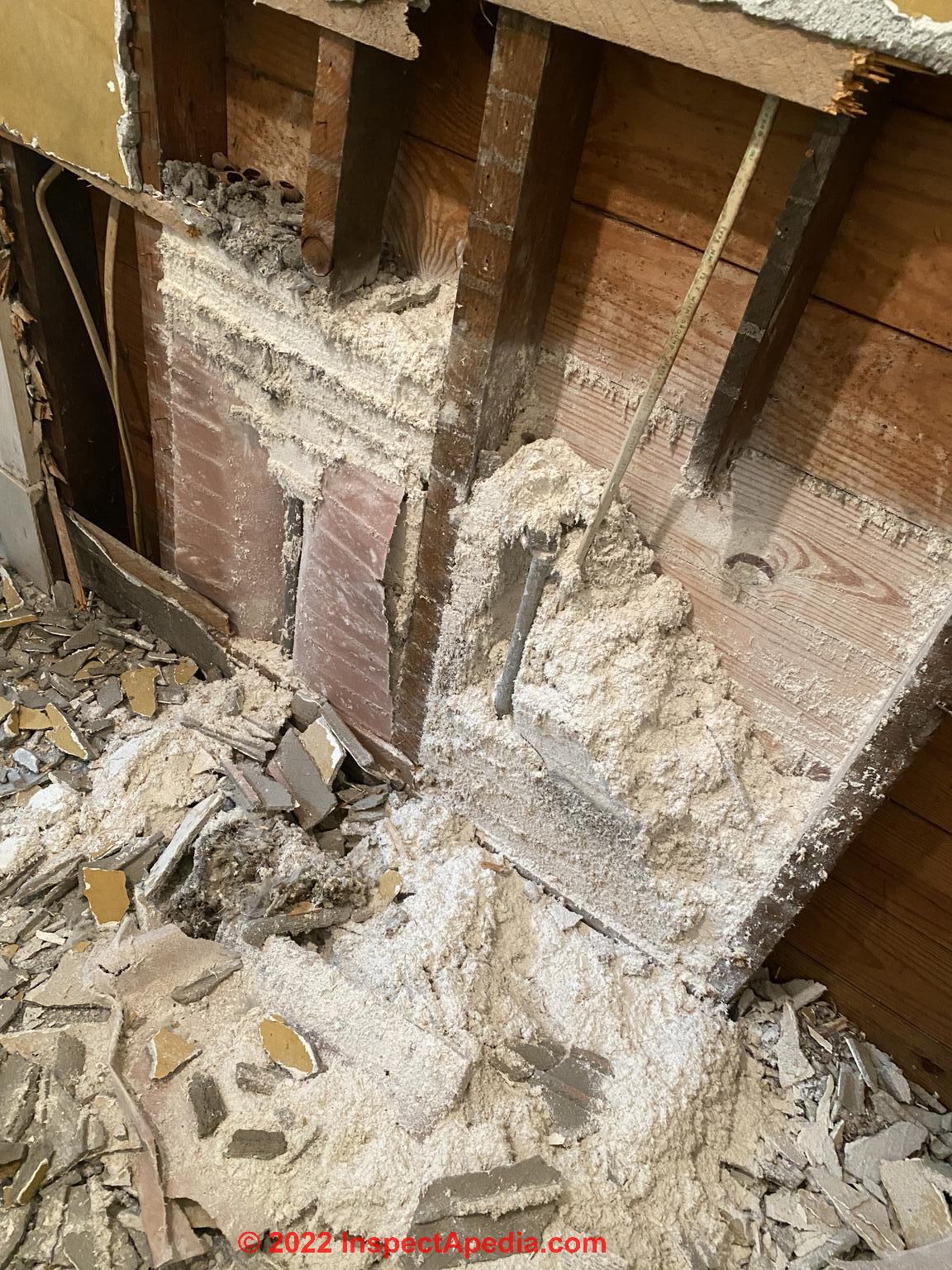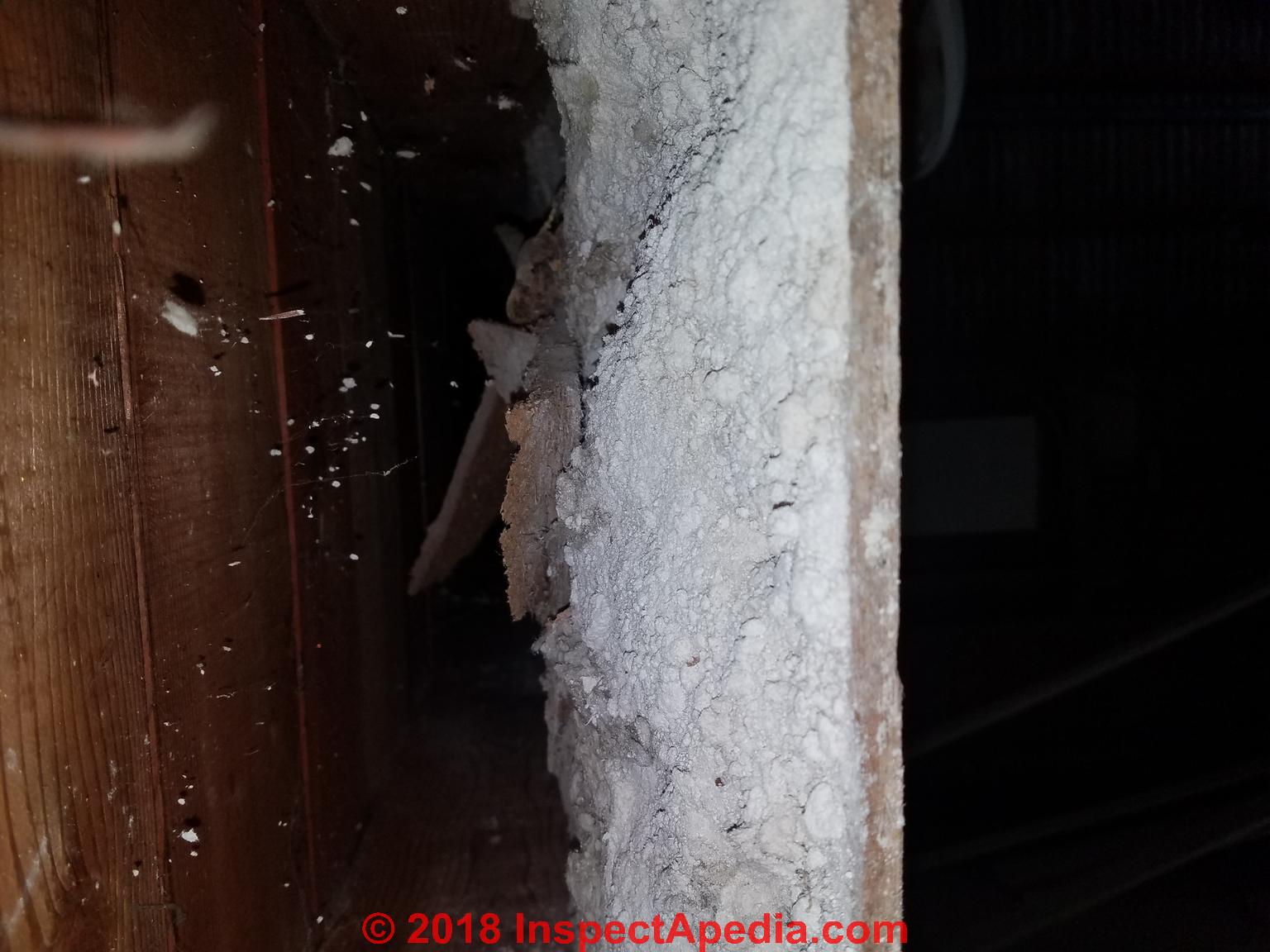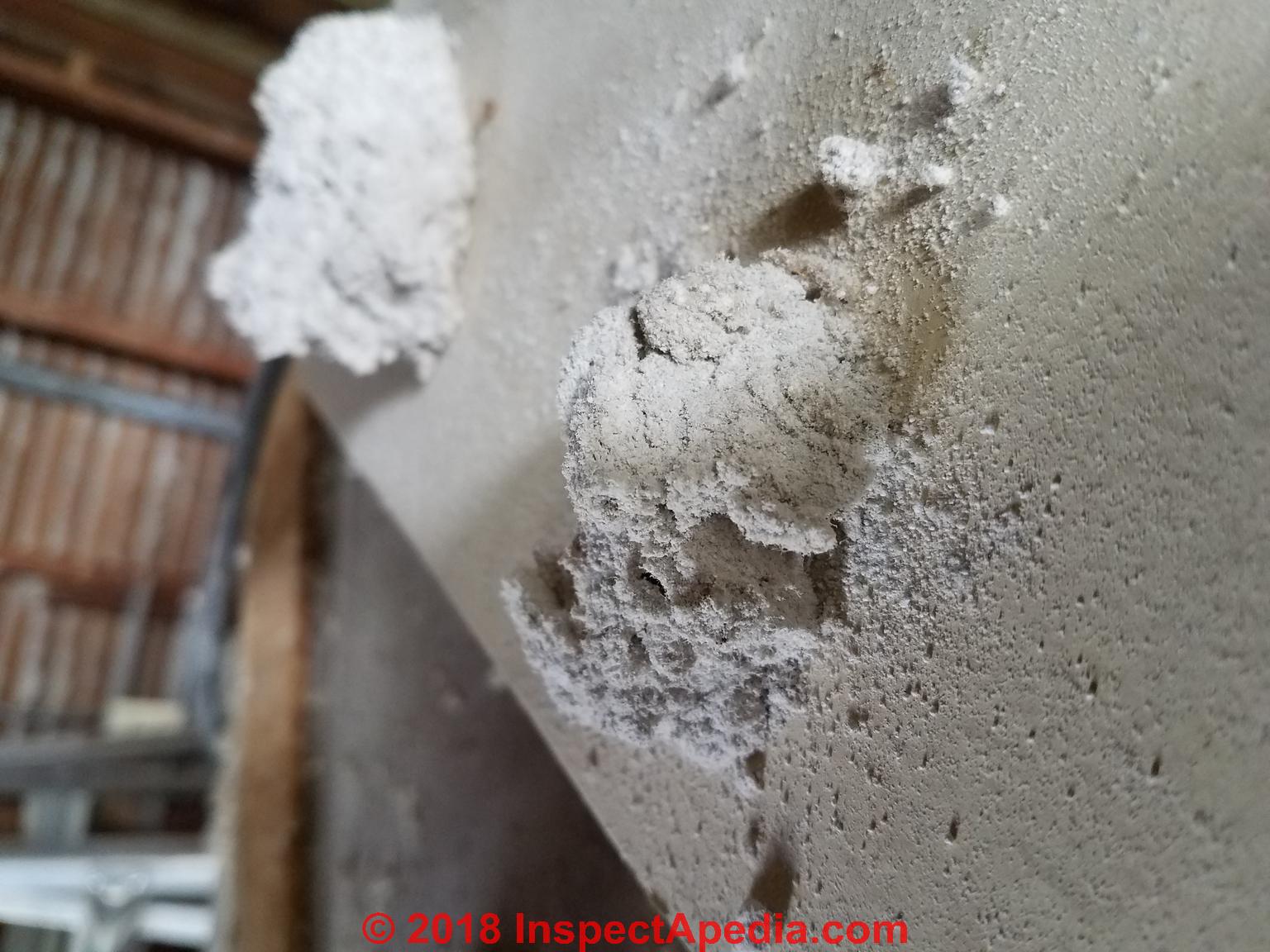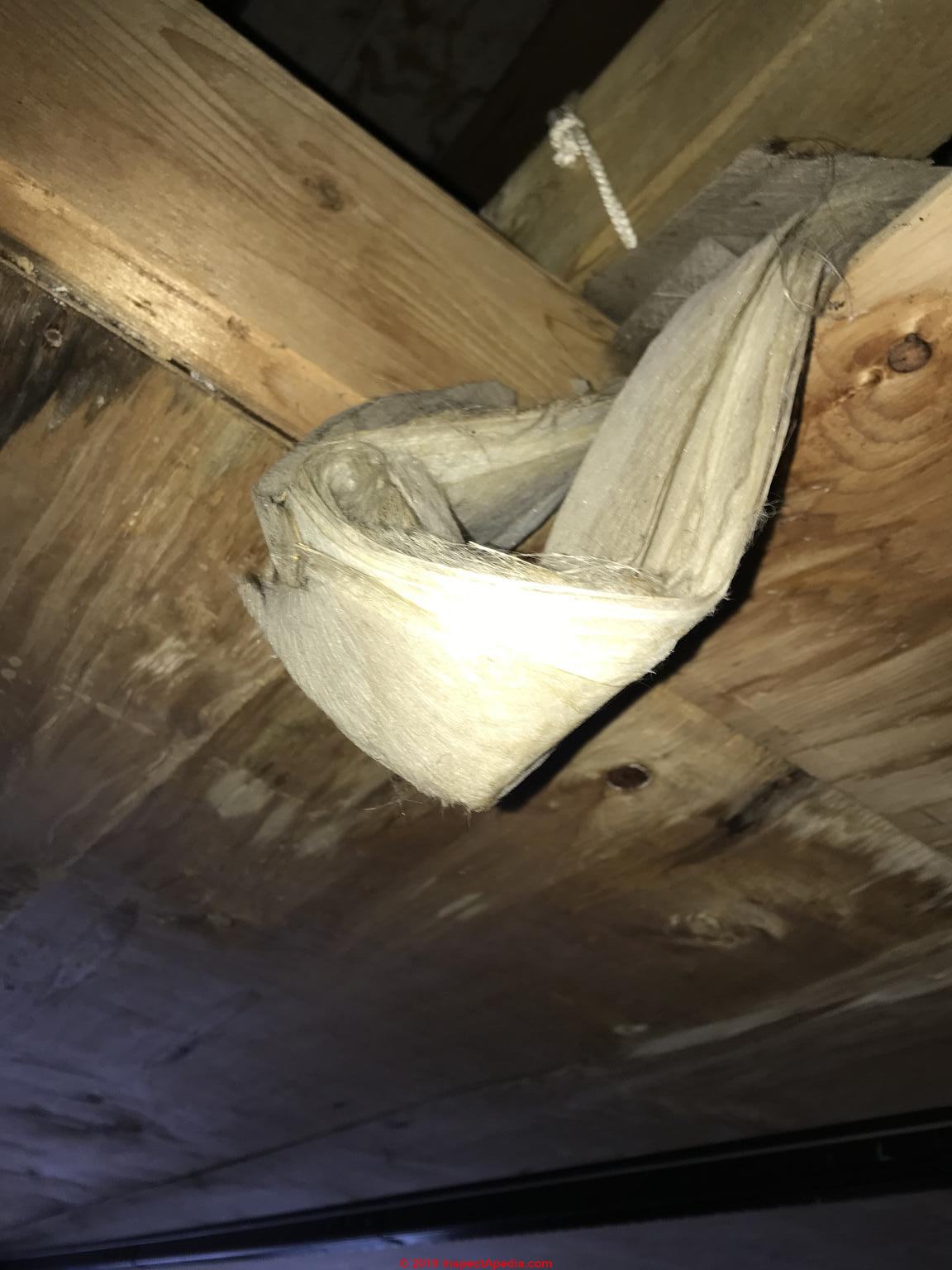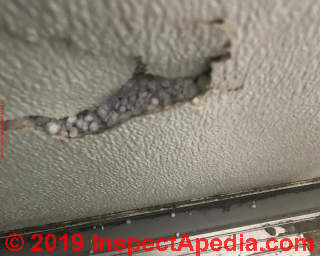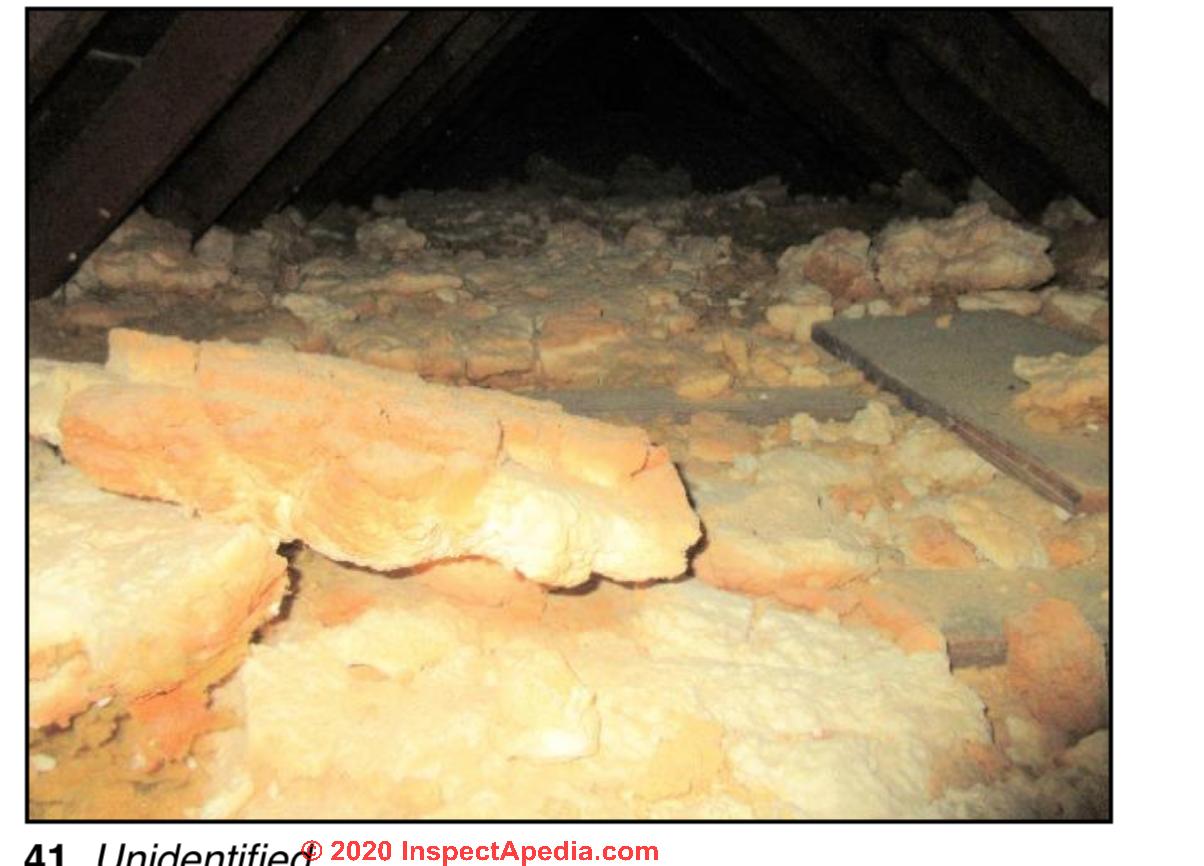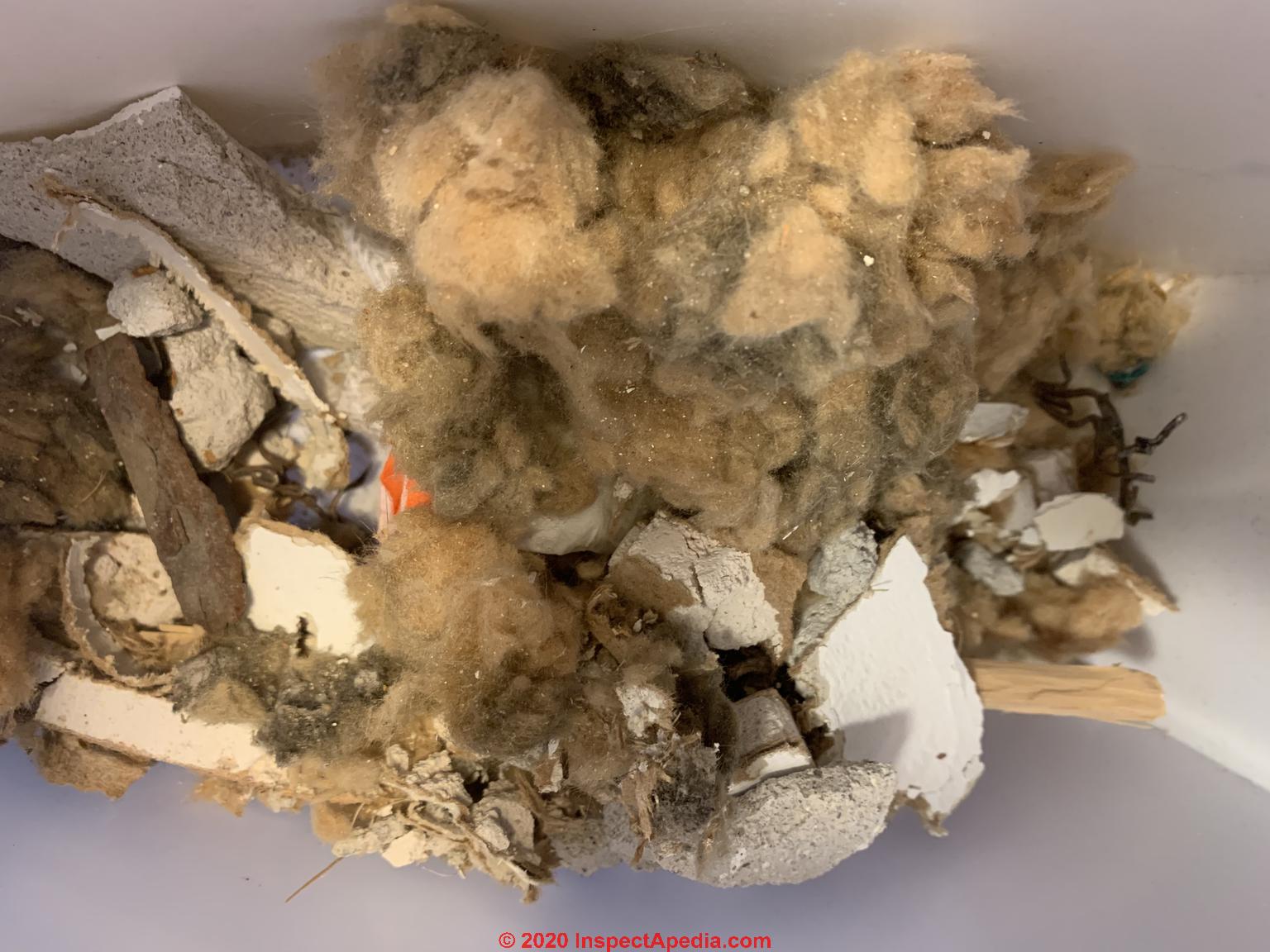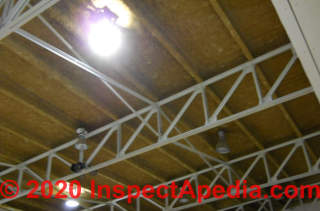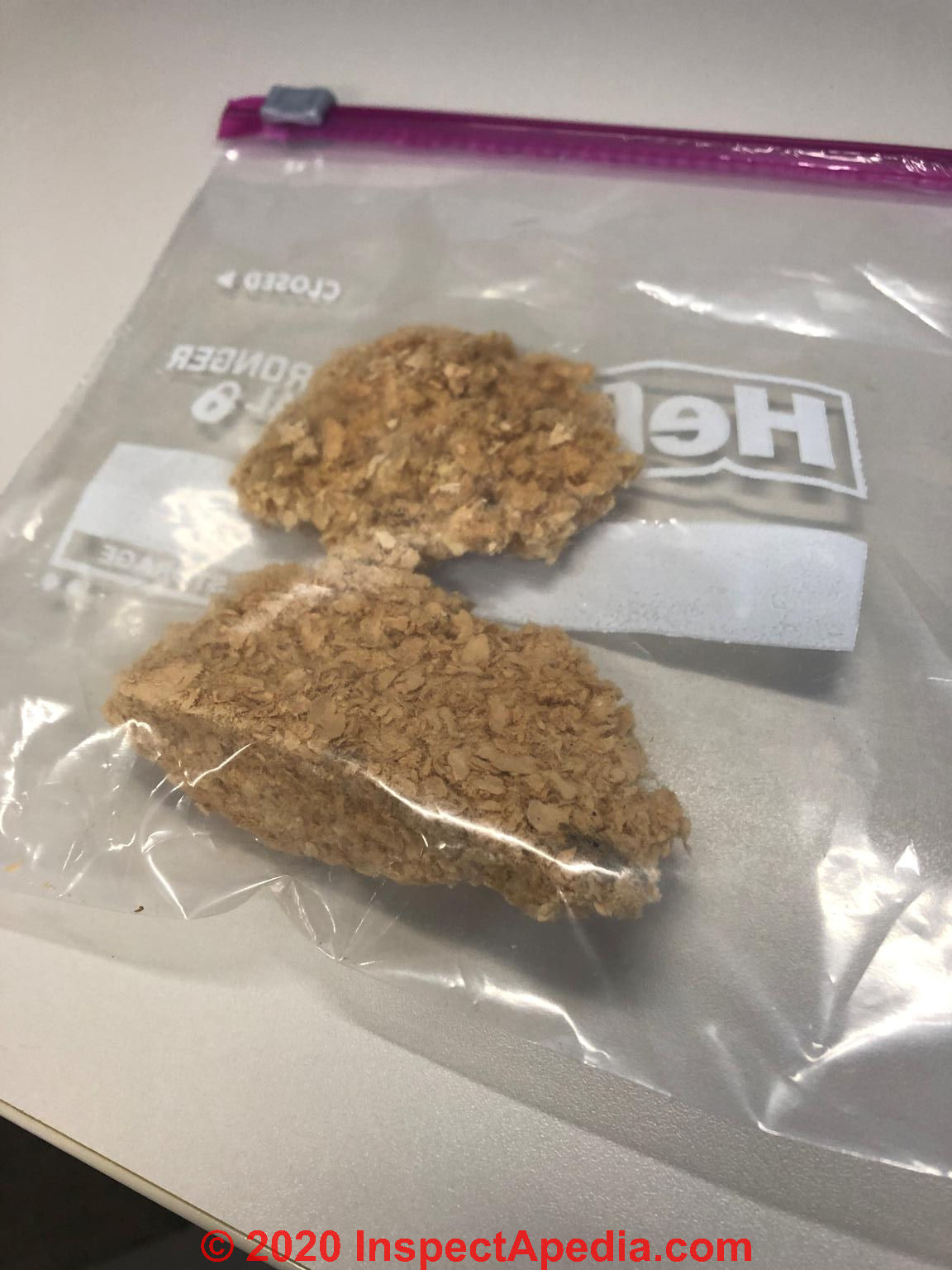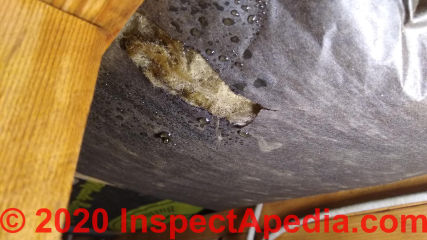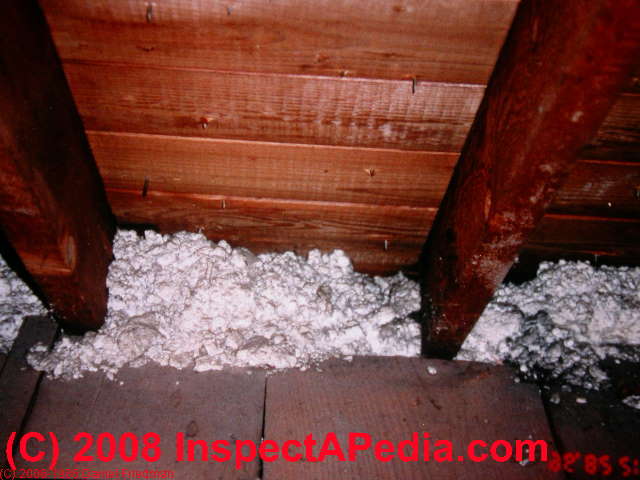 Insulation Identification FAQs 2
Insulation Identification FAQs 2
Identify building insulating materials by color & texture
- POST a QUESTION or COMMENT about how to identify different kinds of building insulation
FAQs on how to identify types of insulation used in buildings & their mechanical systems:
Example photos of building insulation sorted by color, texture, or physical appearance.
We include photographs of insulation materials that would not be expected to contain asbestos as well as asbestos-containing materials.
Page top photo: mineral wool or "rock wool" insulation in an older New York home.
InspectAPedia tolerates no conflicts of interest. We have no relationship with advertisers, products, or services discussed at this website.
- Daniel Friedman, Publisher/Editor/Author - See WHO ARE WE?
Q&A on How to Identify Insulation Materials
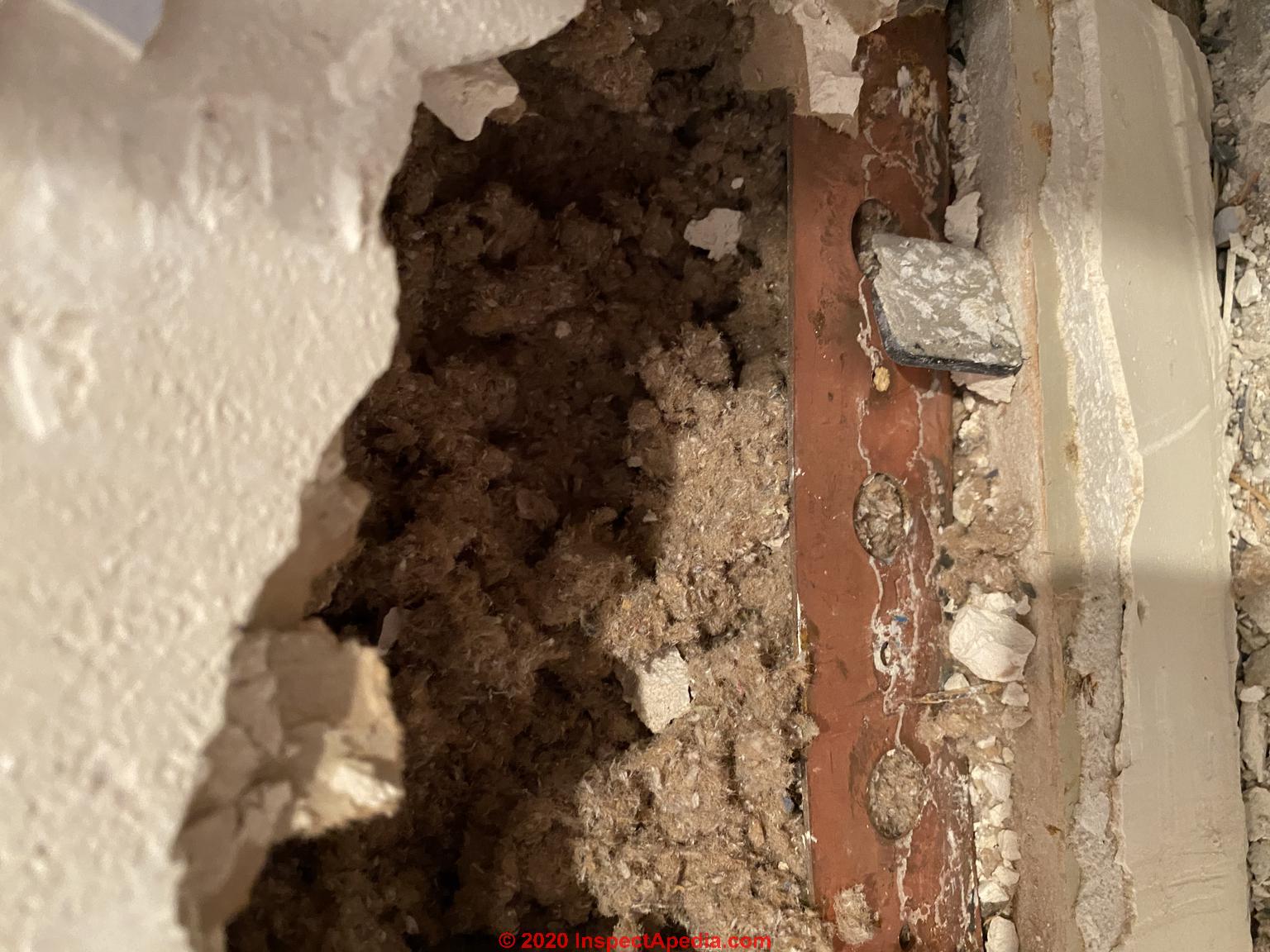 These questions & answers about identification of various kinds of building insulation by visual inspection were posted originally
These questions & answers about identification of various kinds of building insulation by visual inspection were posted originally
at INSULATION IDENTIFICATION GUIDE - be sure to see that article.
We've sorted these reader questions and photos by insulation color and texture or other key features of its physical appearance.
But because people's characterization of color or texture varies you will want to look through more than just one of these insulation color or texture descriptions.
Photo above: light gray cellulose building insulation, appearing gray and often with tiny but visible bits of newsprint.
Article Contents
- IDENTIFY BLACK INSULATION
- IDENTIFY BROWN INSULATION
- IDENTIFY CRUMBLY PARTICLES of INSULATION
- IDENTIFY DARK GRAY INSULATION
- IDENTIFY GRAY INSULATION
- IDENTIFY LIGHT GRAY INSULATION
- IDENITIFY ORANGE INSULATION
- IDENTIFY PINK INSULATION
- IDENTIFY SOFT / POWDERY INSULATION - including foam
- IDENTIFY WHITE INSULATION
- IDENTIFY YELLOW INSULATION
...
Q&A on Black Insulation Identification
Identify black fibrous insulation in 1970s New Mexico home
This insulation was removed while replacing the bathroom vent/heat lamp. It's the only bathroom, and they couldn't finish today, so clumps of it have been left exposed on the floor overnight. The house was built in the 70's in New Mexico.
Could you help me identify what kind it is, and whether it could contain asbestos? If you were doing this job and you couldn't finish that same day, would it be safe to leave clumps of insulation that are not covered or contained in the only bathroom in the house?
Could using that bathroom cause irritation even if I didn't touch or disturb it?
When I wiped the irritated area with a baby wipe, it looked like there might be a glint on the wipe if the light caught it right..like a clear sparkle, or grain of MSG. - On 2020-10-03 by Diane NM
Reply by (mod) - Mineral Wool Insulation
See and compare your insulation with the photos at
ID black corrugated paper insulation?
I have an old black insulation that looks like corrugated paper and falls apart when touched im assuming cause is old, burns green - On 2020-08-25 by Mh -
Reply by (mod)
I'd need to see some photos but that might indeed be an early form of corrugated paper-felt insulation or building wrap.
Often the kraft paper facing on insulating batts was coated with asphalt or "tar" to bind it to the insulation itself. I'm not sure what you're seeing.
Identify dark gray-black soft insulation
Looking to identify this attic and wall insulation. The house was built in 1961. Not sure when insulation was installed. Dark grey in color and soft.
On 2019-03-23 by John
Reply by (mod) - black mineral wool insulation
looks like a dark gray or black mineral wool insulation, John.
Identify this black insulation
Can anyone help me identify this black insulation. my husband disturbed it in a room that was not contained and made a mess that spread into the adjacent hallway. - On 2018-10-15 by am Oregon
Reply by (mod) - dark nearly black mineral wool insulation
I'm not sure as the photo is a bit blurry and poorly lit but I think we're looking at a type of dark gray to black mineral wool insulation.
See MINERAL WOOL - ROCK WOOL INSULATION - home
Identify old black crumbling insulation with grainy texture - smells like rotten eggs.
We have this old insulation at my work were cutting out from above a cooler area. It’s about 4 inches thick and is black. Has a grainy texture to it. We cut it out with a sawzall into small sections to dispose of.
It has a rotten egg type smell to it. Also has a similar smell to carbon. Sorry I don’t have a better picture of it is this stuff safe to be around? - 2020-12-07 by JB
Reply by (mod) -
JB
How hard is the material? It looks a bit like an asphalt-mix product, not foam.
I don't recognize it enough to offer a name but I'm looking further.
Also that white gummy pipe wrap i the center of your photo may contain asbestos.Followup by JB
It’s a hard substance but kinda of crumbles when I pinch it with my hands and gets very dusty.
In this photo you can see how it gets dusty once it breaks down.
Reply by (mod) - Rubberized or asphalt-clay emulsion coatings as insulation
JB
It would be smart to use appropriate dust control on personal protective gear especially respirator.
It's possible that you are seeing a rubberized duct coating material or a water-based asphalt-emulsion type insulation. These were principally a mixture of clay and asphalt, sometimes with mineral fibre reinforcement.
Even today Johns Manville produces an asphalt-clay emulsion used as a roof coating product sold in sheets or boards or troweled-on or both.
Such coatings have been used on HVAC duct systems.
Current examples are found in
Henry Co. INSULATION & ADHESIVE COATING CHART [PDF] (2009) Henry Company Canada, 15 Wallsend Drive, Scarborough, ON M1E 3X6 Tel: 416-724-2000 / 1-800-361-4599 Fax: 416-724-6818 www.bakor.com www.henry.com e-mail: info@bakor.com e-mail: cshenry@henry.com
Childers INSULATION & COATING SELECTION GUIDE [PDF]
THERMAL INSULATION FOR MECHANICAL SYSTEMS [PDF] USACE / NAVFAC / AFCEC / NASA UFGS-23 07 00 (February 2013)
Excerpt:
This guide specification covers the
requirements for field applied thermal insulation on
HVAC and plumbing systems located within, on, under,
and adjacent to buildings; above and below ground.
It would be helpful to know the country and city of location and age of the building where this insulation is installed.
...
Q&A on Brown Insulation Identification
Can't identify this brown woody fibre insulation in the attic ofa 1930's SanDiego CA home
Our house was built in the 1930's in San Diego, CA We have not been able to identify the material in our attic.
We are getting estimates for insulating the attic and are curious what material this might be and whether we should remove it or just put new insulation over it.
It is currently about 3" thick but we are thinking it has settled over the years and most likely filled ceiling joist bays when originally installed. On 2019-03-14 by Trista
Reply by (mod) - wood fiber insulation
Trista that's a wood fiber insulation. See other more-finely chopped wood insulation examples
at BALSAM WOOL
What is this 1960's brown hair-like board insulation product?
Trying to identify this board insulation product [shown above]. Appears to be formed hair with some sort of paint coating.
Detected on underside of 1963 metal building structure. Any ideas please advise, thanks. - On 2020-08-05 by rtoddmann Identify
Reply by (mod) - Jute? Animal hair?
RT
Thank you so much for the question and photo; it's a treat to see an insulation material that's unfamiliar; I agree that it sure looks like hair, except too much too uniform; save a sample and when we're past COVID and I can look at it under the microscope I can perhaps identify the fiber.
I'd also like to see a photo of the edge of an intact insulating board of this material.
It's also possible this is a vegetable fibre such as jute.Compare your insulation with that shown at
and with
Is this coarse brown fibrous insulation lagging asbestos?
I'm currently renovating a science building, very old, mostlikely early or late 50' s, the exterior door frame we are removing has some type of wool, stringy substance that was behind a kind of putty that overall has gotten hard over time
it looks as if a form of insulated asbestos but I must be sure before moving g further, included are pictures, please get back to me asap, - Anonymous by private email 2019/07/30
Reply:
The long fibered gray material in your photo would not be asbestos; I'm not sure just what it is, though it looks a bit like a cellulose fibre. What's the country and city location?
Reader follow-up:
Houston TX, currently demo work at U of H science and research building,
it's actually the brown fibers I'm concerned about
Reply:
I'm not sure just what that material is but it in no way resembles any asbestos insulation product I've seen.
It looks like a wood fiber or cellulose fiber product.
See and look through the example photos at our
INSULATION IDENTIFICATION GUIDE
and compare that with photos of commonly identified asbestos material in buildings:
see ASBESTOS PHOTO GUIDE to MATERIALS
For some comparison photos.
The obvious advice from most people would be to have a sample tested. That'd cost under $50. U.S. ASBESTOS TESTING LAB LIST may be of help.
Watch out: However there could be lead paint hazards - has anyone tested all that peeling paint?
LEAD BASED PAINT-USES in BUILDINGS has more information.
What is this brown blown-in attic insulation? Balsa wood?
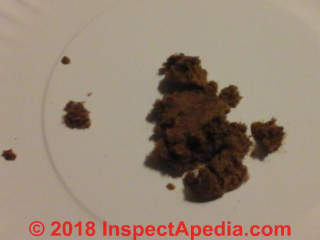 This is the blown insulation in my attic. (photo above)
This is the blown insulation in my attic. (photo above)
Can anyone tell me what it is? It is blown,not batted,so Im not sure that it the balsawood variety
On 2018-11-01 by Melisa
Reply by (mod) - Balsam-wool-like insulation fragment
If the material (shown above) is brown and fibrous it would probably be a wood product such as Balsam wool - usually in batts, not loose fill.
If it's gray and you can under magnifying glass find occasionally tiny bits of paper, it's cellulose loose fill or blown-in insulation.
Please review the photo examples of types of insulation at
BALSAM WOOL BATT INSULATION and let me know if you have more questions.
What is this fluffy brown insulation sprayed on to the ceiling, girts and columns of a building in Denver Colorado?
I am working on a job site as a welder in Denver, CO.
I am supposed to do some structural welding on an area that has a lot of the insulation pictured, sprayed on the ceiling and surrounding girts and columns.
The insulation is flammable to some degree - it burns quickly, but it also leaves kind of a rubbery residue. Can you possibly identify it?
On 2018-06-08 by Steve Reed
Reply by (mod) - Knauf Ecose insulation?
I'm not sure that that is, Steve. It looks like a brown fibrer material, maybe a wood product but I can't say.
If it's wood-based it ought to have been treated with a fire retardant. It doesn't have the individual flecks of paper that I usually see in cellulose and that's usually more gray.
Knauf produces some brown insulating materials including Ecose using recycled and bio materials, but I'd not expect their insulation to burn.
In any event I'm surprised that the material burns quickly. Does it self-extinguish or would it just keep going if the insulation was ignited in place? If on ignition it would just keep burning I worry that something's wrong with the insulation and the building may have a fire hazard that is not understood.
It would help to know the age of the building or of the insulation and whether it's in batt form or loose fill or sprayed-on.Followup by Steve Reed
Ah yes, I forgot to mention that the insulation dates back to the late 1940's or early 50's.
Reply by by (mod) - distinguish between balsam wool and other fibrous insulations of similar colour
How interesting. Is it batt or loose or sprayed-on? I'm thinking a wood product.
See the brown insulation photos at BALSAM WOOL BATT INSULATIONFollowup by Steve Reed
I think you are right. It looks like the Balsam wool bat insulation. Thanks!
it is sprayed on.
Reply by by (mod) -
However, I'm not familiar with Balsam wool being used in a spray-on insulation application.
We need to be concerned that asbestos was used in some spray-on insulation applications.
Even though the product is not look like asbestos spray which would normally be a gray color.
Let's both do some further research.
Followup by Steve Reed - sprayed balsam-wool insulation?
10-4. It could be the ceiling was painted at some point. Also, it could be stained from years of use as an automotive/manufacturing facility.
Identify thin 1-2-inch layer of gray & tan fibrous insulation under fiberglass batts
There is a thin layer, 1”-2”, under the fiberglass bats in the attic of a house I am considering buying but I'm not sure what it is. Any ideas? Thanks
On 2020-07-12 by John
Reply by (mod) - rock wool
John,
That looks like mineral wool or rock wool insulation under pink fiberglass batts.
What's this brown soft insulating board under our plaster ceiling?
1936 bathroom needs a vent fan, cut into ceiling and found something above the plaster. Thoughts? - On 2020-05-08 by Steph
Reply by (mod) -
Sure, step, my thoughts are that you want to take a look at
SHEATHING, FIBERBOARD for details about insulating sheathing used on both the exterior (under siding) and interior of buildings.
Identify soft brown board insulation: Rockwool? Asbestos?
1880s schoolhouse with drop ceiling. We found rolls of heavy black insulation between the floors and drop ceiling.
Is this Rockwool? Asbestos? Cannot find any information on anything that looks like this. Thank you.
On 2020-11-21 by Suzanne
Reply by (mod) - No, that's a fiberboard product - not rockwool, not asbestos
Suzanne
Unfortunately your photo is a bit blurry so I cannot say with absolute certainty what it shows. But the color in general text you looked to me like a paper or cellulose fiber board insulation product. It does not look like rock wall or mineral wool.
See our examples at FIBERBOARD
...
Q&A on ID of Crumbly Particles of Insulation
What is this insulation - feels and looks like cork
Any idea what this is? Feels and looks like cork. It’s in an old drop ceiling. Thanks On 2020-10-06 by Billy
Reply by (mod) - Vermiculite insulation photo
Hi Billy;
you posted this question on another page where I replied that it looks like vermiculite insulation - see
VERMICULITE INSULATION
Identify brown fibrous insulation in 1978 home
Home was built in 1978. Has undergone multiple renovations and most recently, HVAC replacement.
This is located between the top of the unit and the ceiling/roof. Looks like hair, what is it? The HVAC guys didn’t mention any concerns but I’ve never seen anything like it.
- On 2020-09-12 by Bonnie
Reply by (mod)
That looks like brown fibrous insulation, perhaps mineral wool or a wood fibre insulation
...
Q&A on Dark Gray Insulation Identification
Is this dirty gray fiberglass insulation?
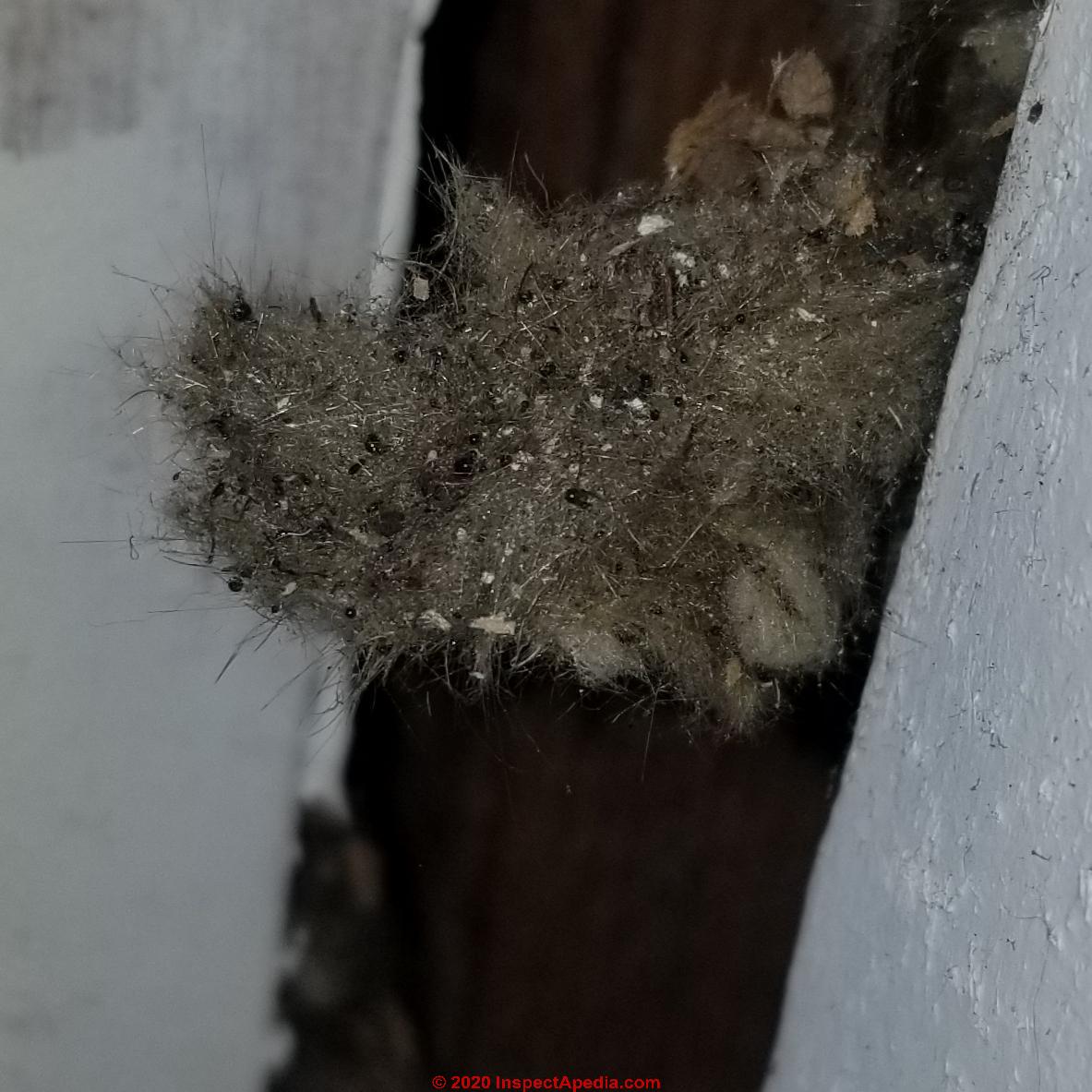 Does this [above] look like fiberglass insulation, just dirty? Our house was built in the 1920s.
Does this [above] look like fiberglass insulation, just dirty? Our house was built in the 1920s.
Found in a crevice in my daughter's room. Want to make sure it's not an asbestos hazard
I found this insulation sticking out of a crevice in a bedroom closet. Looks like dirty fiberglass to me - definitely has fine fibers. Hoping you can confirm this so I can stop worrying about asbestos. - On 2020-07-24 by timfarley2014
Reply by (mod) - rock or mineral wool
Tim to me that looks more like mineral wool or rock wool - similar to fiberglass.
Followup by Tim Farley
Thanks. So, in your opinion, should I be concerned about asbestos?
Repy by mod:
mineral wool is not an asbestos product
What is this dark gray fiberglass-like attic insulation?
Working in my attic and found this very dark grey insulation beneath the newer spray in insulation. Its very blown fiberglass like.
Has a shine to it. But very dark( the picture makes it look lighter than it actually is) House from 1955.
Anyone know if I should be worried? This is our first home we just purchased and want to make sure we are safe! - On 2021-03-22 by Brent O
Reply by (mod)
@Brent O, the insulation in your hand looks like fibrous material, probably mineral wool or rock wool; in the background of your photo we see what also looks like dark brown-gray loose-fill cellulose insulation.
I'd need a closer look
ID of gray clumped fibrous attic insulation, 1960's house.
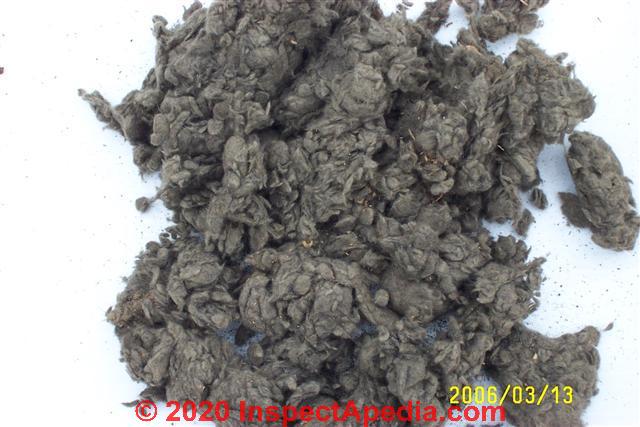
I found something almost identical to this image in my attic. The house was built in the 60's. Can somebody please help me identify it? Thanks!
On 2020-03-14 by Jess
Reply by (mod) -
Jess that looks like mineral wool insulation; see details at
MINERAL WOOL - ROCK WOOL INSULATION
Does this gray pre-fab chimney insulation contain asbestos?
Hi, I was attempting to remove some old chimney piping in my attic. It's steel with a printed brick pattern on the outside and hasn't been used for many years (it used to be connected to an oil furnace I'm told by the previous owner).
This is the first insulation inside the chimney.
After cutting into it I realized there was insulation, and seemingly two types?
This first picture shows the darker insulation inside the cutaway, with a lot of the other type (light grey) that's fallen around the base.
The next two pictures are the second type, a light grey, fibrous material. Any chance these are (or contain) asbestos?
Thanks for your help!||
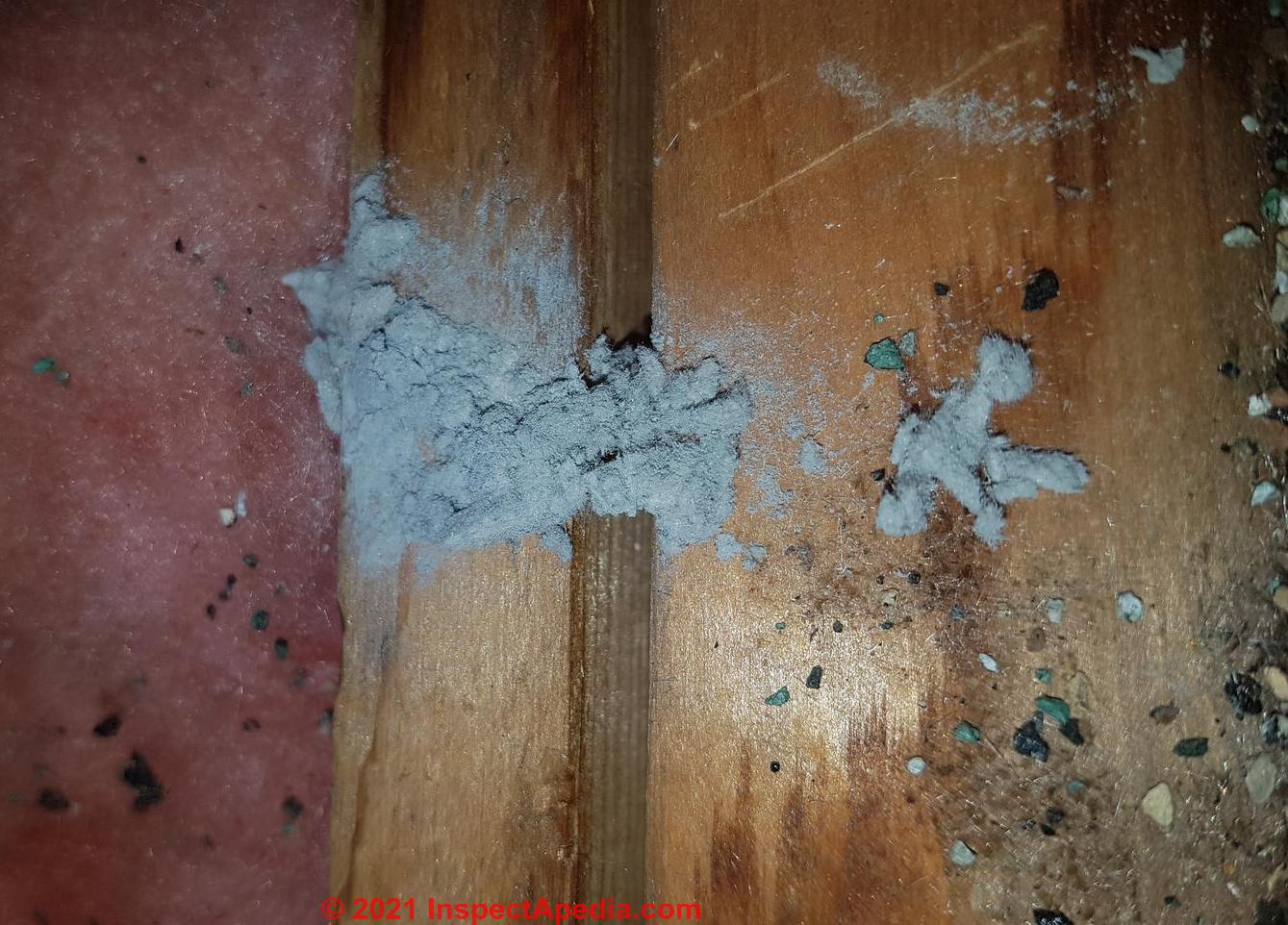
Here's a close up of the light grey fibers.
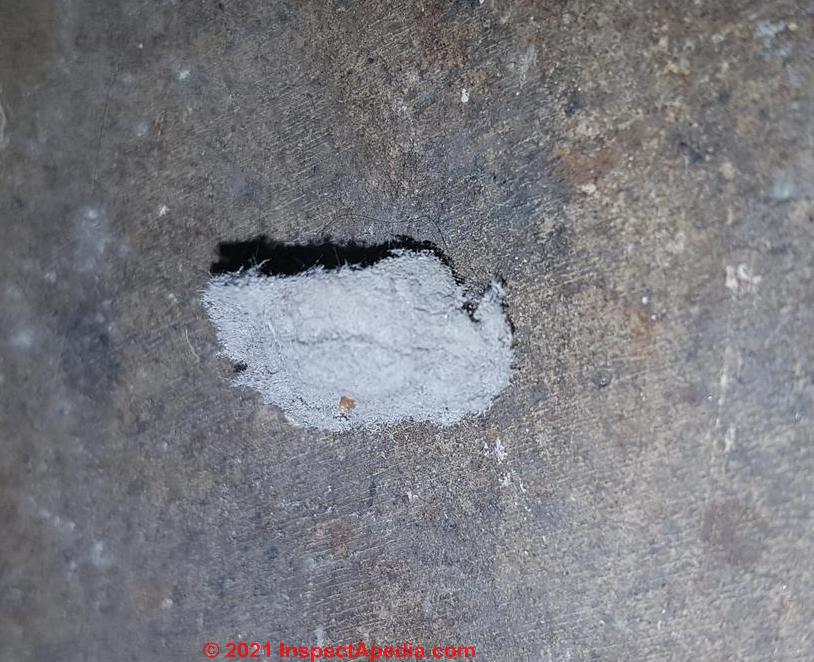
On 2021-02-01
by John -
Reply by (mod) - materials used to patch hold cut into roof sheathing - watch out for asbestos from cut-open insulated metal chimney sections
John I can't say with confidence what that is, though a guess would be a gypsum board or an asbestos-cement board that someone used to "patch" a roof sheathing cutout where perhaps previously there was a vent or chimney.
I would treat any fiber cement board material as presumed to contain asbestos or if you face a large expense, then test it.
Enlarging our photo I think I see fiberglass or a similar material as part of that roof sheathing patch job in the attic, and what looks like galvanized metal or maybe just roofing felt over the hole atop the roof deck - (can't quite say from the photo).
Watch out: The gray fibrous material in your prior photos is a bit unusual: I'm not sure what we've got there; I'd have guessed a mineral wool material but some of it looks as if it almost crumbles to dust.
Watch out: If someone cut up an old insulated metal chimney such as a multi-wall "metalbestos" flue or similar material, then it is very possible, even likely, that that insulation is an asbestos product.
I'd avoid tracking that dust into the building, wear appropriate PPE, and if there's more than a trivial amount, either give me a sharp close-up look or have a sample tested for asbestos. And let me know what you're told.
Dark Gray Insulation gets dusty when aged or "breaking down"
In this photo you can see how it gets dusty once it breaks down.
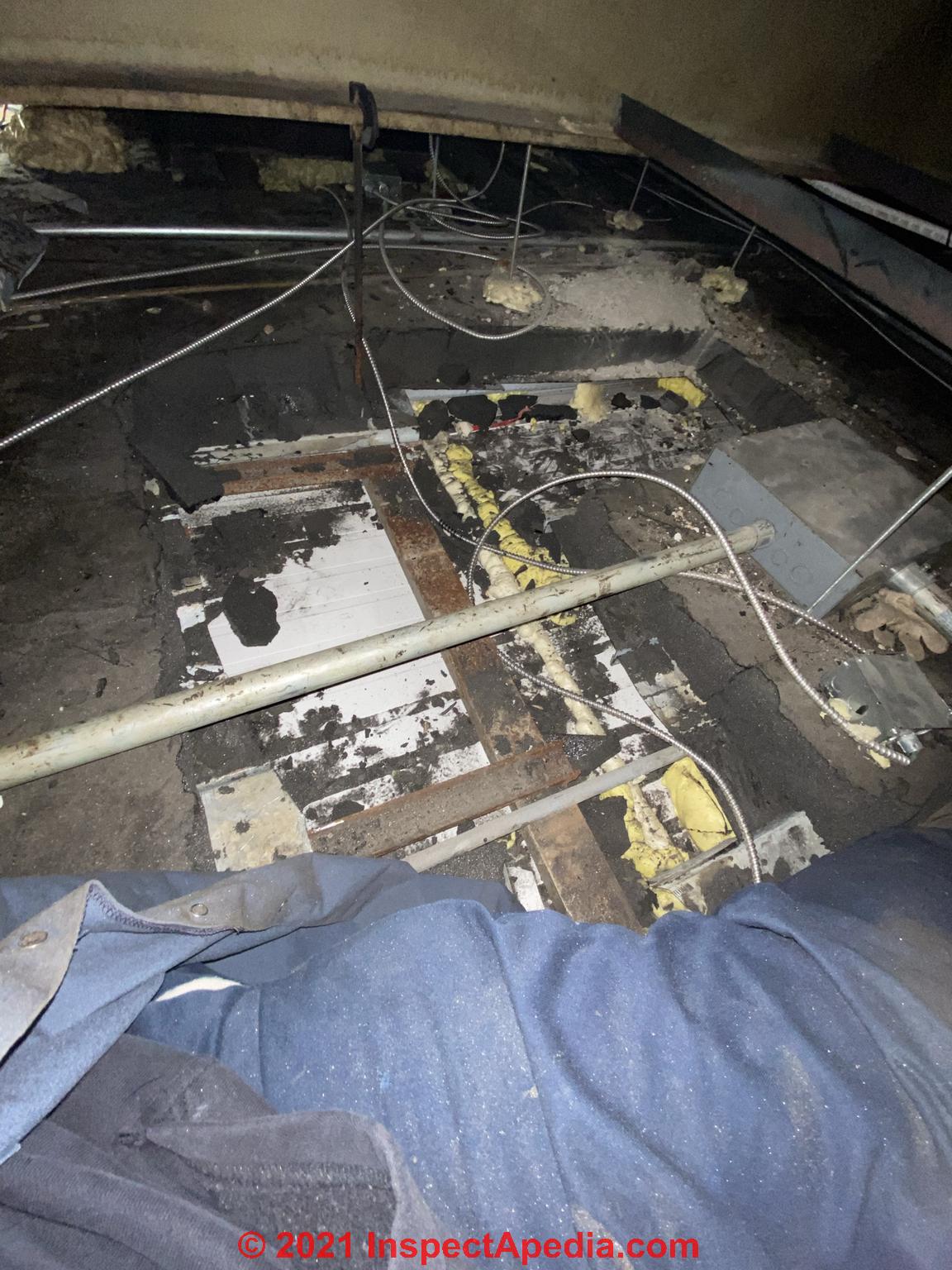
- On 2020-12-08 by JB -
Reply by (mod) - blurry photo of cellulose insulation
The photo is too distant and blurry for me to be sure but that looks like cellulose insulation
...
Q&A on Gray Insulation Identification
Confirm that this gray attic insulation is cellulose?
Just following up as I’m not positive my other comment went through. After re-reading my inspection report, the insulation in the Attic was listed as Cellulose.
Hope the wall insulation is the same and that someone here can confirm. Thank You! - On 2020-05-06 by Carol
Reply by (mod) - Cellulose
Carol,
that looks like CELLULOSE insulation - see CELLULOSE LOOSE FILL INSULATION for details.
Is this packed-in gray wall insulation asbestos?
Hello! I had a leak under my window and when the drywall was pulled off to investigate this was the material found: it was hard packed but when the contractor pulled it out it is very crumbly.
(I wish I had a hard packed photo!). He feels it is fine and, perhaps I have watched too many DIY shows, but I am freaking out that a toxic material has been unearthed.
Hoping you can help ease my mind. Thank You.
(Home was originally built in the 50’s, small ranch row house but I’m unsure of what updates were done since). - On 2020-05-06 by Carol -
Reply by (mod) - No: vnothing to fear: cellulose insulation
Carol
That is almost certainly a wood product or cellulose insulation - compare your insulation with
Identify loose fill attic insulation - gray fluffy
I'm looking at a 1930s house that the inspection report listed as having loose-fill fiberglass insulation in the attic, however the photo of the insulation in the attic doesn't look like fiberglass to me. - On 2020-06-23 by Lisa
Reply by (mod) - that is loose fill cellulose, not fiberglass.
Lisa
That photo looks to me almost certainly like loose fill cellulose, not fiberglass.Looks as if your inspector made an error in the report.
Identify gray insulation in 1907 house
House built in 1907. Behind plaster and lathe. Black and wooly kind of glistens like fiberglass. I have some concerned spectators
On 2020-07-11 by JMO
Reply by (mod) - Mineral wool
JMO that looks like rock wool or mineral wool - see that item in the article above and in detail
at ROCK WOOL - MINERAL WOOL INSULATION - home
Also check out the examples given
Identify loose lay greyish brown insulation with wood or paper chunks
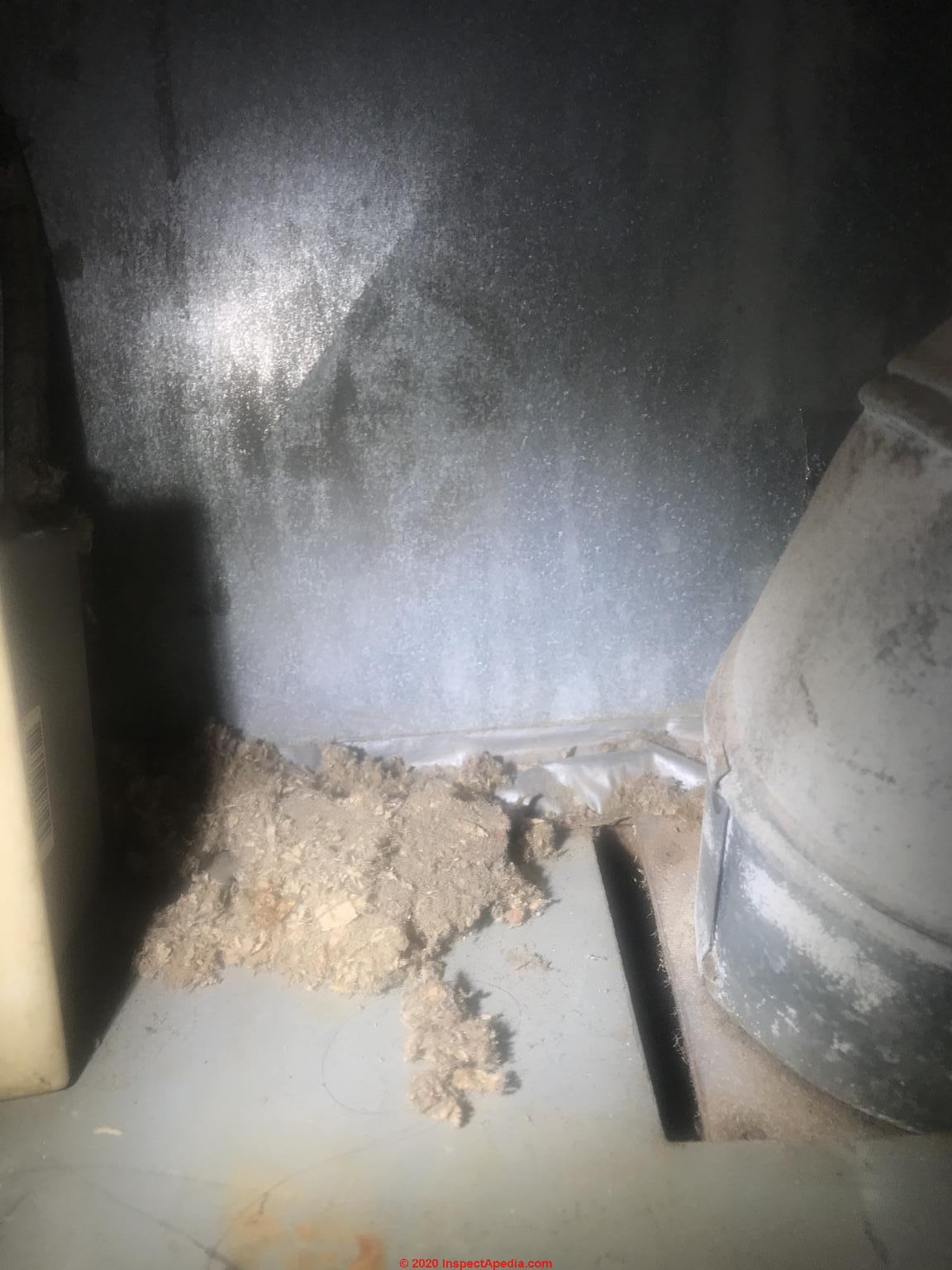 Loose lay greyish brown insulation with wood or paper chunks cant tell to scared to touch it, also has green and pink/red flecks like paper
Loose lay greyish brown insulation with wood or paper chunks cant tell to scared to touch it, also has green and pink/red flecks like paper
but looking at it in operson it looks greyish more so than brown but when i take a picture it looks more brownish in the picture
could be the light playing tricks but in real like its a couple more shades greyish brown instead of brownish grey.
This loose lay insulation was in my attic,
I fell asleep on my couch and a handy man knocked it down all over me and left me to sleep inhaling it for six hours until i woke up does this look like asbestos?
I'm getting it tested soon with my next paycheck
but for right now i need an answer to hopefully either give myself peace of mind or to know whether to move out ASAP.
I had the flashlight shining on it as well its a grayish brown, appears to maybe have wood chips? Without the light shining on it it looks more grayish?
but with the light shining on it and my phone light it appears more brown? and pink and green specks of paper in it if need be i could possibly upload a higher definition picture
I'm just not touching it keeping my door shut in my laundry room not going in there for now as to not disturb it i have really bad/sensitive lungs as is.
On 2020-07-20 by Luna
Reply by (mod) - cellulose insulation is not an asbestos product
Luna
You're second photo posting looks like loose-fill or blown-in cellulose. That's basically a chopped paper insulation treated with a fire retardantFollowup by Luna Gray fluffy insulation - blown-in cellulose?
So the second photo looks like loose blown in cellulose? thats an upclose image of the insulation.
Reply by (mod) - probably cellulose
Cant quite make it out for sure but while my first thought was cellulose insulation, I also think I see small fibers as in rock wool or chopped fibergass. We need a sharper photo.
But my best guess is cellulose - I think I see bits of newsprint with lettering on it such as an "O" on paper in the left center of your photo.
Identify gray insulating board ceiling material
Can anyone identify this? Thick board covering an old larve and plaster ceiling on a small section within a room.
On 2020-07-23 by CHARLES
Reply by (mod) -
Charles:
I see what looks like plasterboard used as a plaster base.
Help me out: what is "old larve and plaster" ? Lath?
And give me the country, city, and age of the building where this ceiling is found.See the photos at GYPSUM BOARD ROCK LATH SYSTEMS
Thanks
What's this dark gray insulation in a garage wall in North Carolina home?
This was found in the garage behind the drywall on the wall facing the dining room. We were trying to find the stud (needed a longer screw), and ended up tearing a hole in the wall when we came across this. What type of insulation do you suppose this is?
I’ve researched cellulose, Vermiculite, and rock wool. House is in Charlotte, NC. The fibrous aspect is concerning, but it’s a darker gray than anything I’ve seen. - On 2020-01-19 by Kimberly
Reply by (mod) -
Kimberly
That looks like
BALSAM WOOL BATT INSULATION
Take a look at that article and let me know what you think.
Also see MINERAL WOOL - ROCK WOOL INSULATION
Fiberboard insulation or insulating sheathing are escribedat FIBERBOARD SHEATHING
In the photo I attach below, an edited version of yours, the red arrow points to what looks like loose fluffy wood fibre material - that'd be Balsam wool as you'll see in that article.
However (and I can't see enough here to be sure) the yellow arrow points to what looks like compressed material - it may just be your camera angle. but if this brown wood fibrous material is in fact mostly hard and installed as a panel or sheet that's less than an inch thick, it'd be fiberboard insulating sheathing.
It would help to know
1. how is the wall framed and what's the depth of the wall cavity as I can't tell from your photo but it looks as if we may be peering into a rather thin wall cavity, just an inch or so.
and
2. How old is the building where this insulation was found?
Is this brown/gray cementious material asbestos in our 1955 rental house?
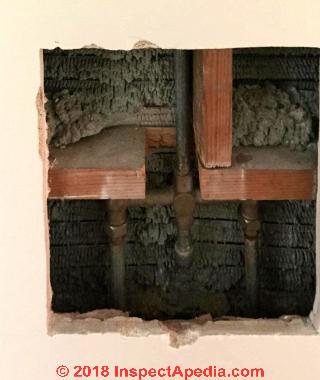 We are getting ready to rent (have put down a deposit) on a house built in 1955.
We are getting ready to rent (have put down a deposit) on a house built in 1955.
There is this easily accessible panel on the wall opposite the bathroom for access to the plumbing for the tub. Is or could this be asbestos?
We have a 2 year old daughter and don't want to take any chances! - On 2018-05-16 by shelby.hudson655321
On 2018-05-16 by (mod) - that's plaster base coat on expanded metal lath - not insulation and not asbestos
Shelby
Your photo shows cement or plaster extruding through expanded metal lath, no doubt providing the wall onto which bathroom tile was affixed.
While some plaster in older homes might (rarely) contain asbestos, this is not a friable material.
Even if the plaster contains asbestos you would have to grind, saw, or chop the material to create dust and thus to create a measurable hazard.
In sum, undisturbed, this plaster in the plumbing access is not a child hazard.
See PLASTER LATH, METAL for more details and where your photo will be a helpful addition.
Also see details found at ASBESTOS in PLASTER
Followup by shelby.hudson655321
We are getting ready to rent (have put down a deposit) on a house built in 1955.
There is this easily accessible panel on the wall opposite the bathroom for access to the plumbing for the tub. Is or could this be asbestos?
We have a 2 year old daughter and don't want to take any chances!
This gray stuff looks like insulation: is it?
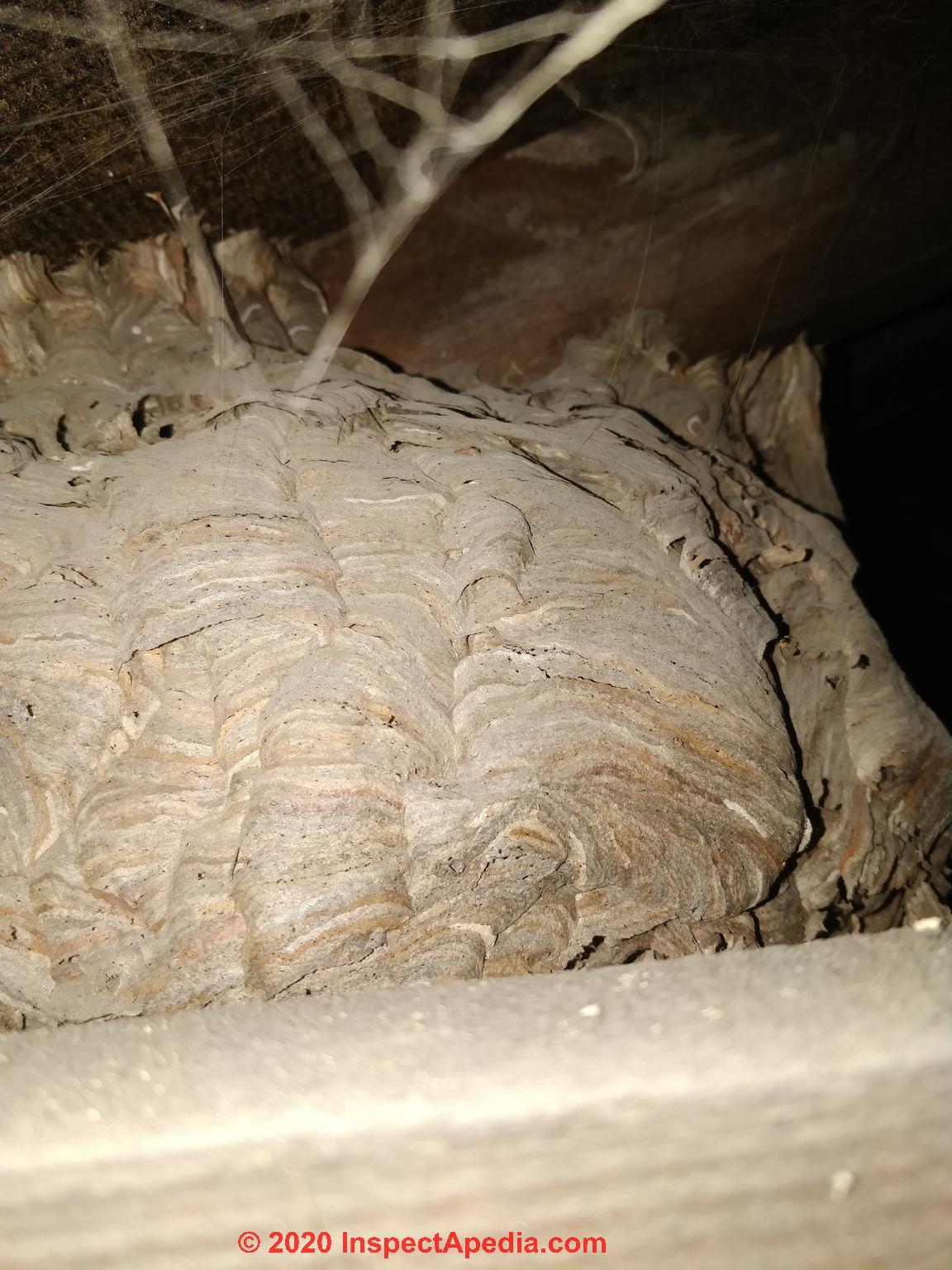 Hi,
Hi,
I've taken a picture of my roofspace and there is something that looks like insulation but I'm not quite sure about it.
Would you be able to help me identifying what it is?
Thank you! - On 2020-11-23
by Olivier
Reply by (mod) - Identify gray papery stuff in attic: don't poke at hornet's nest found in attic!
Oliver
Watch out:
I would keep away from that area and keep that space closed until you've had an exterminator look at that because I think that's almost certainly a hornet's nest.
Don't disturb the nest; particularly when you're in a confined space such as an attic, stirring up hornets can result in getting badly stung.
...
Q&A on Light Gray Insulation Identification
Does this white-gray insulation look like loose fill fiberglass insulation or ?
Does this look like loose fill fiberglass insulation or ? (photo above) -On 2018-04-08 by Jay
Reply by (mod) - Mineral wool insulation
That looks like mineral wool or "rock wool" but (less likely) could be unusually dirty fiberglass loose fill.
What is this white fluffy cottony insulation mixed with grey foam in Phoenix A - 1979 home?
Any idea what this stuff is?
There is a combination of white fluffy, cottony insulation, mixed with grey foam looking insulation? The house is in Phoenix, AZ, built in 1979. - On 2018-03-23 by Mitch
Reply by (mod) - Chopped Fiberglass insulation
Looks like chopped fiberglass. Can you get a sharper photo?
What is this light gray / tan soft furry insulation in our attic? Doesn't burn; feels like flour.
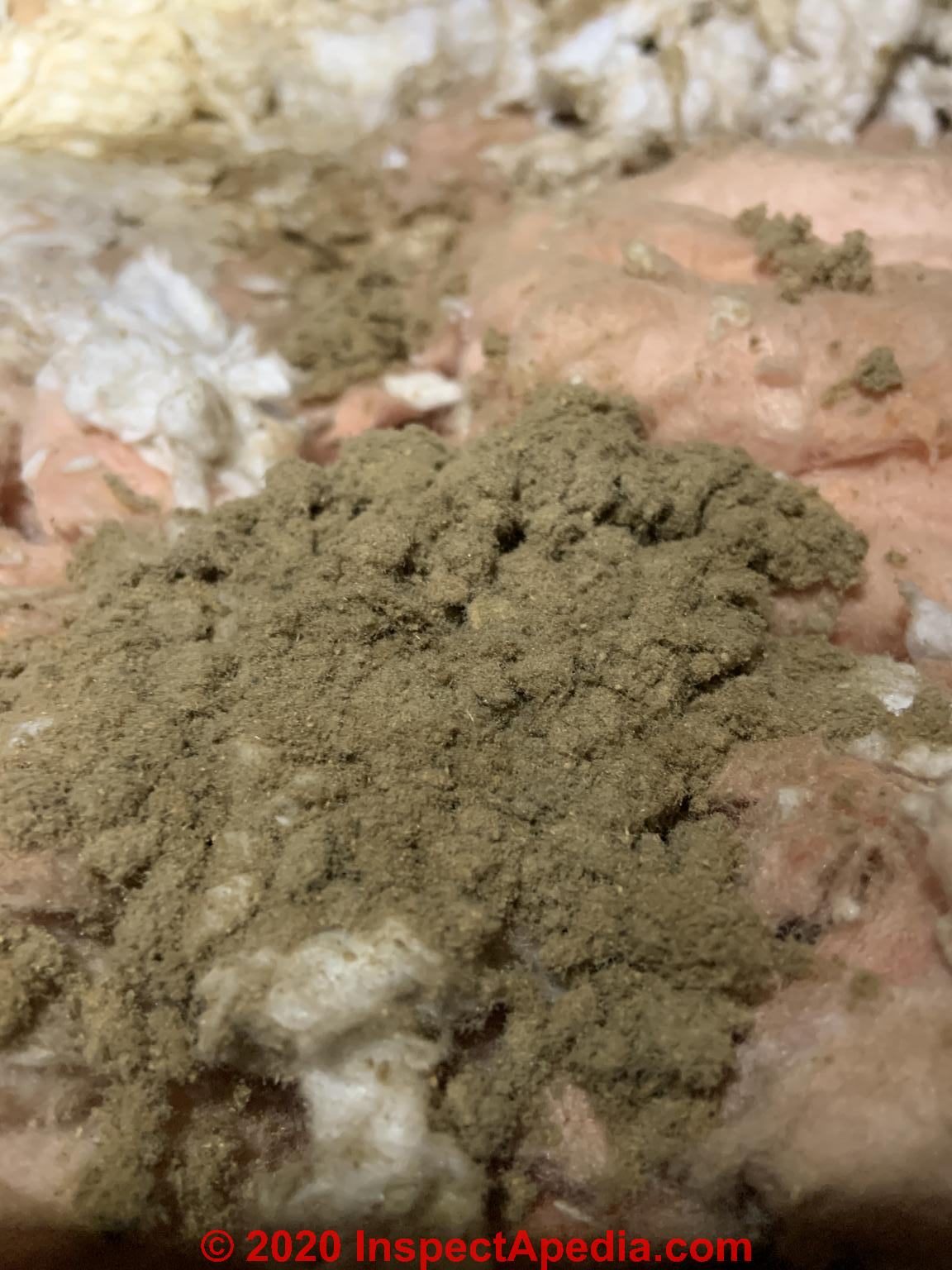 Been working in the attic of my 1946 home doing some rewiring. There is 3 layers of insulation in here from previous owners for some unknown reason.
Been working in the attic of my 1946 home doing some rewiring. There is 3 layers of insulation in here from previous owners for some unknown reason.
Starting from the top is a super tall fluffy white blown in insulation. This is new within the past 20 years.
It seems to be papery material. Not looking to identify this. Then there are some pink fiberglass bats under that (only in certain places for some reason).
Then the layer closest to the ceiling joists (i.e. most likely the original insulation) is what you see in the picture.
It is about 3" deep and while it looks a little clumpy, it is super fine, almost powdery by feel. Grabbing with gloved hand almost reminds me of flour
It compresses pretty tightly. Doesn't dissolve in water and when flame is applied, it embers up and chars, but does not catch.
Once flame is removed, ember immediately goes out and it smokes a bit. The smoke smells like paper or wood (almost smells like patchouli incense even.
Not fibrous, but more cellulostic in nature. I am thinking a paper or cellulose product. Just curious what you all think. - On 2020-09-11 by Mike M.
Reply by Mod
Mike:
In your photo we see loose-fill or blown-in chopped white fiberglass insulation, pink fiberglass insulating batts, and yes, that brownish-gray stuff is probably cellulose (chopped newsprint) insulation.Followup by Mike M.
That is what I was thinking and I appreciate the confirmation (the second opinion will make my wife feel better for sure!). Thanks for taking the time. This site is one of the most useful resources on the internet!
Reply by (mod) -
Thank you for the kind comment, Mike. We've worked hard on this resource for over twenty years, so I'm particularly grateful when readers find it useful. We also welcome your criticism, questions, content suggestions and photos.
Daniel
Is this gray chopped up insulation in our attic asbestos?
I was told that this material exists in an isolated area of our attic.
Is it asbestos?
On 2020-09-14 by Alice -
Reply by (mod) - No, that's cellulose insulation, perhaps conmbined with fiberglass insulation
Alice
That looks like a mix of loose fill cellulose and mineral wool or fiberglass insulation.
What is this gray fibrous insulation in our ceiling?
Picture to get a better view! - On 2020-10-03 by Diana
Reply by mod - gray mineral wool
Looks like gray mineral wool insulation
How to tell cellulose vs. loose fill mineral wool; and which one contains asbestos?
What is visual difference of cellulose and lose fill mineral wool which contents asbestos?
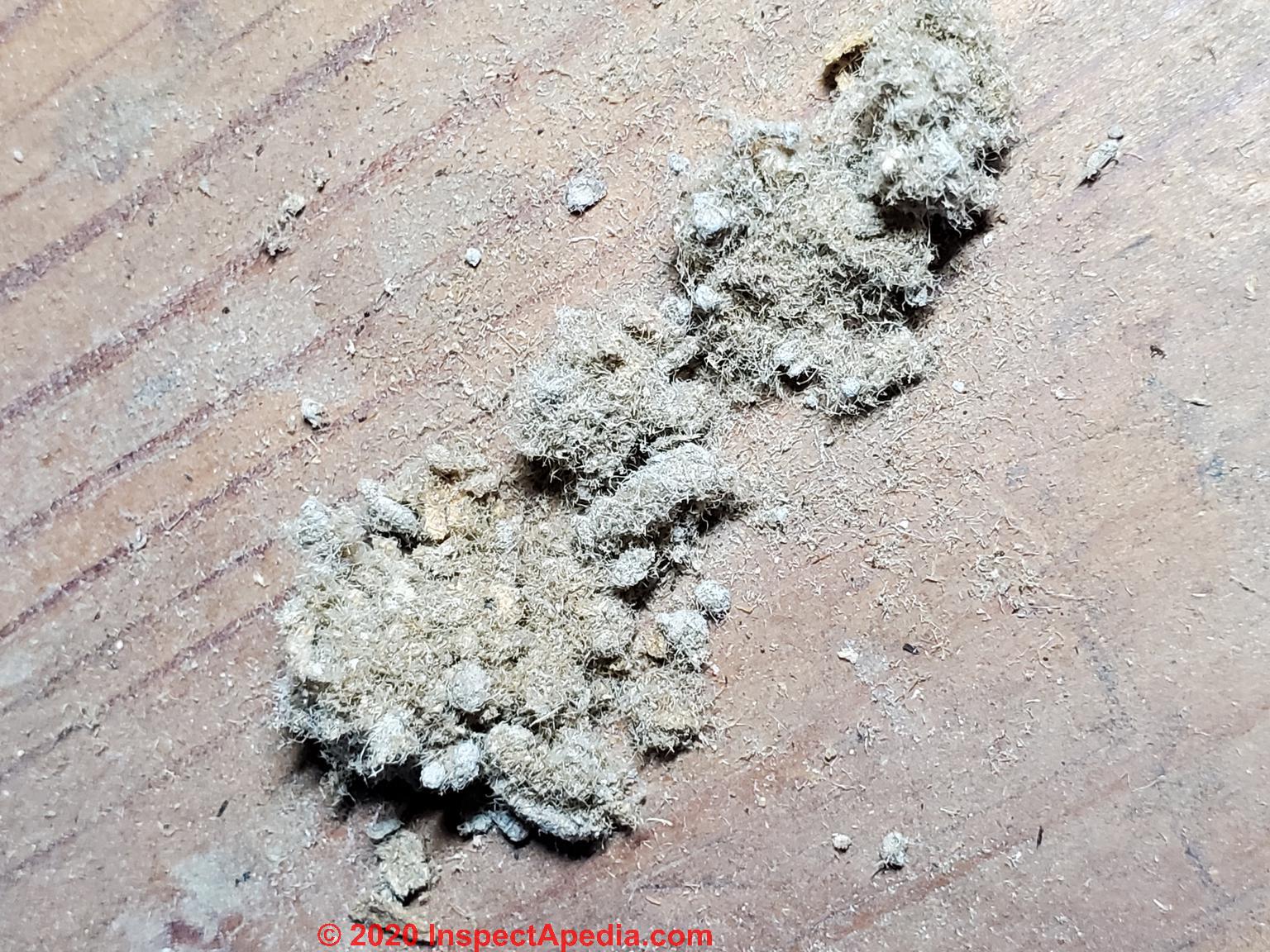
- On 2020-11-18 by Jin
Reply by (mod) - chopped celluylose insulation vs mineral wool
Jin
In the ARTICLE INDEX at the end of this page you will find articles and example photos that identifyand
MINERAL WOOL - ROCK WOOL INSULATION
Those articles include lots of identification photos as well as description. Please take a look.
I must add that the last part of your statement that says loose fill mineral wall which contains asbestos is basically incorrect.
Mineral wool is not an asbestos material. It is a fibrous insulation made from a combination of stone and blast furnace slag.
Is this light gray insulation in our 1910 home vermiculite?
Looking to identify what type of insulation this would be.
- House built 1910
Particularily, i want to know if this is Vermiculite...for obvious reasons
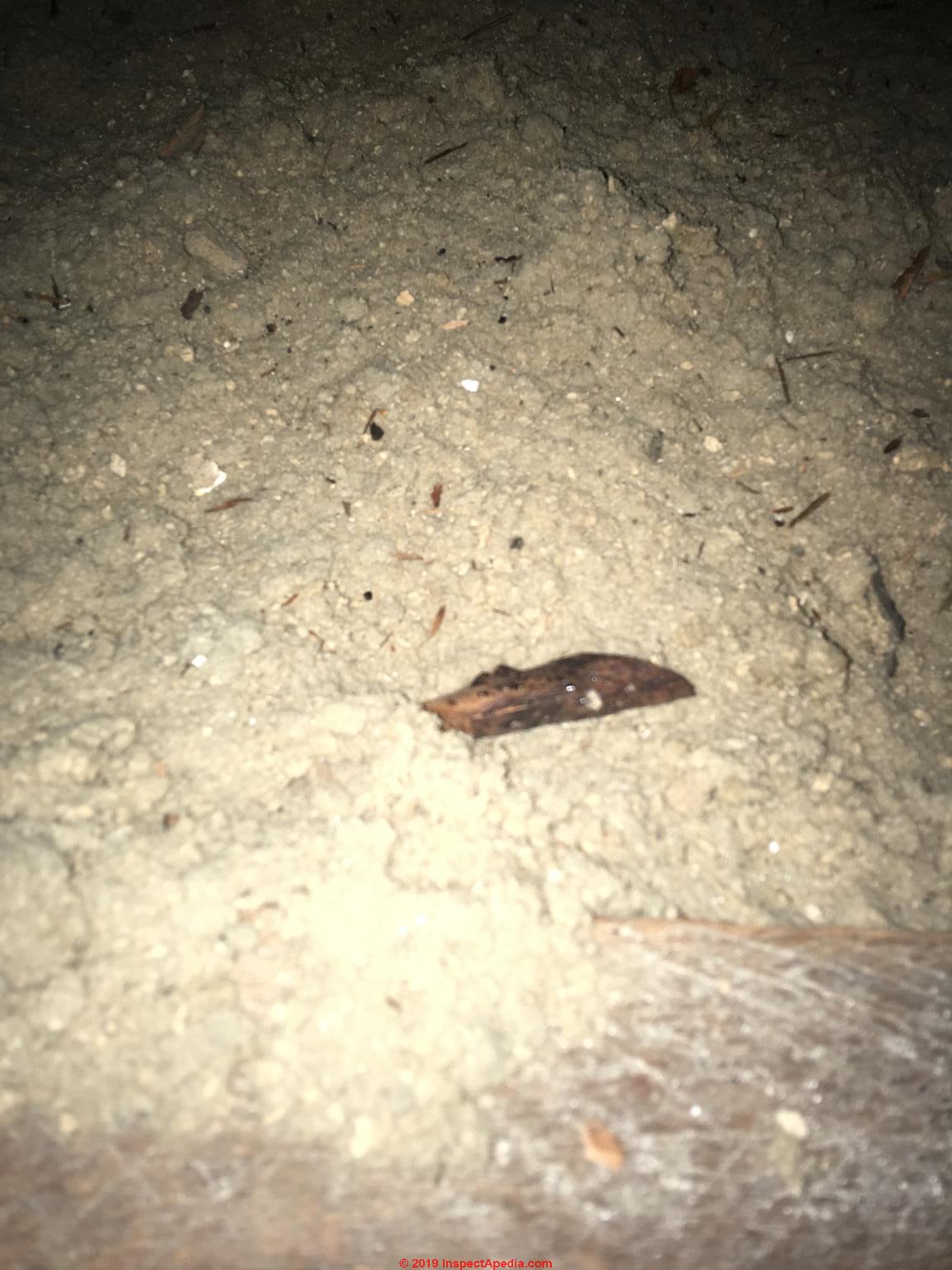
On 2019-01-18 by Cam
Reply by (mod) - cellulose insulation
Cam - that's cellulose - a chopped paper or newsprint insulation.
See details at CELLULOSE
What is the second layer of Light Gray insulation under that pink fiberglass?
We seem to have two layers in a house we bought. The top layer is 'pink fiberglass' what is this bottom layer? The house was built in 1953.
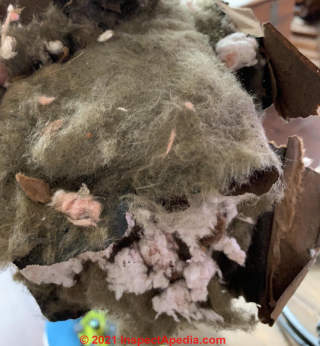
- On 2021-02-05 by JVM -
Reply by (mod) - recent chopped fiberglass & older fiberglass or 1950s mineral wool insulation
JVM
Thanks for the photo and question; that older darker-colored fibrous insulation is either mineral wool or a fiberlass product. Most-likely it's mineral wool.The pink insulation looks a bit chopped up fiberglass insulating material - that woud be common if it was added by pouring or blowing-in fiberglass loose-fill insulation .
...
Q&A on Orange Insulation Identification
Below we show orange colored foam insulation used to provide a fire block around building wall, floor, or ceiling penetrations for piping or wiring.
Several foam insulation products may look orange in color. So see this article that sorts out all of the various types of foam insulation:
Identify orange layer of insulation - powdery - in 1970's home
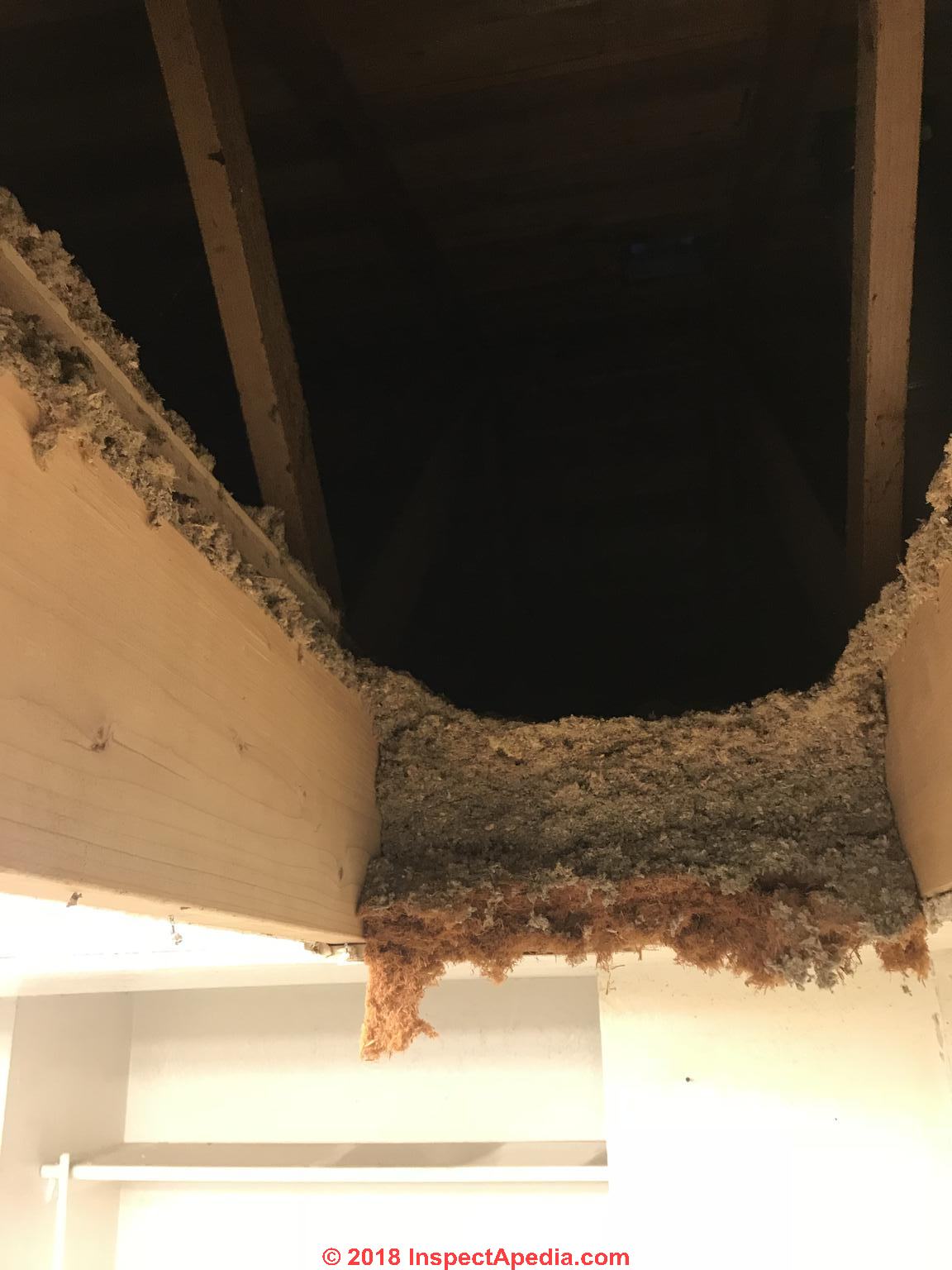 I need help identifying the orange lower layer of insulation in this photo.
I need help identifying the orange lower layer of insulation in this photo.
It was very powdery when we disturbed it.
This house was built in the 70’s - On 2018-09-30 by Craig Waldron
Reply by (mod) - blown in cellulose atop a thin layer of fiberglass insulation
the photo is a little blurry but I think I'm seeing fiberglass perhaps with an outer coating of cellulose insulation. I don't see any insulation I'd call orange in this photo, it's more tan or brown.
If it's really crumbly brown foam, then
See UREA FORMALDEHYDE FOAM INSULATION, UFFI
Also see URETHANE FOAM INSULATION
as UFFI was widely installed in North American buildings in the 1970s.
But MORE LIKELY we're looking at a wood-based fiberboard product - compare what you have with
FIBERBOARD where we show photos of yellowish fiberboard panels used on walls and ceilings in older homes.
...
Q&A on Pink Insulation Identification
Pink fiberglass insulation like that shown folded back in ouir photo above is an Owens Corning Product.
Identify dirty pink fiberglass insulation
Have this peaking out from edge of carpet under an electric baseboard heater in my attic is it asbestos containing?
I think it looks sort of like dirty fiberglass insulation that had been stuffed under the floors what do you guys think want to remove/cover it up.
On 2020-09-09 by Steve
Reply by (mod) -
That's pink fiberglass insulation with a big dose of house dust, probably from air leakage.
It loopks to me as if someone tried to poke fiberglass along the edge of a leaky floor-wall joint.
I'd investigate the air leak and would consider a more-permanent seal.
...
Q&A on Soft or Powdery Insulation Identification
To sort through types of foam insulation that may be spongy or in the case of UFFI, easily crushed to a powder, and may be white, tan, yellow, orange, or in board products, blue or other colors.
see FOAM SPRAY INSULATION TYPES
or for pink, white, yellow or blue foam board products
see FOAM SPRAY INSULATION TYPES
Below we show both white and yellow-orange UFFI.
Is there extra cost to renovate a home with UFFI?
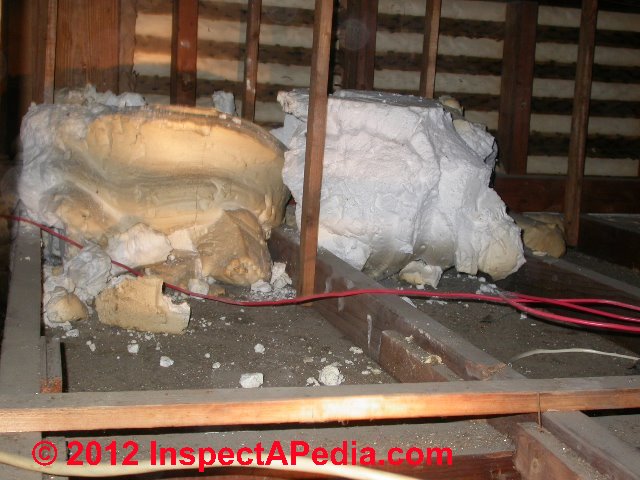 If a home is insulated with UFFI, would renovations to those areas cost anymore because of special precautions(if any) needed to remove UffI? - On 2019-07-23 by Melanie
If a home is insulated with UFFI, would renovations to those areas cost anymore because of special precautions(if any) needed to remove UffI? - On 2019-07-23 by Melanie
Photo by InspectApedia's DJF: orange-tan-yellow UFFI foam at left and white UFFI foam at right in a New York home insulated with this foam product in the 1970s.
Reply (mod) - renovating a home insulated with UFFI
Melanie
UFFI by now will have off-gassed any formaldehyde that might have been a concern when installed in the 1970s.
My experience is that the material is quite fragile and when disturbed can make a dusty mess.
I'm not sure there's a good reason to remove it;
However depending on the insulation mix at time of installation, shrinkage can be a problem: leaving air gaps around the sides and top of insulated wall cavities.
See details at
UREA FORMALDEHYDE FOAM INSULATION, UFFI
Identify this soft, bright white foam insulation
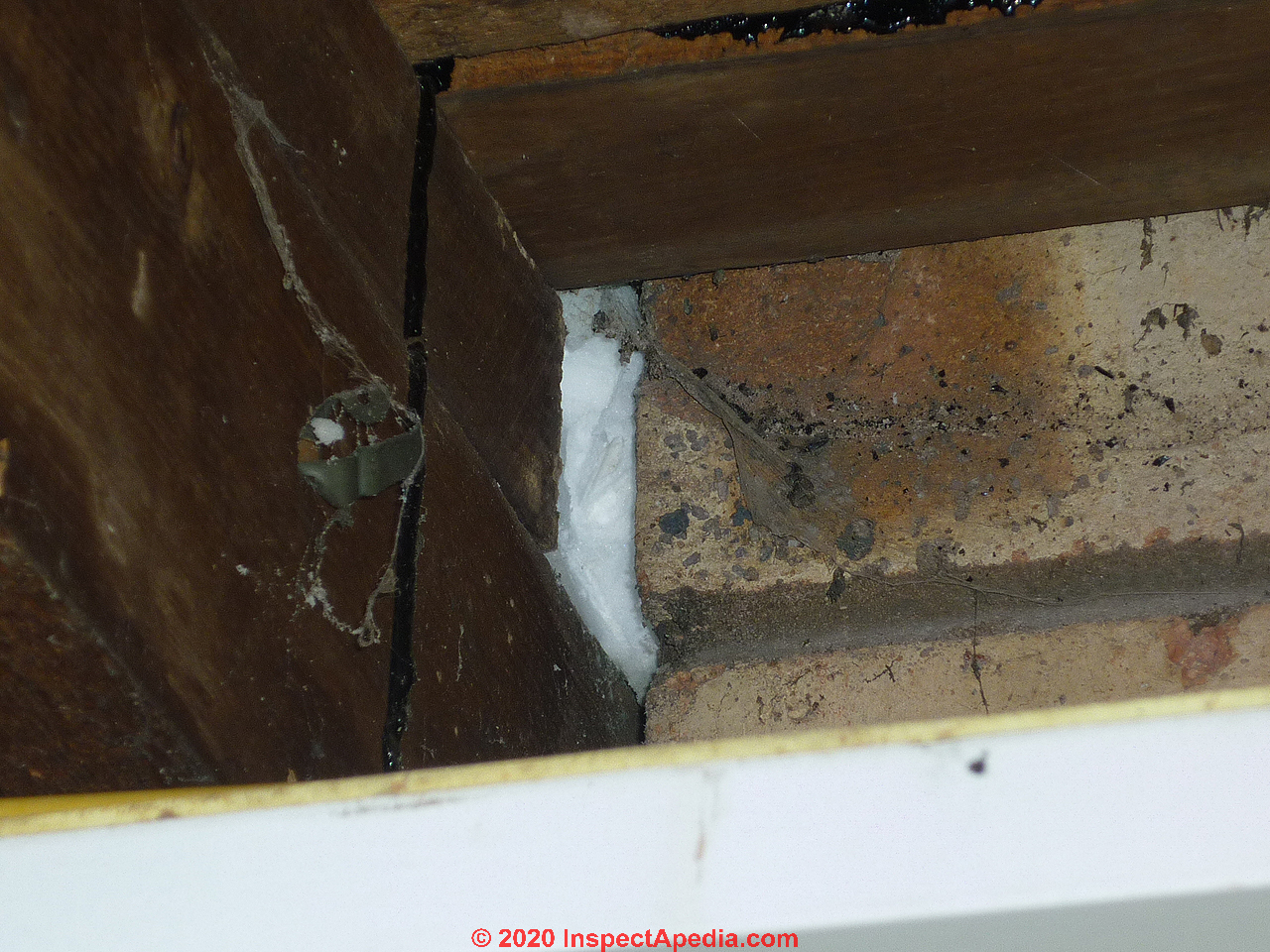
Anonymous-ls asked:
[could] you take a quick look at the attached photos. It is some sort of insulation around the joists in my garage. It is powdery and crumbles when touched.
The colour is bright white. I am concerned it could be urea formaldehyde insulation but i read that this is yellowish in colour. - Re-posted from private email
Moderator reply: foam insulation may be UFFI - what's its age?
The photo is not quite sharp enough for me to be sure what that is - it could be UFFI, as you'll see in our identification photos
Take a look at the photos found
at FOAM SPRAY INSULATION TYPES including both modern sprayed in place foam insulating products
at inspectapedia.com/insulation/Foam_Insulation_Identification.php
also
See UREA FORMALDEHYDE FOAM INSULATION, UFFI inspectapedia.com/insulation/UFFI_insulation.php
Also see URETHANE FOAM INSULATION inspectapedia.com/Energy/Polyurethane_Insulation.php
usually UFFI is yellowish but I've occasionally seen a white mix.
If UFFI was blown into the home you'll almost always find oozing out bits in more than just one location.
As you'll read in our articles on this topic, UFFI raised formaldehyde offgassing concerns when it was newly installed.
If it is UFFI there is no reason to be scared - there won't be measuring offgassing of formaldehyde in such an old installation.
Take a closer look. IF the material crumbles to a white powdery dust when poked or crushed between forefinger and thumb, it's probably UFFI. If it doesn't crumble but is more-durable, spongy, for example, it's another foam product. If it's fibrous it's insulation.
If it's damp and sticky it could be mineral effloresence.
It would be helpful to know the country, city, and age of the building and its insulation and retrofit history.
How do I identify a soft flaky powdery insulation in a commercial property & what about mold?
Does anyone know the type of this insulation. It is sprayed on in the basement of a commercial store and it has mold on it.
It is soft and flakes off like a powder when brushed. I would also like to know how to address the mold.
thanks - On 2020-09-24 by Nick -
Reply by (mod) -
Nick
Try using the "add image" button - you can add one image per comment.
Generally moldy insulation cannot be cleaned; it needs to be removed and the exposed hard surfaces cleaned before re-insulating.
First be sure it's truly mold.
...
Q&A on White Insulation Identification
White fibrous insulation in a 1920s Canadian home
Hi - any thoughts on what this might be?
In an attic, house built ~1920 in Ontario, Canada; attic may have been insulated in a reno dating sometime between then and 1970ish
- On 2020-08-02 by clifford -
Reply by (mod) -
Looks like mineral wool.
Identify this white insulation in a 1944 home in Virginia
I am trying to identify the type of insulation in my attic. 5he house was built in 1944 and is northern Virginia.
I suspect the insulation is original. It looks to be a white, batt-type insulation. It has a sparkle or shine in the sunlight.
Due to the age, it disintegrates into dust when I compress it between my fingers. Also, should I remove this before adding new insulation? On 2020-07-26 by James
Reply by (mod) -
The photo is a bit blurry but it looks like white fiberglass. Mineral wool, the other candidate is usually more coarse.
See if you can find markings on the kraft paper wrapping.Followup by James: Photo of white fibrous insulation for identification
Thank you for your response.
Here's another photo that might help. If its fiberglass, but it is compacted and disintegrating, should I pull it out and just start fresh or just add on top?
I didn't see any markings on the paper, the paper is just black.
I'll look at some other sections for markings. - On 2020-07-27 by James-
Reply by (mod) - white fiberglass?
James that looks like white fiberglass. Less likely, white mineral wool.
See details
at Johns Manvlle Spintsulation Fiberglass Insulation (C) InspectApedia.com
See FIBERGLASS INSULATION IDENTIFICATION & PROPERTIES - properties for a key to identifying fiberglass building insulation brands & products.
Is this asbestos or light coloured fibre glass insulation?
Is this asbestos or fibre glass?
On 2020-02-14 by John
Our home built in Grand Rapids, MI in 1910. We recently purchased just a few months ago and have been living in it.
Upon inspecting the attic, it doesn't appear from what I can see that we have asbestos. I'm not quite sure, it's black and woolly in appearance; contrasted against the cellulose beside it.
Reply by (mod) -
John
From your photo and discussion it sounds as if we're discussing mineral wool insulation or "rock wool".
In the ARTICLE INDEX take a look at the articles and photos on MINERAL WOOL - ROCK WOOL INSULATION - home
Help identify this white insulaton on the ground outside our home
 Can you please help identify this insulation?
Can you please help identify this insulation?
I have more pictures if needed.
Some of it comes in big sheets with the standard looking “brown paper” covering one side and the “sparkly” yellow cotton candy looking material on the other side.
We also have these clumps of white fuzz which have been blowing around our complex for 4 weeks.
I try to rake it up, but it’s nearly pointless.
We’re concerned about our pets’ health, so wondering if someone can help me identify and possibly recommend a more effective “cleanup” idea.
Our property managers have assured us it’s not fiberglass, but it looks very much like fiberglass to my untrained eyes. I trust my gut and don’t want to risk harming our animals.
On 2020-09-07 by Katie Nelson -
Reply by (mod) - fiberglass or mineral wool insulation
Katie that view is a bit distant but I suspect we're seeing white fiberglass insulation. Post additional photos (one per comment) showing any markings or stamps on the "brown paper" wrapping and showing a sharp-focused closeup of the material if you can.
For an outdoor spill of insulation such as in your photo I use a large shop vac to clean up the mess as otherwise it'll linger and be unsightly.
Followup by Y - Is this white insulation fiberglass?
Do you think the white stuff is also fiberglass?
If so, I assume it’s not the safest thing to have floating around and we should continue to keep our pets (and ourselves) away as much as possible?
Reply by (mod) - yes
Yes, the white and yellow insulation are most-likely fiberglass.
There are also versions of mineral wool insulation that are white and clumpy like your example.
HEPA-vac if you have a lot of such dust; dampwipe hard surfaces.
It's normal and common to find some insulation fibres in indoor dust, but high levels ought to be cleaned and the source fixed;
Also see details at
Followup by Katie Nelson
Thank you so much for your quick response. (My apologies for the accidental comment below.)
Thank you so much for your help, Mr.Friedman!
Reply by (mod) -
Katie
That's Certainteed fiberglass insulation. You can see the product MSDS here:
CERTAINTEED FIBERGLASS INSULATION SDS [PDF]
What is this white insulation in an 1860's home in Northeastern U.S.?
Purchasing a house that was built in the 1860s in the north east.
Found this insulation in the attic and also in the basement along the exterior wall header cavities. It is also falling down on to the basement floor.
Wondering how concerned I should be that it could contain asbestos. Any thoughts would be appreciated!
Thanks! - On 2021-01-02 ames
On 2021-01-02 - by (mod) - Mineral wool insulation photo
James
That's mineral wool
Identify this white fibrous clumped attic insulation in our 1947 home
Moved into anew place and was putting some things away in the attic.
The floor boards stopped and the insulation was exposed in some areas. The house was built in 1947. Can you help me identify. - On 2020-09-14 by Rob
Reply by (mod) - Mineral wool
Rob,
That looks like near-white or very light gray mineral wool insulation
What is this white chopped up insulation in our attic?
And this piece (above) is from the attic
From a 1920's-built home in Northern New Jersey. This piece is from the basement.
On 2019-04-09 by Mit
Reply by (mod) - mineral wool in a 1920's New Jersey home
Mit the insulation in your photos looks like mineral wool or "rock wool" - see details at MINERAL WOOL - ROCK WOOL INSULATION - home
That is not an asbestos insulation material.
Reader follow-up:
You were right. Just to be sure, I found a lab test kit on Amazon that was rated 5 starts; sent in a sample and it came back negative for asbestos with 95% being mineral/glass wool and 5% other nonfibrous material. Thank you!
What is this white powdery material found in the wall of an old house
Uncovered this white, powdery material stuffed behind galvanized water pipes in an exterior wall of a bathroom. Looks to be faced with paper. The house was built in 1863 and estimating the bathroom built early 1900s to 1930s. Also appears to be about 4” thick by 18” high.
More… upon further inspection: The stuff is fibrous, spongy and dense. 4 inches thick in the space between exterior and interior walls. Something that used to be in batt form that was easily cut and put into place, but has deteriorated over the years. Lots of very fine powder residue.
I vacuumed up the 2 small areas with a hepa-filter vac... 2 vac bags worth. Very heavy.. probably 25 pounds or more. - 2022-10-30 by Marco -
Reply by InspectApedia (Editor) - powdery, fibrous, spongy and dense insulation behind galvanized pipes may contain asbestos
@Marco,
" fibrous, spongy and dense. 4 inches thick in the space between exterior and interior walls" certainly sounds as if it were intended as insulation - crumbly, especially if it were more orange-yellow in color, would make me think UFFI,but
"Very heavy.. probably 25 pounds or more." could mean either that the material had gotten wetor
that it was mixed with plaster
If you can post a close-up photo of some of the material with good lighting we can take a better look.
From your first photo I think that red rosin paper was tacked to the wall studs as a backer behind plaster lath (unusual construction) and the white insulation was blown into the walls.
Watch out: We can't rule out that the material contains asbestos, though that would be unusual in a pumped-in or blown-in building insulation project.See ASBESTOS INSULATION for a complete guide to all forms of asbestos insulation found in or on buildings.
Please tell us the building location - country and city or province or state
Did you keep any samples of the material? If so I'd like to examine it in our forensic lab.
DanielFollowup by Marco - Soft Powdery White Insulation had 10% Chrysotile asbestos.
@Marco said:
Just to be safe, I sent a sample to be tested for asbestos and test results indicated 90% non-fibrous material, 10% Chrysotile asbestos.
As I mentioned in my post the material was very heavy: two 12-16 gallon vacuum bags weighed approximately 40 pounds leading me to believe that it could be cotton insulation.There was also a heavy paper backing facing the living space but no manufacturer labels or marks of any kind.
Please see attached photo.
Thanks.Reply by InspectApedia (Editor) - white loose-fill but heavy building insulation in a wall contains 10% Chrysotile asbestos
@Marco
Thank you for following-up - your lab test of that white loose-fill but heavy building insulation in a wall, finding 10% Chrysotile asbestos, will be helpful to other readers.
Indeed asbestos was used as building insulation, widely-so as a spray-on fire-resistance coating in commercial construction (including part of the New York City World Tower that was attacked and that collapsed in 2011) and it was used as well as a blown-in asbestos loose-fill insulation product, but frankly it's very rare for us to find that in residential buildings.
Please tell us the location of your building.On 2022-11-05 by Marco
@InspectApedia (Editor),
Thanks for the follow-up. The building is a residential Federal style brick exterior and plaster interior home built in 1863 in southeast Indiana along the Ohio River.
Finding this insulation between the plaster/lath interior and wood exterior walls (in this particular area only) was quite the surprise, likely placed there to prevent the enclosed water lines from freezing. It’s difficult to ascertain precisely when plumbing was installed - we are guessing early 1900s.The water lines in this area were galvanized steel pipes with threaded elbows. Drain pipes were cast iron. What insulation materials were available during that time period for this type of installation?
The only type of insulation on these pages that really fits the description is cotton insulating batts based on dimensions, density and weight, and does not appear that this was sprayed-in insulation based on the heavy paper backing and appears to have been shoved into place behind the water lines (see the attached photo).Is it possible that asbestos fibers were incorporated into the cotton to provide additional insulation?
The attic previously contained vermiculite that also tested positive for asbestos but was abated in 2020.
Thanks again.Reply by InspectApedia (Editor) - loose-fill asbestos and another filler material, used as cavity insulation in 1863 Indiana home
@Marco,
From your description that sounds like a loose-fill asbestos and another filler material, used as cavity insulation. Those products were available from the early 1900's but not often found in residential buildings.Possibly the owner/plumber/insulator had access to a commercial source such as boiler insulation.
I've come across this on occasion, such as an attic floor filled with corrugated asbestos paper insulation intended for other uses.
Followup by Marco
@InspectApedia (Editor),
Ok, thanks.
I still have some material that I can send you for analysis. What’s the mailing address?
Reply by InspectApedia (Editor)
@Marco,
To avoid spam and robots we don't publish our address in these comments but you can find it by following the contact link found at the top or bottom of any of our pages.
What is this soft white insulation found above plaster in an old ceiling? retrofit in 1925 Home.
Any ideas as to what this might be? Found above plaster in old ceiling.
Above is a picture of some taken out. Its soft to the touch almost like flour? - On 2018-06-02 by Mike
Reply by (mod) - soft plasterboard like material
Sorry no I really can't see enough. If the material is quite soft and crumbles easily it might be blown-in foam insulation.
Watch out: on rare occasions we've also found an asbestos-plaster type mix used as insulation in older buildings.
Before demolishing or making a dusty mess of the material in your photos, either have a sample tested for asbestos or treat it as PACM - Presumed Asbestos-Containing Material.
Daniel
Followup by Mike:
The house was built in 1925. Craftsman Bungalow. But I believe it was remodeled (second floor attic finished) in the mid 1930s
I have the original blueprints and an appraisal from 1939 which shows Mansville Rockwool insulation listed in the wall cavities (more of a brownish gold color and fluffy) and it says 1" insulation under second floor / first floor ceiling but doesnt specify what type it is
Reply by (mod) - UFFI?
How old might it be?
This doesn't look like UFFi but I can't rule that out. UFFI foam is more yellowish.
UFFI was a sprayed-in place foam insulation described
What type of insulation is this white stuff with a white wrapper?
Any idea what type of insulation this is? It’s in my garage the house has been redone but the garage is older not sure what it is. - On 2019-01-14 by Chris
Reply by (mod) - white fiberglass batts
Surprising - I'd like to see a sharper close-up of the insulation; from afar it looks like a long-fibre fiberglass batt but frankly I can't see enough to be sure.
Followup by Chris
I will get a better picture this week I agree it sort of appears to be like fibreglass in its texture and the appearance of the fibres themselves but I will get a more detailed picture for you!
Is ths white pebbly plastic insulation in our door dangerous?
Wondering if this is dangerous to children
This is a hole inside door
On 2018-12-30 by Carolanne
Reply by (mod) - Damaged styrofoam insulated door panel
I have not much context - country, city, age of materials ,type of door.
But from what I see that looks like styrofoam insulation - rather inert and thus "harmless" but of course should not be eaten as a small child might do.As a temporary "fix" pending door replacement or repair, I suggest buying some foil tape and taping over the opening.
Examples of white styrofoam insulation and insulating board are
...
Q&A on Yellow Insulation Identification
What is this yellow looking batt or blanket insulation withb paper backing: CertainTeed 1970
I found yellow looking batt or blanket insulation in my crawl space with a paper backing that had printed on it, “CertainTeed 1970”.
When looking up the CertainTeed company they said they used TONS of asbestos in their products for a long time but I can’t find specific mention of blanket insulation. I’ve also read that MOST blanket insulation does not contain asbestos.
My question is, what are the odds that this insulation contains asbestos?
Asbestos was reported in some CertainTeed drywall, not in fiberglass per-se. I pose that it would be there only by cross-contaimation.
See ASBESTOS in CERTAINTEED DRYWALL?
Here’s a pic of the paper backing - above
Here is a photo of the insulation itself - below
On 2020-07-07 by Jimmy
Reply by (mod) - Identify fiberglass insulation manufactured by Certainted St. Gobain, with a kraft paper backing.
That sure looks like fiberglass insulation manufactured by Certainted St. Gobain, with a kraft paper backing.
Yellow foamy chunks of attic insulation: Asbestos?
Hi Any idea what type of insulation this is? Asbestos?
On 2020-10-17 by Dominic C
Reply by (mod) - UFFI Foam insulation - not asbestos
I can't quite say Dominic because the photo is a bit blurry. Is that a crumbly foam material? Installed perhaps in the 1970s? If so it's perhaps UFFI? Urea Formaldehyde Foam Insulation.
See those details at UREA FORMALDEHYDE FOAM INSULATION, UFFI
Light tan / yellow fibers: asbestos or rock wool in 1960 Northern California home?
Asbestos or rock wool?
This is a closeup of the material. It comes from a 1960 nothern California house.
The material is in a few of the spaces between ceiling joists and only became visable when the original furnace was removed.
It does not burn but turns black when a flame is applied. The material is very light and fluffy.
- 2020-07-27 by rdy4trvl
Reply by (mod) - Neither: looks like wood or cellulose fiber
Looks like wood fibre
On 2020-07-28 by rdy4trvl
I would agree but what seems odd is it would not burn...just turned black.
Maybe it was treated with some type of fire retardant?
Reply by (mod)
Possibly - we can't tell by visual inspection alone if a material was treated with fire retardant. But if it does not burn that's a pretty good answer to your speculation.
What is this chopped yellow/brown attic insulation in our 1930's house
Hello, when replacing a ceiling bathroom fan, this type attic insulation became disturbed.
House built in 1930’s but cannot confirm timing of the attic insulation. I’m trying to confirm if asbestos material? - On 2020-06-08 by Craig
Reply by (mod) -
That looks like mineral wool insulation - please check that link and the photos given at
Thanks for asking, Craig
What is this yellow insulation around pipes at the floor of my Brooklyn NY brownstone? Asbestos in it?
Can someone identify this insulation for me? There is so little visible that I’m having trouble using the guides.
It looks like yellow cotton to me. It is possible that it is quite old. It has been here since I’ve lived in the house (20 years) and the building is a Brownstone in Brooklyn so it may well be much older. Might it contain asbestos?
On 2018-10-07 by Perry -
Reply by (mod) -
Perry
At the opening where piping penetrates a wood surface , probablhly a floor, I see yellow fiberglass insulation.
On the piping itself I see sprayed-on white paint that MIGHT have been applied as part of an asbestos-removal job: a speculation based on the presence of painted-over fibres visible in the photo especially near the bottom of the image of the pipe.
Identify this yellow insulation in a Gymnasium Ceiling
Here is a picture of the gym that the sample fell off of. Sorry it is an old pic and it was hard to photograph.
We have been asked to identify an insulation that appears to have been sprayed on the underside of a wood joist and deck in a 1940's gym addition to a school.
The material is a light brown color. It has an appearance of a cellulose insulation but it is pretty solid and holds together on the underside of ceiling. It has started falling off in chunks, but it is not loose like other cellulose insulation that I have seen.
If you lightly pinch it it will bounce back in shape. The owner of the building has tried to light it on fire but it will not catch, so I don't know if this is purely an insulation material or if it was acting as a fireproofing material too.
It almost looks like modern pressed jute insulation, but I thought older jute insulation is very fibrous and stringy looking. Also, this appears to be a sprayed on material and not a board material. Any ideas will help us give them a direction with what to do with it.
On 2020-09-23 by Carl D.
On 2020-09-23 - by (mod) - sprayed on chopped fiberglass insuation?
Carl: that is sure looks like a sprayed-on insulation; if it was Jute it'd have been chopped up in order to spray it into place, along with an adhesive.
In your bagged sample the insulation looks like chopped mineral wool or fiberglass,
But I can't make a confident ID from the photo. You'd to post a sharper enlarged photo here or you'll need a microscopic examination or more historical information about the building and when this spray-on insulation was applied to know for sure what this is.
Coarse Yellow-Gray Insjulation in Ohio 1960s Ranch Home - marked "Forty-Eight Insulations" - Mineral wool?
Hello! We have a 1960's ranch in Columbus OH where I opened up our soffit to find this black faced barrier made by "forty-eight insulations" that has loose fill fiberglass insulation on top of it as our attic insulation.
Is this mineral wool? The black facing is paper like. Thanks! - On 2020-09-11 by RS -
Reply by Mod - wet mineral wool insulation
RS
I see what looks like wet mineral wool, kraft-paper faced insulating batts.
Watch out: I would remove any wet insulation, dry out the area, fix the moisture or water source, then re-insulate.
What brand of roofing insulation is this yellow fiberboard used in Northern California?
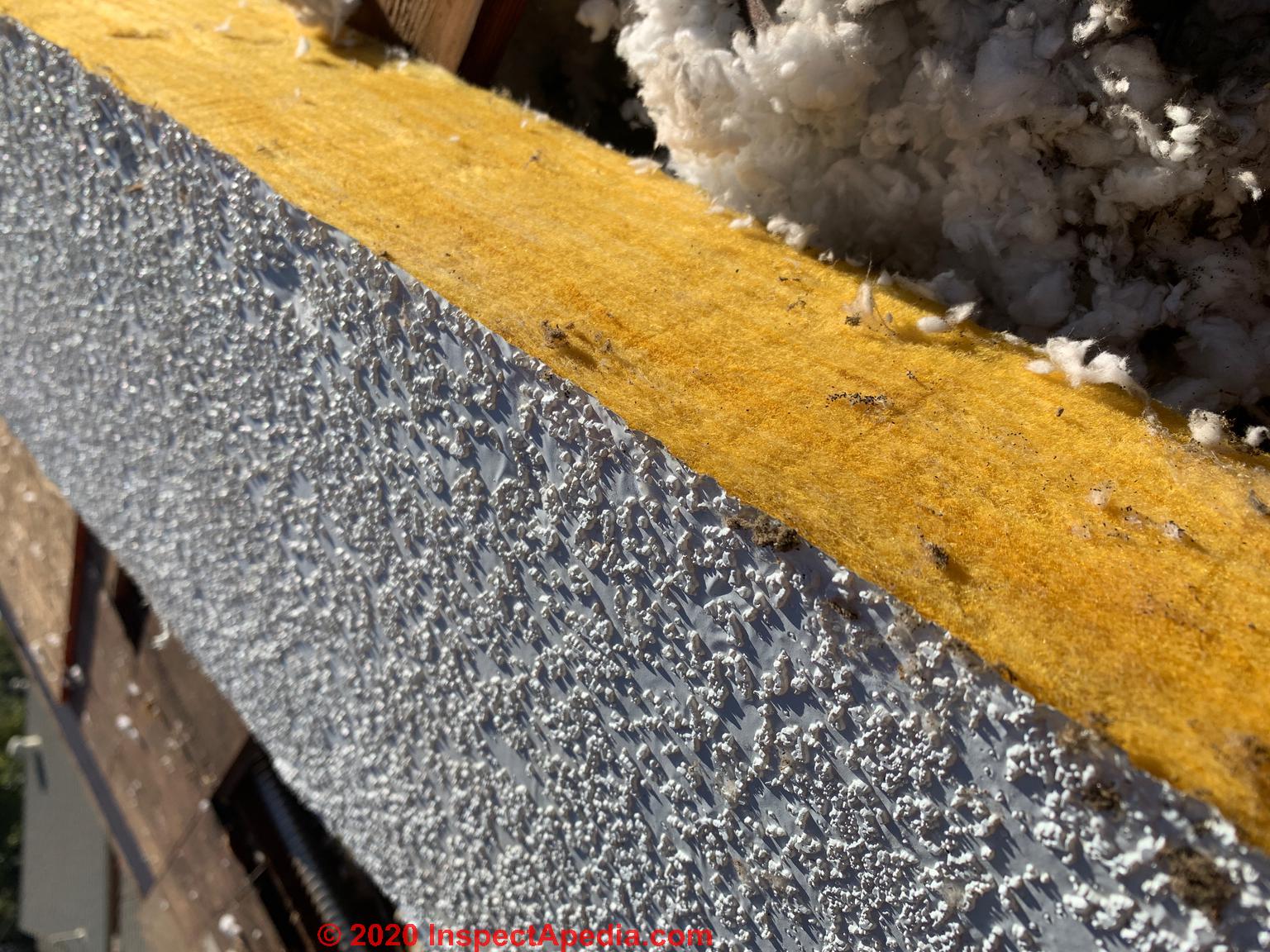 What brand of roofing insulation is this used in Northern California?
What brand of roofing insulation is this used in Northern California?
-On 2020-10-17 by Stefani
Reply by (mod) - Yellow "board" fiberglass & similar insulating board products used on roofs or on building interior or in suspended ceilings
I don't recognize that specific insulating board, Stefani but the thin pebbled plastic finish surface showing in your photo looks to me more like it was intended to be exposed on the building interior.
Is this a dense fiberglass panel with a plastic skin? That's what your photo looks-like.
What does the other side look like?
Are there any imprints of trademarks or text or numbers?
A number of companies make insulating panels used on roofing; we need to start by being sure we know the material and to be sure we've properly identified its intended use.
If it's fiberglass you might ask Owens Corning.
...
Thank you to our readers for their generous comments:
On 2021-02-05 by John - your site has been a wealth of information
Just wanted to say thanks for the reply. I do appreciate it, and your site has been a wealth of information as I've looked through it! Thanks!
On 2021-02-05 - by (mod) -
Thank you John, we have worked hard on InspectApedia.com's data for nearly 25 years so I'm particularly grateful when readers find the site useful. Your questions, comments, and criticism also are always welcome and always helpful.
On 2020-09-11 by Mike M. - This site is one of the most useful resources on the internet!
Thanks for taking the time [to answer our question in detail]. This site is one of the most useful resources on the internet!
On 2020-05-07 by Carol
Thank you very much! I really appreciate your thoughts and time. Carol
...
Continue reading at INSULATION IDENTIFICATION GUIDE - topic home, or select a topic from the closely-related articles below, or see the complete ARTICLE INDEX.
Or see INSULATION IDENTIFICATION GUIDE - FAQs3 - more photos and identification Q&A on insulation identification
Or see these
Recommended Articles
- CARBON NANOTUBE MATERIALS
- FIBER & HAIR IDENTIFICATION
- FOAM BOARD INSULATION TYPES
- FOAM SPRAY INSULATION TYPES
- INSULATION IDENTIFICATION GUIDE - topic home for all types of insulation found in buildings or building products
- INSULATION INSPECTION & IMPROVEMENT - inspecting and improving the level and effectiveness of insulation in buildings, advice on troubleshooting insulation problems.
Suggested citation for this web page
INSULATION IDENTIFICATION by COLOR / TEXTURE FAQs at InspectApedia.com - online encyclopedia of building & environmental inspection, testing, diagnosis, repair, & problem prevention advice.
Or see this
INDEX to RELATED ARTICLES: ARTICLE INDEX to BUILDING INSULATION
Or use the SEARCH BOX found below to Ask a Question or Search InspectApedia
Ask a Question or Search InspectApedia
Try the search box just below, or if you prefer, post a question or comment in the Comments box below and we will respond promptly.
Search the InspectApedia website
Note: appearance of your Comment below may be delayed: if your comment contains an image, photograph, web link, or text that looks to the software as if it might be a web link, your posting will appear after it has been approved by a moderator. Apologies for the delay.
Only one image can be added per comment but you can post as many comments, and therefore images, as you like.
You will not receive a notification when a response to your question has been posted.
Please bookmark this page to make it easy for you to check back for our response.
IF above you see "Comment Form is loading comments..." then COMMENT BOX - countable.ca / bawkbox.com IS NOT WORKING.
In any case you are welcome to send an email directly to us at InspectApedia.com at editor@inspectApedia.com
We'll reply to you directly. Please help us help you by noting, in your email, the URL of the InspectApedia page where you wanted to comment.
Citations & References
In addition to any citations in the article above, a full list is available on request.
- In addition to citations & references found in this article, see the research citations given at the end of the related articles found at our suggested
CONTINUE READING or RECOMMENDED ARTICLES.
- Carson, Dunlop & Associates Ltd., 120 Carlton Street Suite 407, Toronto ON M5A 4K2. Tel: (416) 964-9415 1-800-268-7070 Email: info@carsondunlop.com. Alan Carson is a past president of ASHI, the American Society of Home Inspectors.
Thanks to Alan Carson and Bob Dunlop, for permission for InspectAPedia to use text excerpts from The HOME REFERENCE BOOK - the Encyclopedia of Homes and to use illustrations from The ILLUSTRATED HOME .
Carson Dunlop Associates provides extensive home inspection education and report writing material. In gratitude we provide links to tsome Carson Dunlop Associates products and services.



